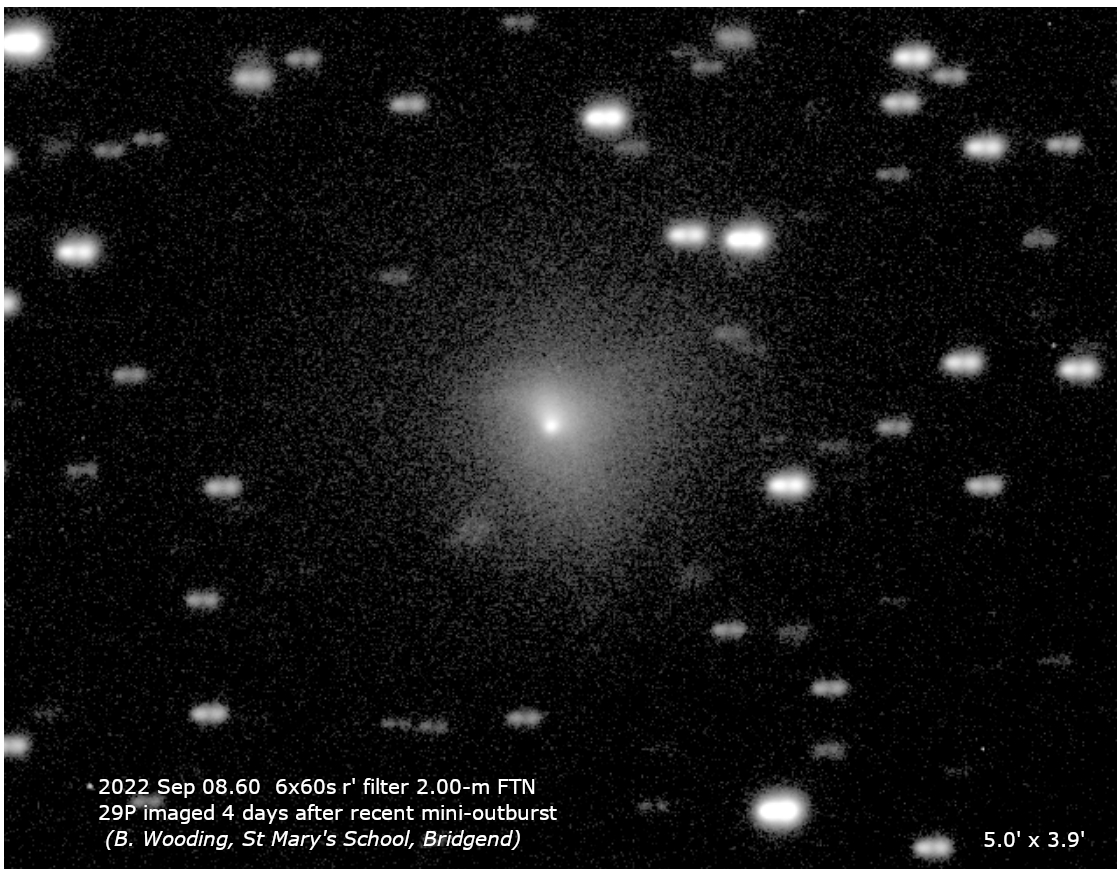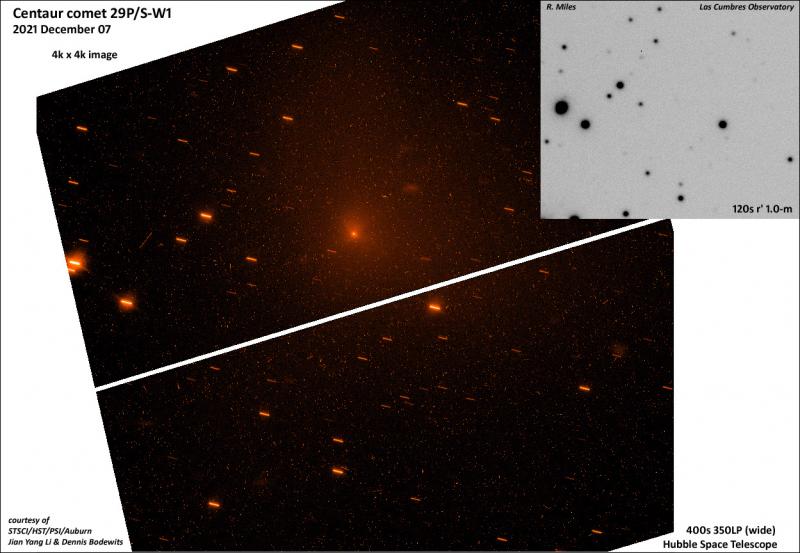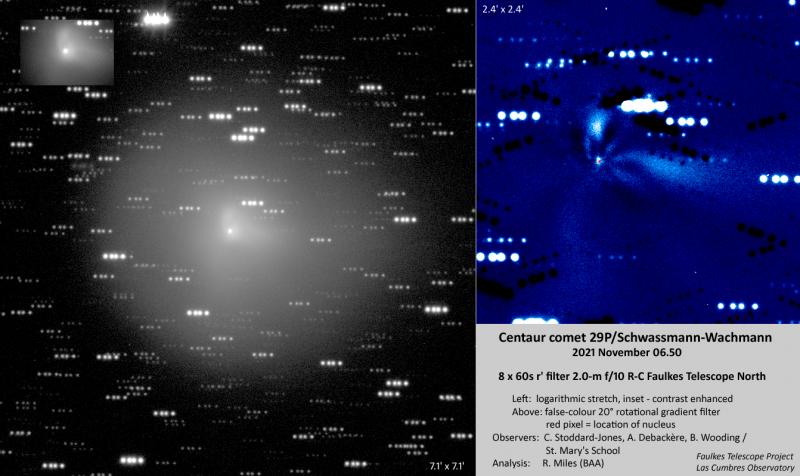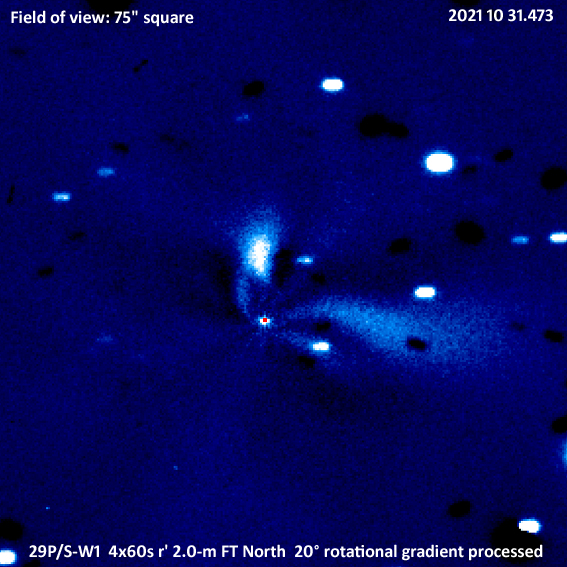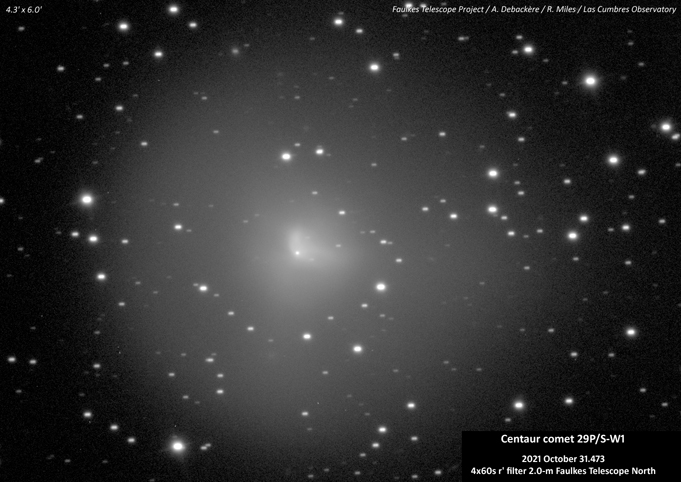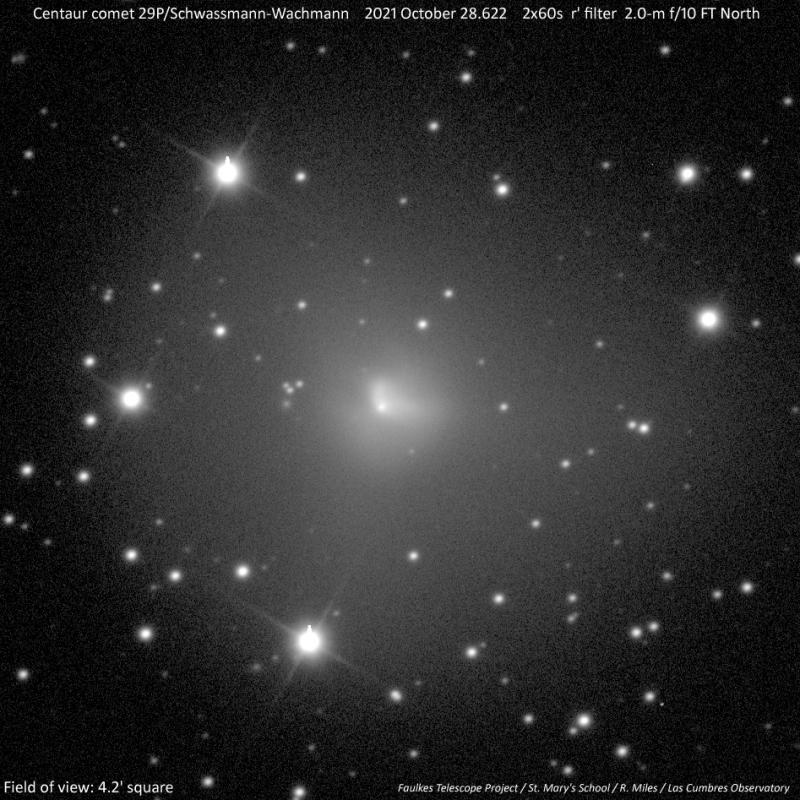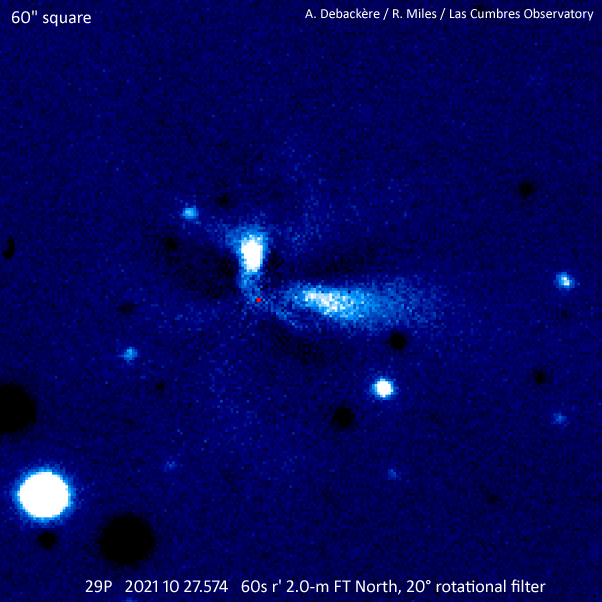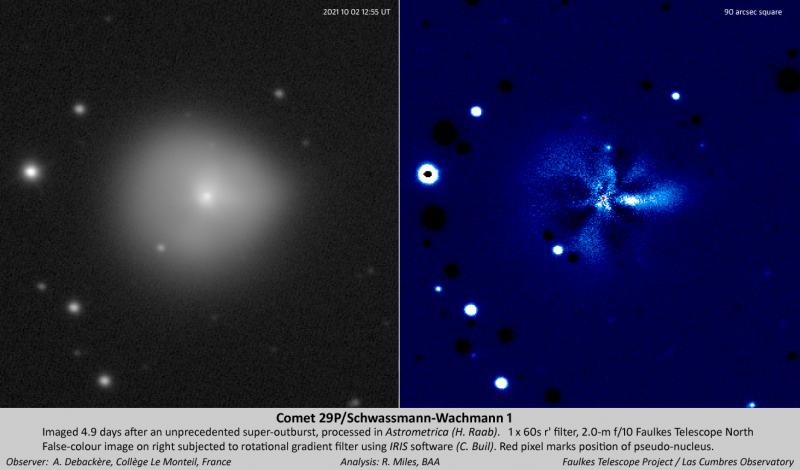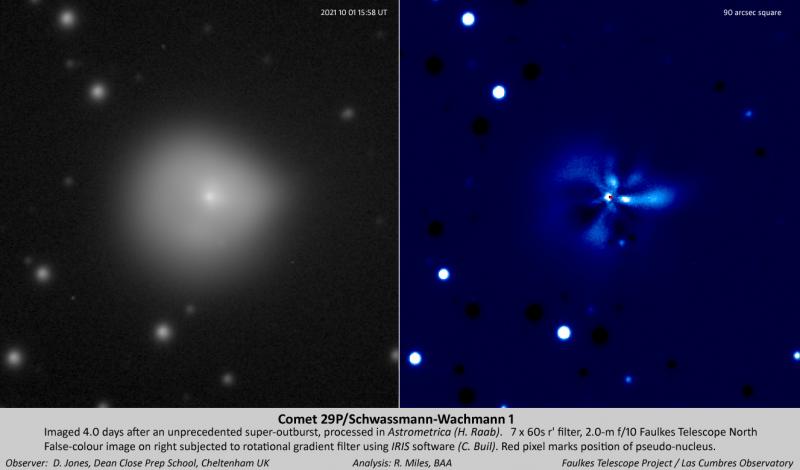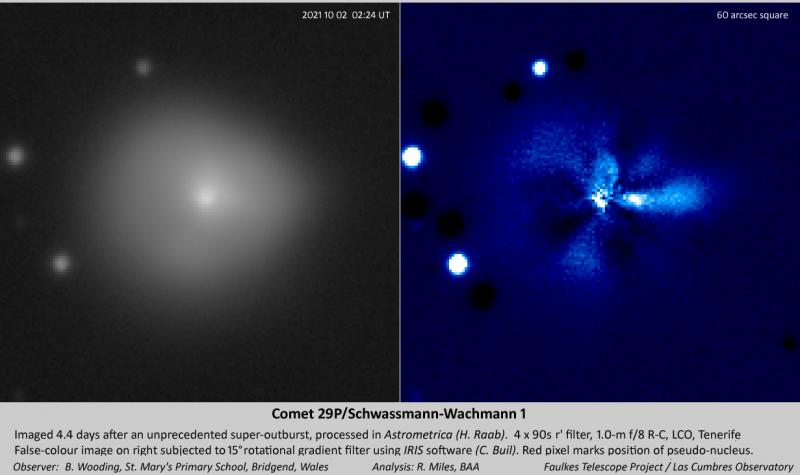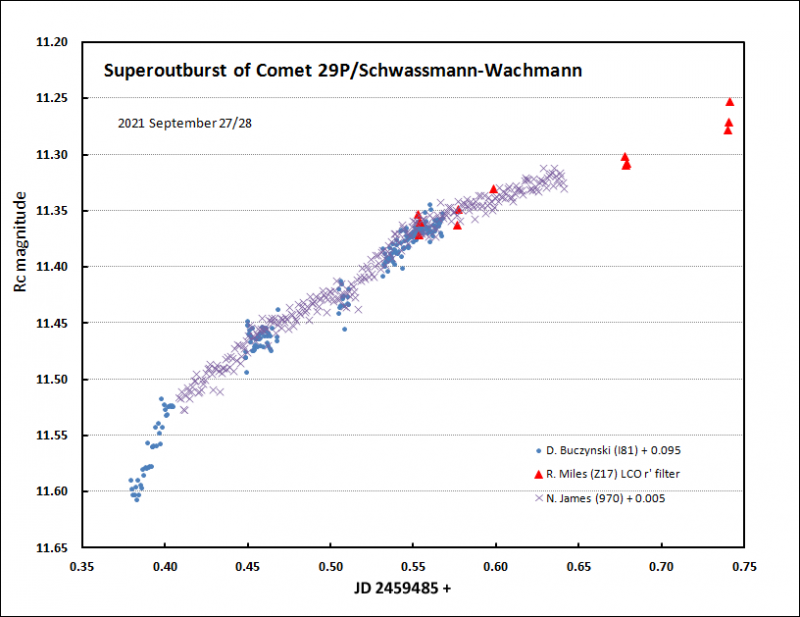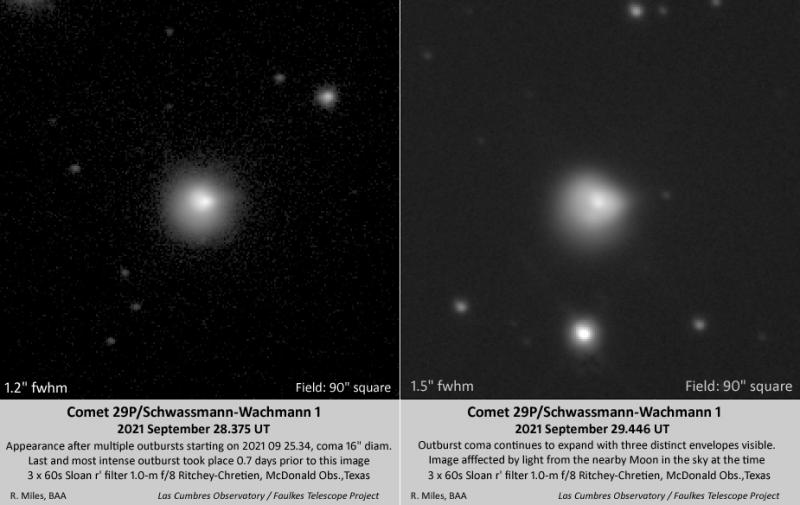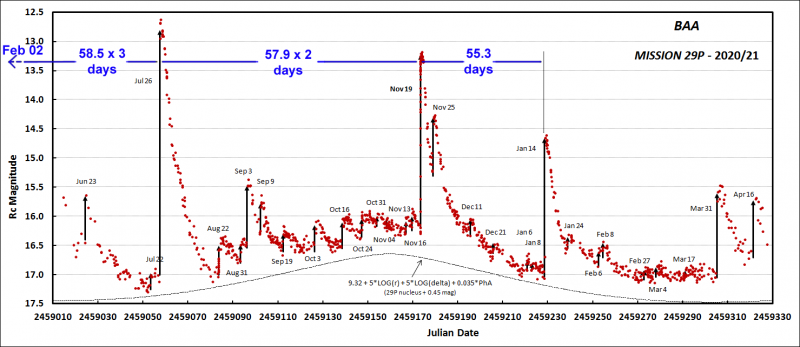MISSION 29P – Centaur comet observing campaign news and archive
Last outburst at 2025 12 11.02 ± 0.31 15.22R => 13.09R
<= Back to MISSION 29P Homepage
2025 December 16/17: Expanding outburst coma from triggered eruption
This second event has produced a typical fairly hemispherical type of expanding coma, which we see in the case of strong outbursts. This one generated dust reflecting 81x as much sunlight as the bare nucleus. If the intensity of the eruption was say 2 or 3 times this then the coma would most likely have been spherical because the internal gas pressure within the expanding dust cloud would still be inflating / accelerating the particles after the cloud had exceeded the size of the nucleus (60 km across). It is also useful to compare this dust cloud to the one from the rather weaker event that took place 6 days earlier (see image below). That had more structure, was less hemispherical but appeared to emanate from roughly the same p.a. on the nucleus. Could it be that the initial vent froze over rapidly trapping sufficient gas-laden cryomagma that as the altitude of the Sun continued to rise over the site it further heated the subsurface, releasing more dissolved gas and increasing the gas pressure within the reservoir cavity until the vent re-opened. It’s a much better model than hypothesising that some ejecta crash landed back onto the surface fracturing the crust at some other place on the nucleus.
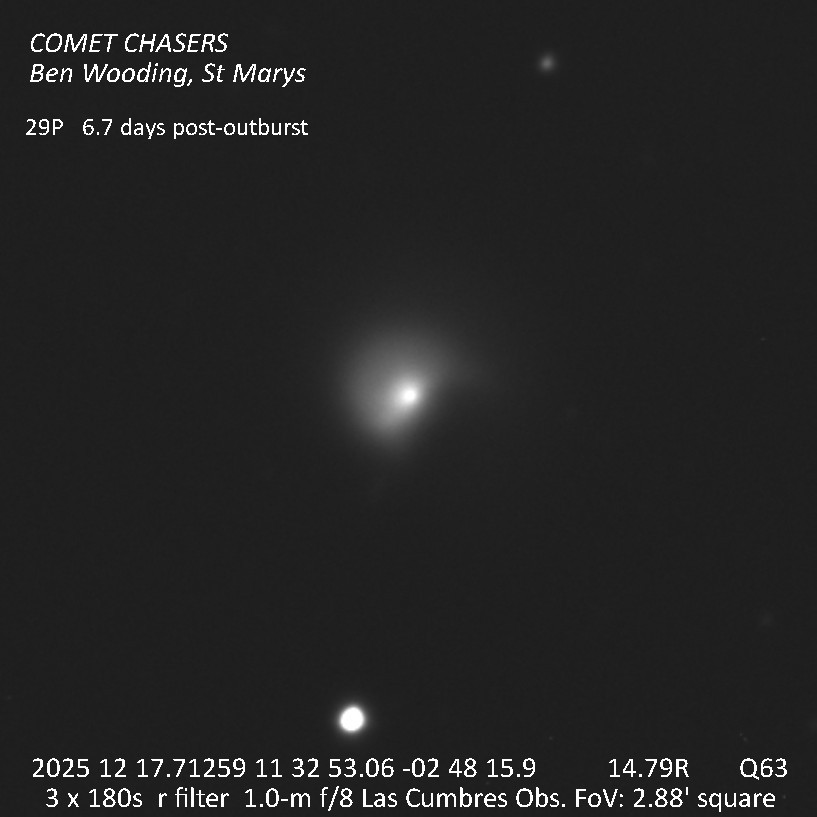
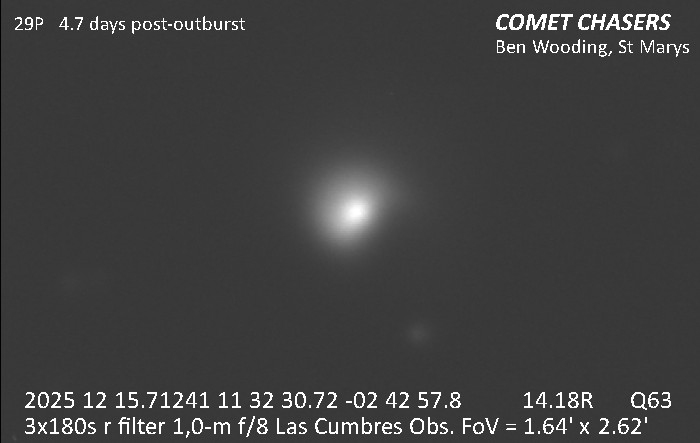
2025 December 11: Second, even stronger outburst of the new apparition
Just 6 days after the previous eruption on the nucleus, we have just witnessed a second event that has attained magnitude 13.1R making this a triggered strong outburst. The last one reaching this intensity was in 2025 February. Thanks to John Drummond imaging from Possum Observatory, New Zealand, we have tied down the time of the eruption to within ±8 hours. Looking at the rotational phase I am surprised it has happened rather late n the day to what was expected unless the rotation period of the nucleus has slowed by almost 0.2%. We won’t know properly until we reach the end of the current apparition.
2025 December 08: Comet Chasers catch the coma structure
Four days after the sudden outburst, Comet Chasers Ben Wooding and pupils of St Marys School, Bridgend, Wales used a 1.0-m telescope of the Las Cumbres Observatory network in Siding Spring, Australia to image the expanding coma in good seeing. This is an example of what looks like a spiral structure that has, in the past, been interpreted as being caused by rotation of the nucleus. This is not the case here because the ‘spiral’ shape of the outburst does not evolve with time – instead it only grows larger in size as the ejecta travel away from the nucleus maintaining a constant velocity (speed and direction of travel). Let’s wait a few days for it to expand more in size. A deep image of the coma taken with an amateur-size telescope obtained by stacking say at least 60 minutes of exposures, should confirm this ‘linear’ evolution of the coma shape and size.
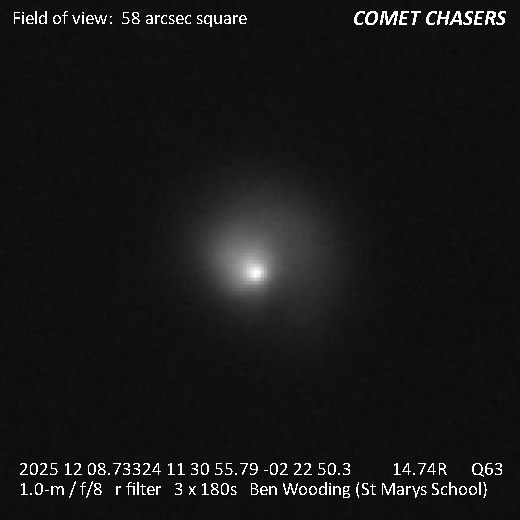
2025 December 04: First strong outburst of the new apparition
First strong outburst for over 6 months discovered by Jean-François Soulier from L27. Intensity 51 nucleus-equivalents. Rotational phase of 0.23 (57.71-day rotation period). If the nucleus behaves as it did one orbit of the Sun earlier, then we should not see another strong outburst before the start of 2026.
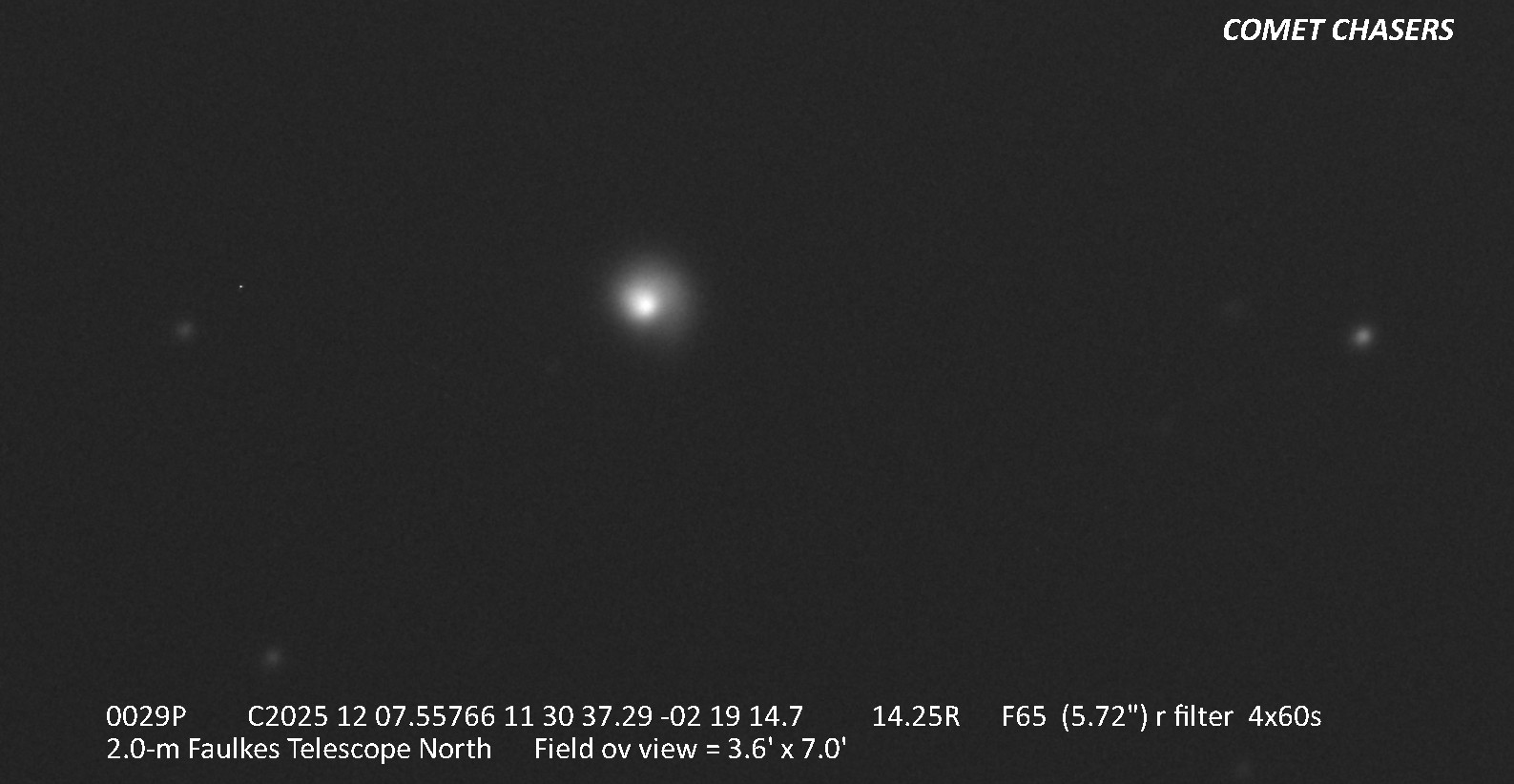
2025 November 29: Rapid fading – now approaching faintest on record
Since November 15 we have seen an unusual steep decline in brightness indicative of a marked drop in the background activity of the nucleus, which continues in the absence of outbursts. Currently it has reached 17.4R. Here’s a close-up of the recent photometry:
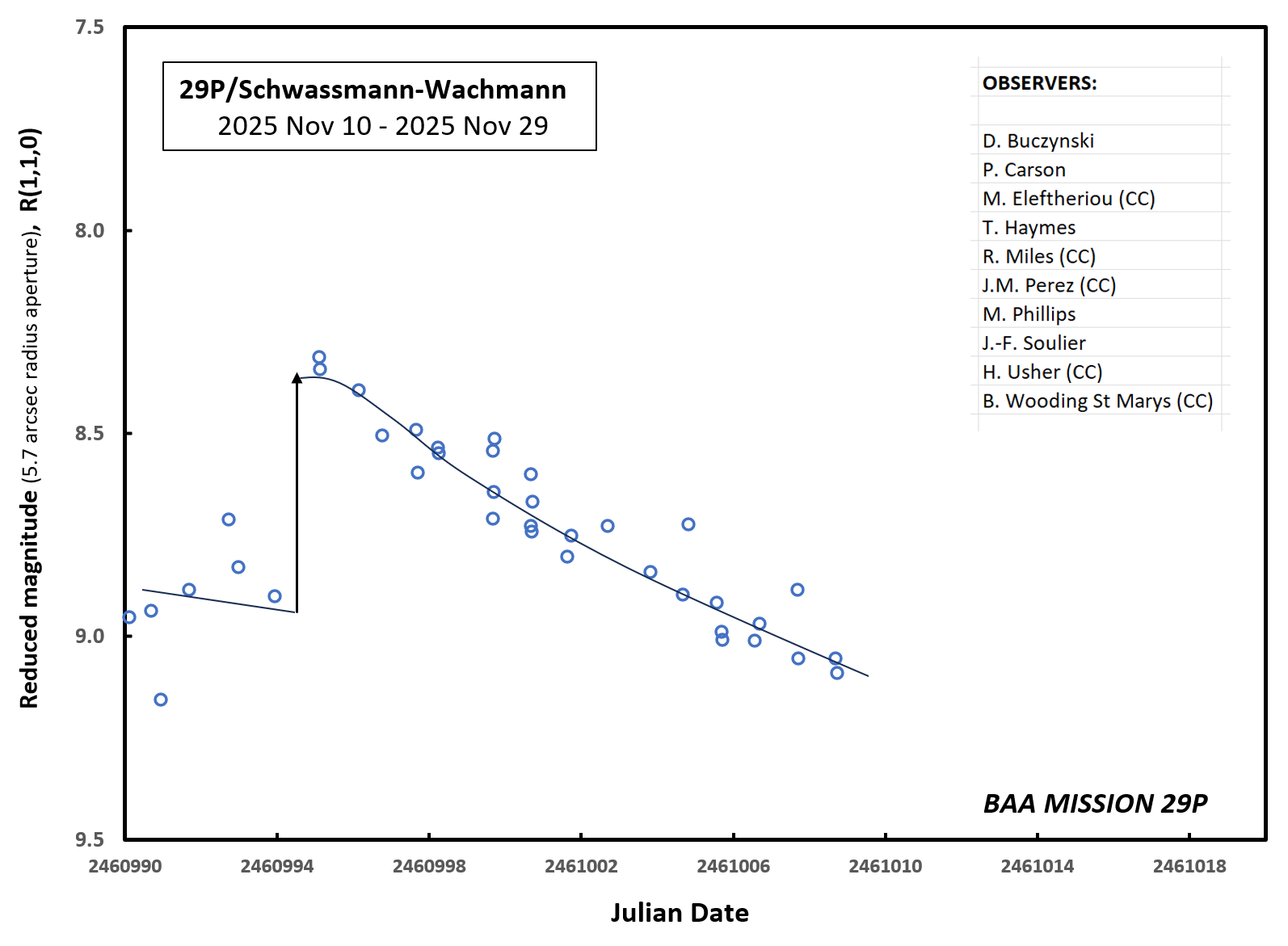
2025 November 22: Progress report
We have now obtained 51 days’ coverage or >90% of a complete revolution of the nucleus and only one weak outburst. Rotational phase is currently 0.07.
2025 November 15: First outburst of the 2025‒26 apparition
It has been a 45-day wait to witness the first cryovolcanic eruption of the nucleus – a 0.6 mag amplitude event / intensity of 1.5 nucleus-equivalents, which puts it in the ‘weak’ or mini-outburst category. It took place at a rotational phase of 0.94 based on a 57.68-day synodic period. The most active region equates to the phase range, 0.85‒0.25. Details are: 2025 11 15.02 ± 0.47 17.35R => 16.74R
Here are some 2.0-m images depicting this latest outburst thanks to Helen Usher and Peter Snowden, who obtained the first high-res images of the quiescent nucleus (lower frame) taken about 4 days before this weak event. The pre-outburst imaging was scheduled via the Las Cumbres Observatory network on November 8 at the BAA’s Back-to-Basics meeting in Pontefract, UK.
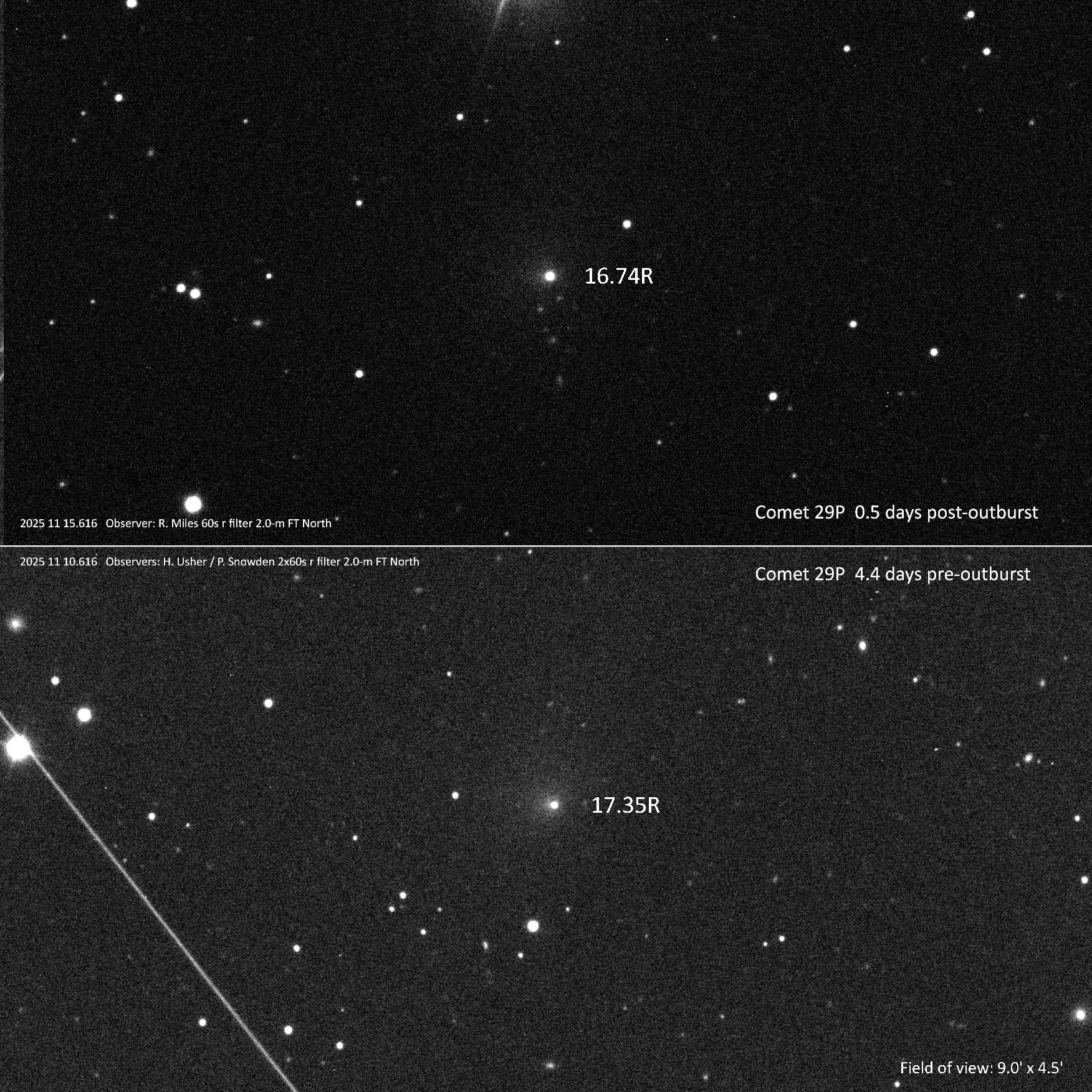
2025 November 13: Start of the 2025‒26 apparition. Comet essentially quiescent for the past 43 days
Observations of 29P for its 2025‒26 apparition are now underway. Jean-François Soulier obtained the first images on 2025 October 01.19 showing the comet in a quiescent state around 16th magnitude or fainter. The solar elongation at that time was 23.5°. Its magnitude is currently 17.25R and the nucleus is at a rotational phase of 0.91.
The next outburst is expected between rotational phases 0.8 to 0.3 – although there is a chance it will miss one rotation before an outburst takes place. The coming few months will help us confirm the proposed rotation period of 57.7 days based on its behaviour during 2010 to 2014. It is now EXACTLY one orbit of the sun after Epoch 2011.00. During the 6 months after this epoch in 2011, there were 6 strong outbursts detected all within the narrow rotational phase of 0.85‒0.25. If again the strong outbursts all take place from one side of the nucleus, we shall be able to confirm and refine the earlier estimate of its rotation period.
Observers totals for the 2024‒25 apparition
Coverage of the latest apparition was completed with the last observations on 2025 July 24.70. The last outburst was detected on 2025 Jul 04.46±0.40 – a very weak event having an intensity of 0.9 nucleus-equivalents. Thanks to our dedicated observers, we have amassed photometry on 1364 epochs, which is our best total to date. A link to the textfile of the observations is included near the foot of this page, or click HERE. The total number of epochs each person observed, along with the various observatories each used, are listed below. Congratulations and thanks go to all the observers, all 44. Pepe Manteca leads the totals, which is especially commendable given that Pepe used iTelescope for all of his imaging. MISSION 29P is particularly grateful to the Las Cumbres Observatory, The Schools’ Observatory and the 12 Comet Chasers (Faulkes Telescope Project), who scheduled and successfully imaged 29P.
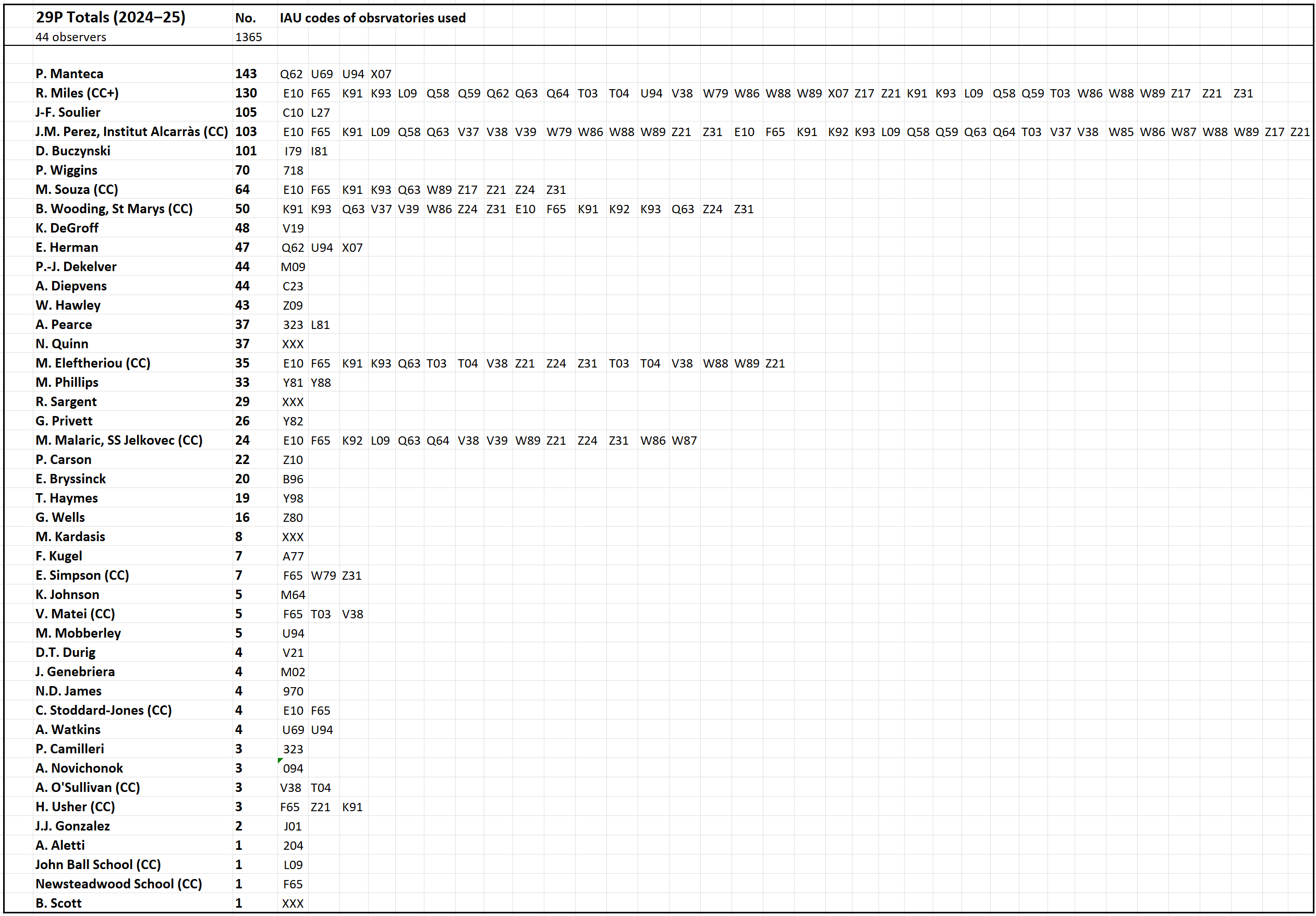
2025 Jun 25: Mini-outburst
Intensity = 1.0 nucleus-equivalents.
2025 Jun 04: New strong outburst
Intensity = 10 nucleus-equivalents.
2025 May 25: New strong outburst
Intensity = 32 nucleus-equivalents.
2025 May 13: Artyom Novichonok (094 Simeiz) discovers first strong outburst since exactly 100 days ago
This event had an intensity of 53 nucleus-equivalents compared with the previous strong outburst on February 02.4 exactly 100.0 days earlier, which had an intensity of 66 n.-e.. These two events happened at rotational phases of 0.72 and 0.99, respectively. Well done, Artyom and welcome back to MISSION 29P!
2025 May 06: New mini-outburst in image from Andrew Pearce (L81)
This is the 12th mini-outburst in the past 92 days.
2025 April 30: Four faint mini-outbursts!
Outburst intensities of 0.35, 0.45, 0.51 and 0.33 nucleus-equivalents on April 04, April 15, April 24 and 2025 April 30.
2025 March 29: Mini-outburst discovered by Jean-François Soulier
1.9 nucleus-equivalents. See plot below.
2025 March 21: Mini-outburst
3.6 nucleus-equivalents. See plot below.
2025 March 16: Mini-outburst
3.5 nucleus-equivalents. See plot below.
2025 March 12: Mini-outburst
New 0.6 magnitude amplitude cryo-eruption, intensity of 1.7 nucleus-equivalents. See plot below.
2025 March 8: Faint mini-outburst on 2025 March 06 first suspected by Jean-François Soulier
Occasionally 29P undergoes a particularly weak outburst, the latest having an amplitude of just 0.12 magnitudes:
2025 March 2: Stellar occultation update / Mini-outburst on 2025 March 01 discovered by Nick Quinn
The past 19 days have seen the pseudo-nucleus gradually fade from magnitude 14.8R to 16.5. Yesterday, thanks to Nick Quinn observing from Steyning in the UK, a 0.4-mag outburst was detected. Thanks also to Patrick Wiggins observing from Utah about 6 hours earlier we have been able to tie down the time of this step-change in brightness to an accuracy of 0.2 days.
On the occultation front, we have to thank Christian Weber and Dave Herald, who by chasing up some negative reports has managed to constrain the size and shape of the nucleus in a useful manner. Here’s a close-up view of the latest occultation chords. Still only one positive event. The path appears to have shifted roughly 170 km south of the predicted path. The two observers either side of the total occultation were Matthieu Conjat from Nice, France and Patrice Le Guen from Toulon, France. This result shows that the nucleus shape is far from being bi-lobal.
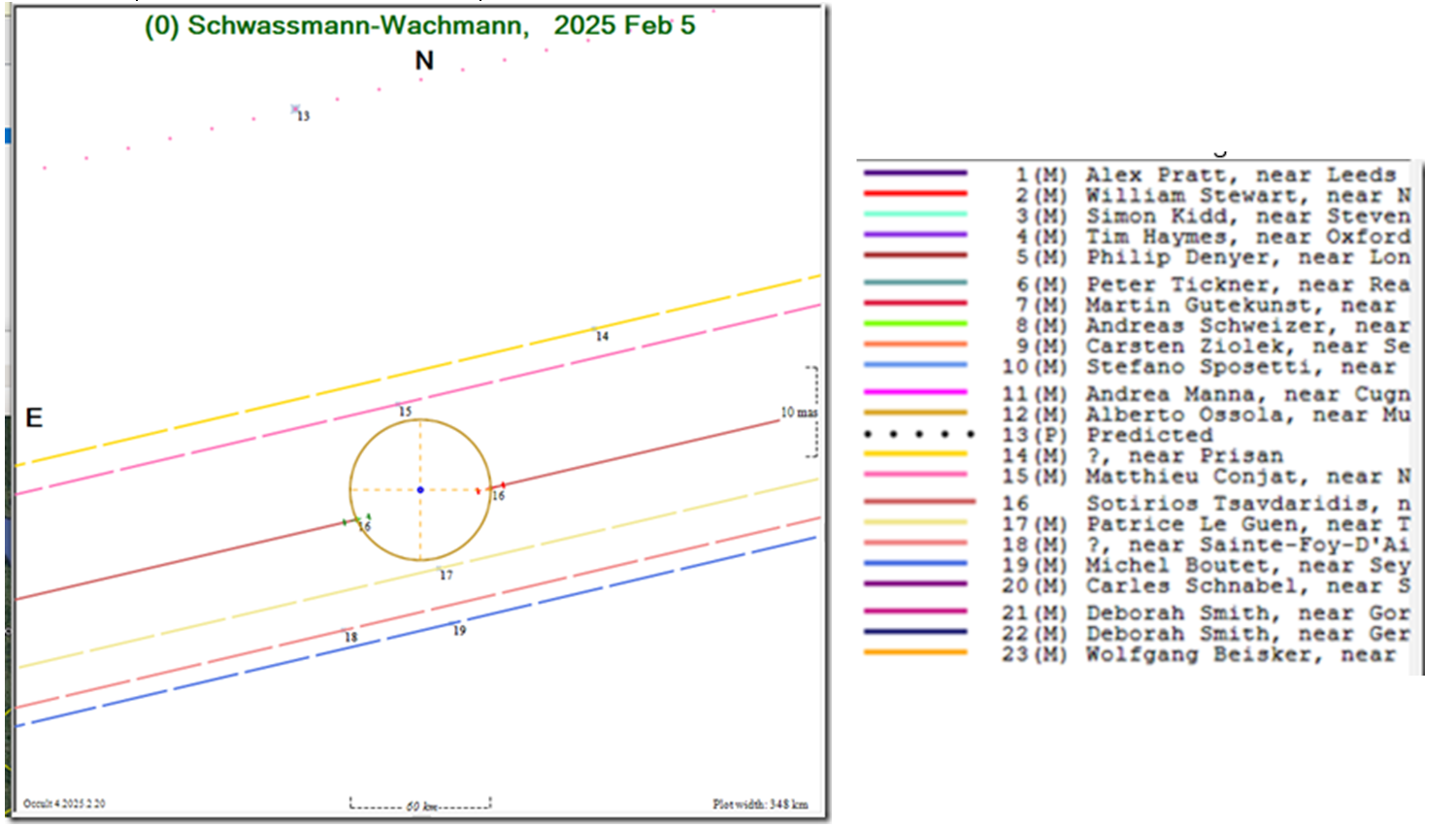
2025 February 15: Disappointing stellar occultation results / Mini-outburst on 2025 Feb 10
Only one positive occultation chord has been reported indicative of a solid body 60 km across. No evidence of obscuration from material in orbit several hundred km distance.
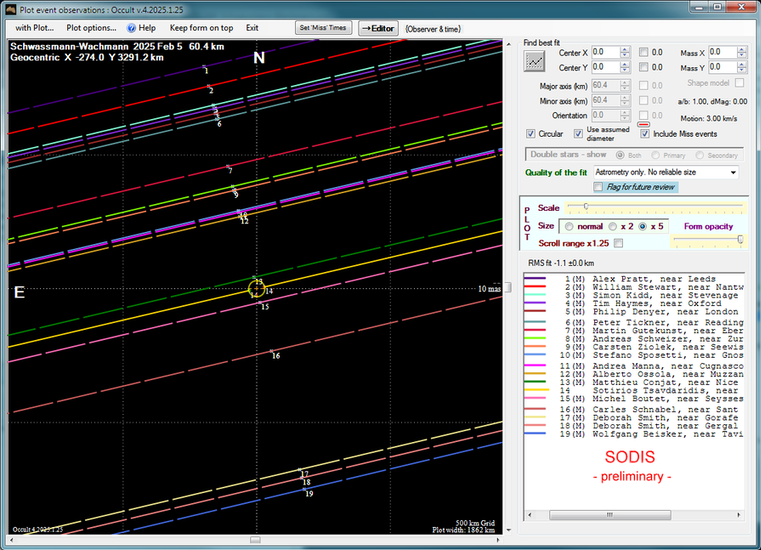
2025 February 03: T minus 2 days! Stellar Occultation by Comet 29P/Schwassmann-Wachmann on 2025 February 05 23:06-23:11UT
Here is an image showing the comet and the star to be occulted on the same frame.
29P currently has a total magnitude (24″ diameter aperture) of 12.29R and the occulted star magnitude is 12.89R, which corresponds to a total magnitude change of 0.49 mag. In a smaller aperture of 6″ diameter, the corresponding mag drop would be 0.94 mag if the occultation were to take place at the epoch this image was taken on (Feb 03.928). If no further outbursts happen then the coma will expand to more than twice its present size and so in a 6″ diam. aperture, the predicted observable change is expected to be close to 2.0 mag.
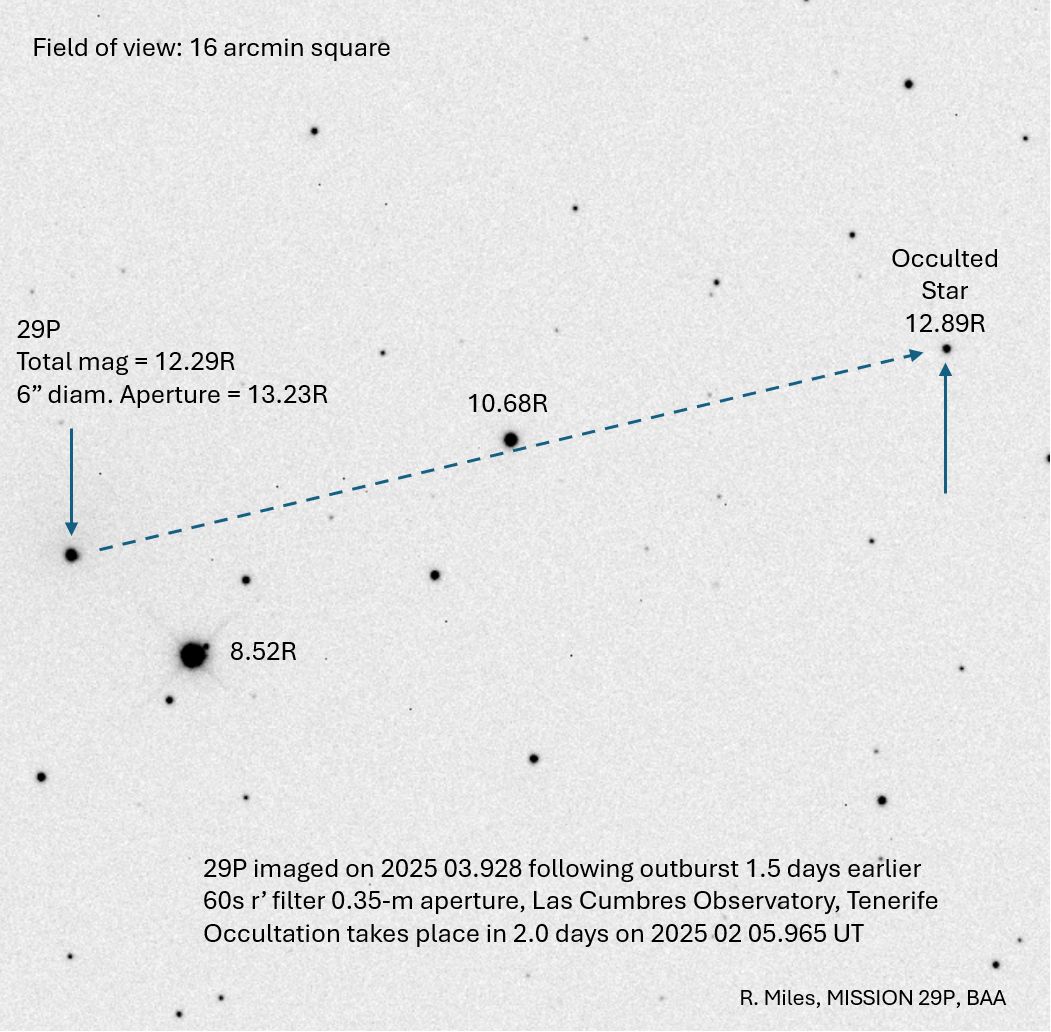
2025 February 02: T minus 3 days! Second strong outburst discovered by Marcelo Souza (see above)
2025 February 01: T minus 4 days! Strong outburst (2.5 mag amplitude) prior to the stellar occultation discovered by J-F Soulier
N.B. We expect all of the outburst coma to disperse before the occultation takes place unless ejecta material goes into a temporary metastable orbit around the nucleus.
2025 January 27: T minus 9 days! Stellar Occultation by Comet 29P/Schwassmann-Wachmann on 2025 February 05 23:06-23:11UT
An extremely rare stellar occultation of a 12th magnitude star in Leo by the nucleus of mysterious comet 29P/Schwassmann-Wachmann will take place on the evening of Wednesday 5th February 2025. The shadow track measures about 60 km across and will first pass over northern India including Delhi, Iran including Tehran, Türkiye including Istanbul, Bulgaria including Sofia, Bosnia, Italy including Bologna and Turin, and central France. Observers anywhere within 150-200 km of the central line are encouraged to observe as the actual path may shift north or south of the predicted region slightly and also either side of the shadow we may detect material, rings or lesser bodies orbiting the nucleus.
Details of the occultation are available at the Lucky Star Predictions webpage: https://www.lesia.obspm.fr/lucky-star/occ.php?p=146316
The comet undergoes outbursts, the last took place on 2025 January 21 and the outburst coma is currently fading. As the star is relatively bright at R magnitude 12.5 and the pseudo-nucleus of the comet is expected to be about R magnitude 16 at the time of the event, a positive occultation will result in a 25-fold drop in brightness or so.
The expected maximum duration of the event will be about 3.5 seconds so a telescope of 0.15-m aperture or preferably larger is recommended. Video cameras or fast frame-rate CMOS cameras are recommended to provide a permanent record of the event are best to be used. Absolute timing accuracy should be high (better than 0.2 sec if possible). Video cameras with GPS time insertion are particularly good. However since the track covers areas of high population, if many timing chords are obtained it will also be useful if an observation of the ‘duration’ of the occultation is obtained using manual timing to an accuracy of about 1 second or better.
Mobile observers working together in teams should establish observing locations each having about 3-5 km separation in the north-south direction. Permanent observatories within 100 km of the centreline are especially favoured.
These details with images have been posted on the BAA’s MISSION 29P News webpage at:
https://britastro.org/section_information_/comet-section-overview/mission-29p-2/mission-29p-centaur-comet-observing-campaign
An update of this note will be available closer to the time of this unprecedented opportunity.
Clear skies,
Richard Miles
British Astronomical Association (BAA)
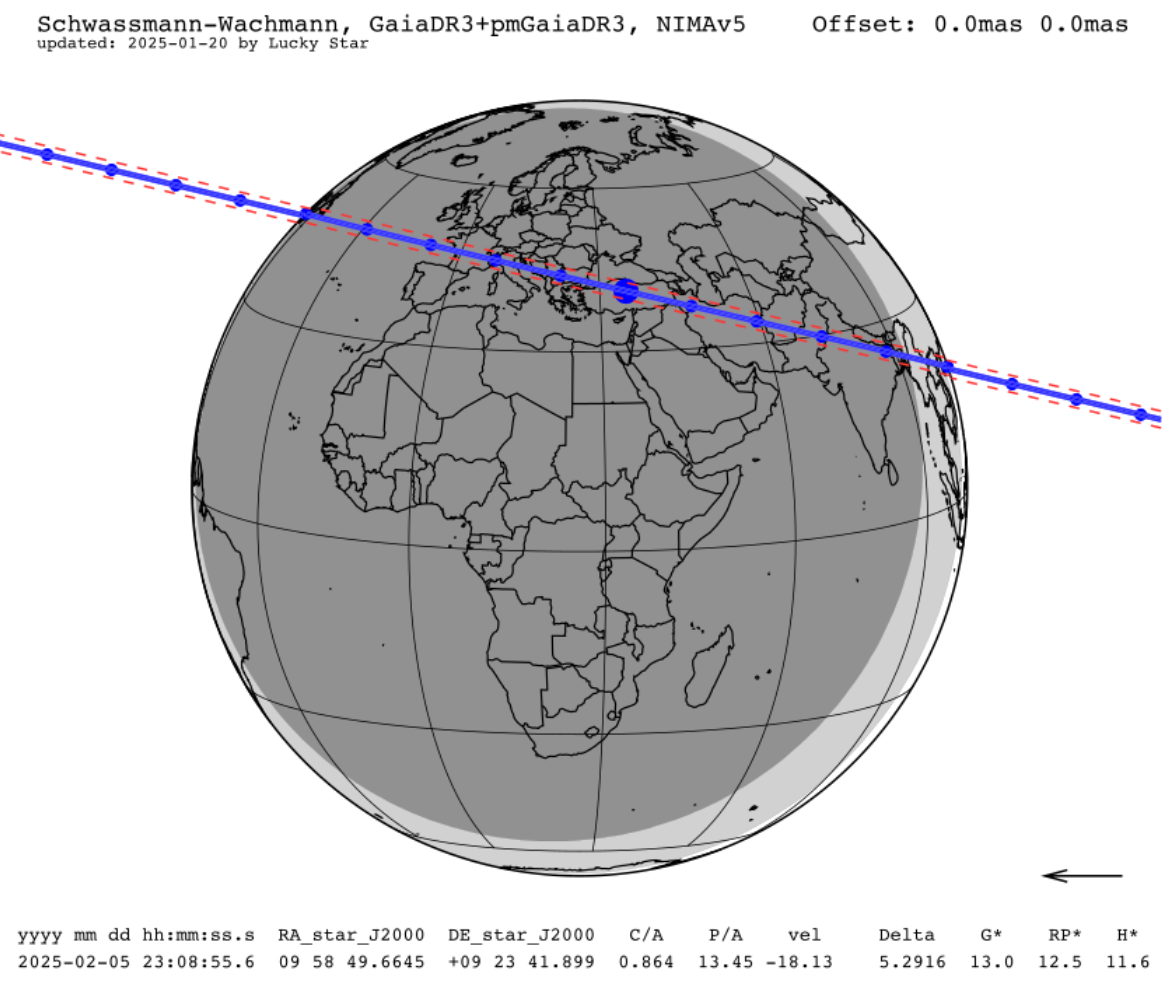
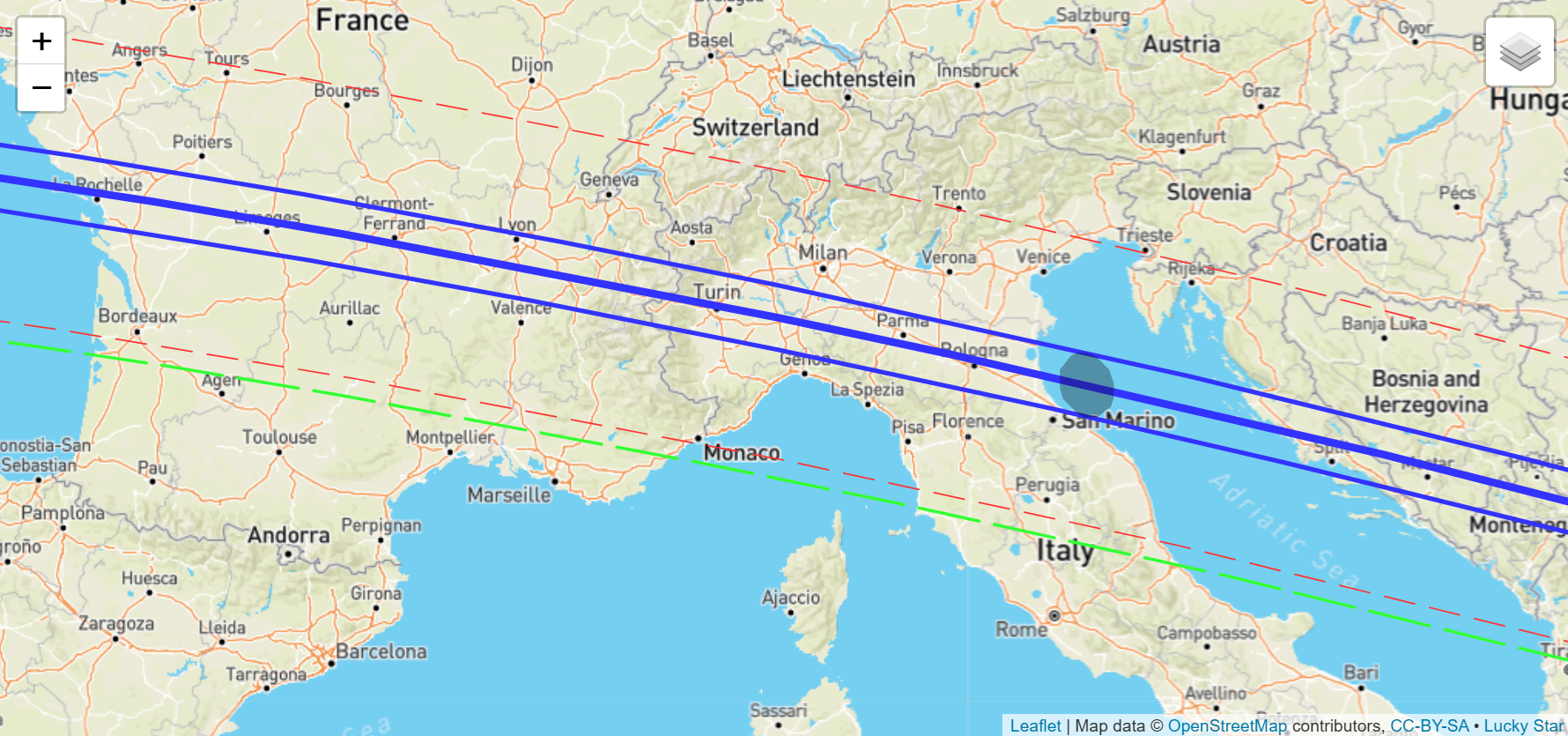
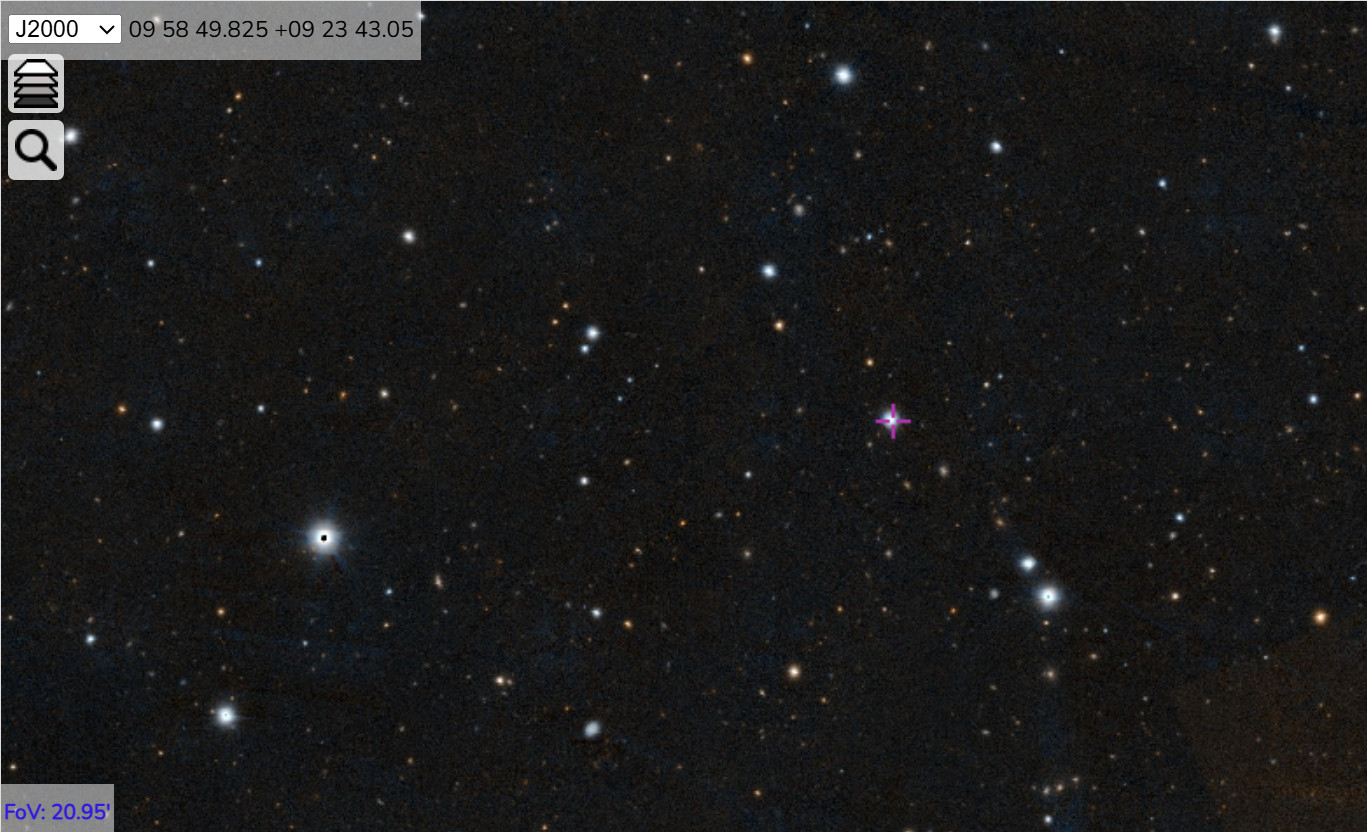
2025 January 21 — New outburst – Intensity 8 nucleus-equivalents
Detected by Denis Buczynski. See updated plot below.
2025 January 19 — New outburst – Intensity 11 nucleus-equivalents
COMET CHASERS observers, Marcelo Souza and José-Manuel Pérez have pulled off a first when they each scheduled the Faulkes Telescope North to image this bizarre object. The scheduler happened to take images about 2.7 hours apart and it turns out that after the first pair of 90-sec exposures were taken, the ‘comet’ underwent a strong outburst possibly within a few minutes. By the time a later image was obtained, the innermost coma had brightened by a factor or ten and remained at this maximum light (±0.03 mag) for at least the next 10 hours. It is a dramatic demonstration of the existence of a strong surface crust which can hold a significant pressure beneath it until one of its cryovolcanoes erupts. This eruption is clearly a singular and very short-lived event as the opaque outburst cloud expands into space becoming optically thin within about 2.0 hours. The MuSCAT camera showed that the inner coma was unusually blue PRIOR to the outburst (g’ ‒ z’ = +0.62 ±0.04, cf. typical values of +0.98 ±0.05), which may be evidence of more gas escaping than usual and being ionised by solar radiation in the approach to the eruption taking place. The BAA’s MISSION 29P has detected over 100 strong outbursts since 2014 and virtually ALL of the events appear to be sudden eruptions similar to what we see here. It is solid evidence that these are caused by cryo-eruptions.
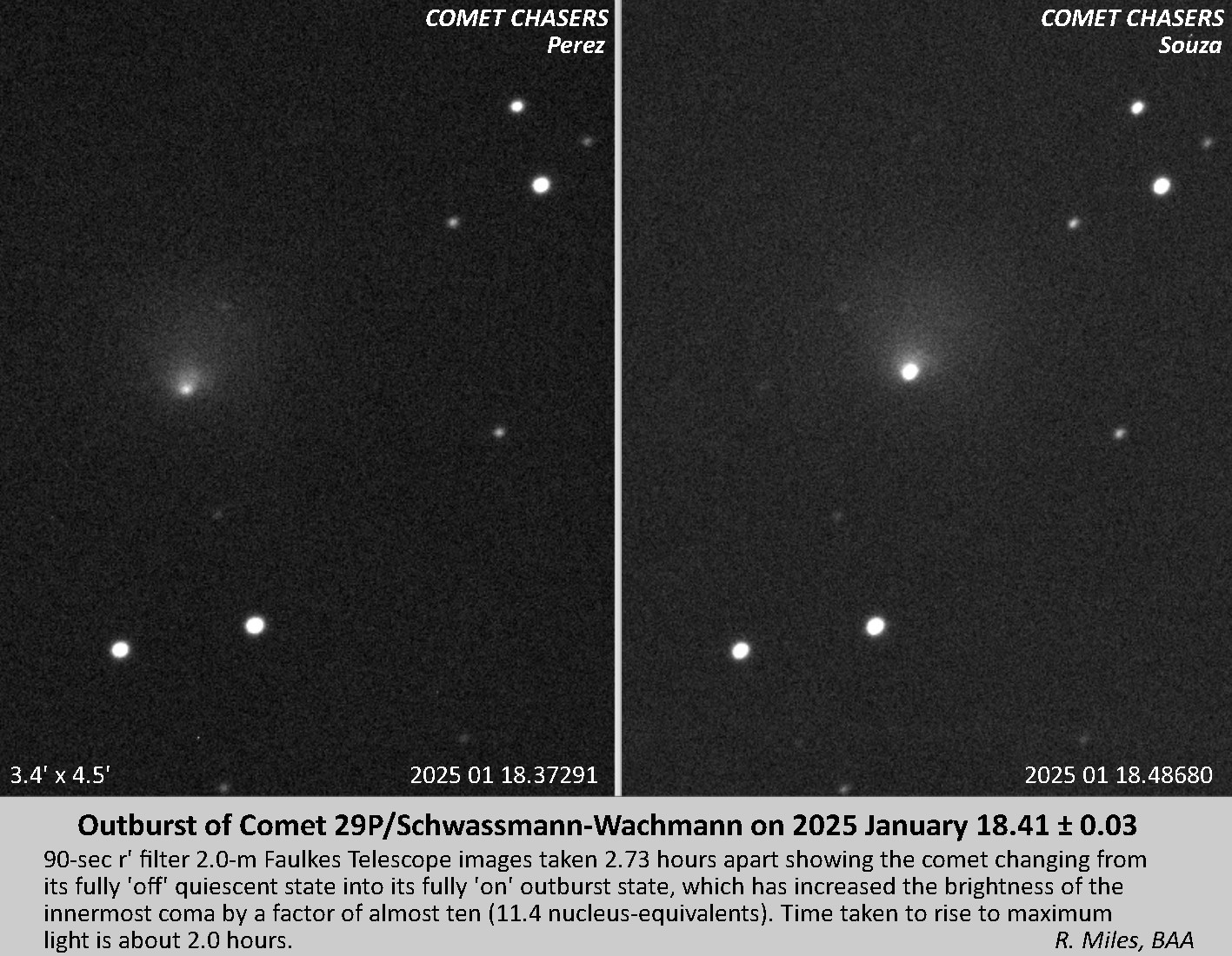
Here’s the updated lightcurve for 2025:
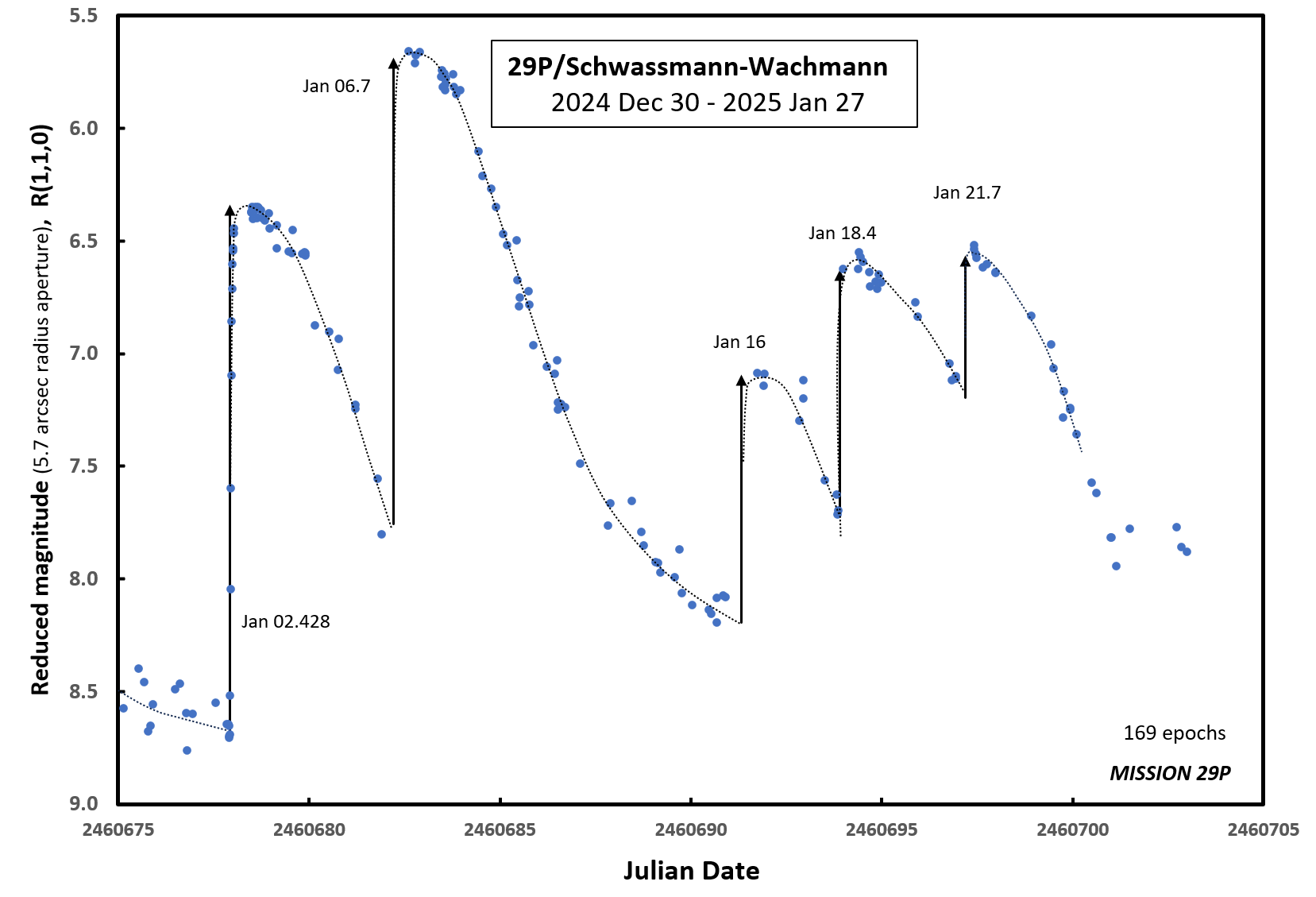
2025 January 16 — New outburst – Intensity 7 nucleus-equivalents
A small outburst detected.
2025 January 10 — Three-day-old outburst coma imaged by Comet Chasers
Hemispherical expansion coma is very obvious in the following 2.0-m image obtained by Mirjana Malaric.
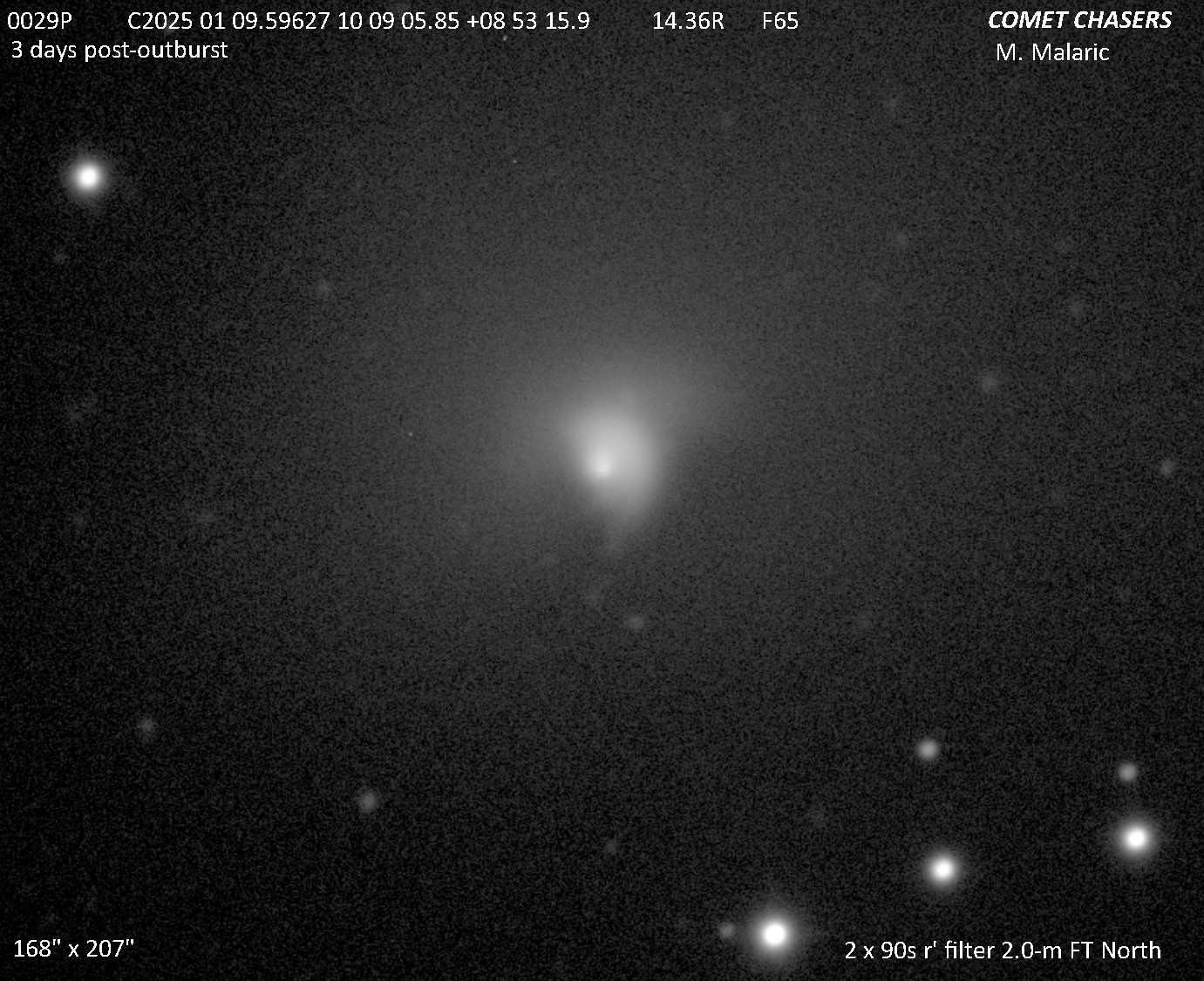
2025 January 8 — New strong outburst discovered by Andrew Pearce from Australia
This event happened during daytime in Europe and the U.S. Intensity looks to be 37 nucleus-equivalents. It occurred a little over 4 days after the previous strong outburst, which fits the typical behaviour of one strong outburst triggering one or more further strong events within a few days. So the last strong event was 30 days prior to this recent paired event. Then if we look at the previous 10 strong events, they all occurred within <3 days of each other – that’s a dramatic demonstration of strong eruptions triggering further ones. We are also looking at the possibility that one hemisphere is not exhibiting strong outbursts this apparition. If this pattern continues then it will be a repeat of the 2010‒2014 period on the nucleus, i.e. one orbit of the sun earlier. We shall see.
Here’s what the detailed Cousins-R lightcurve looks like so far in 2025:
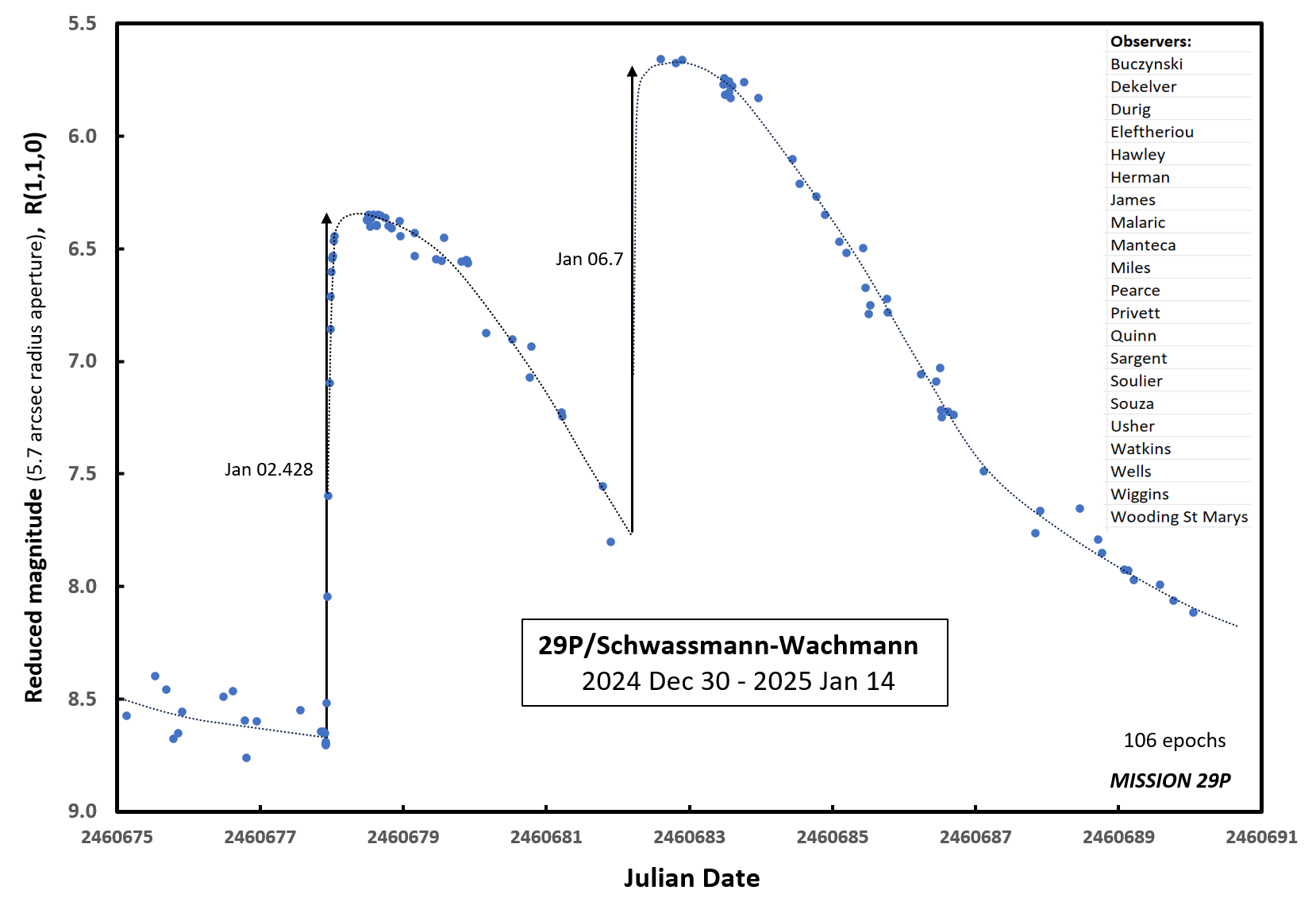
2025 January 3/4 — We have started the New Year well thanks to Doug Durig capturing a strong outburst
Here’s the preliminary lightcurve that speaks for itself. That’s two in a row that Doug has observed(see below for his November 21 lightcurve) and because it is a strong outburst we can see more detail in the shape. Fortunately, three COMET CHASERS observers also imaged the ‘comet’ using the 2.0-m Faulkes Telescope North just missing the very start by a few minutes. I suppose luck has to average itself out in the long run but it would have been nice to have a 2.0-m image say 10 minutes later. Note that the plot is a very preliminary one.
Several observers detected the comet was in outburst at the end of January 2, Wayne Hawley (Z09) being the first to alert MISSION 29P of the event.
We now have a close-up 2.0-m view of the resultant outburst coma just 2.0 days after the initial eruption thanks to three observers from the COMET CHASERS group:
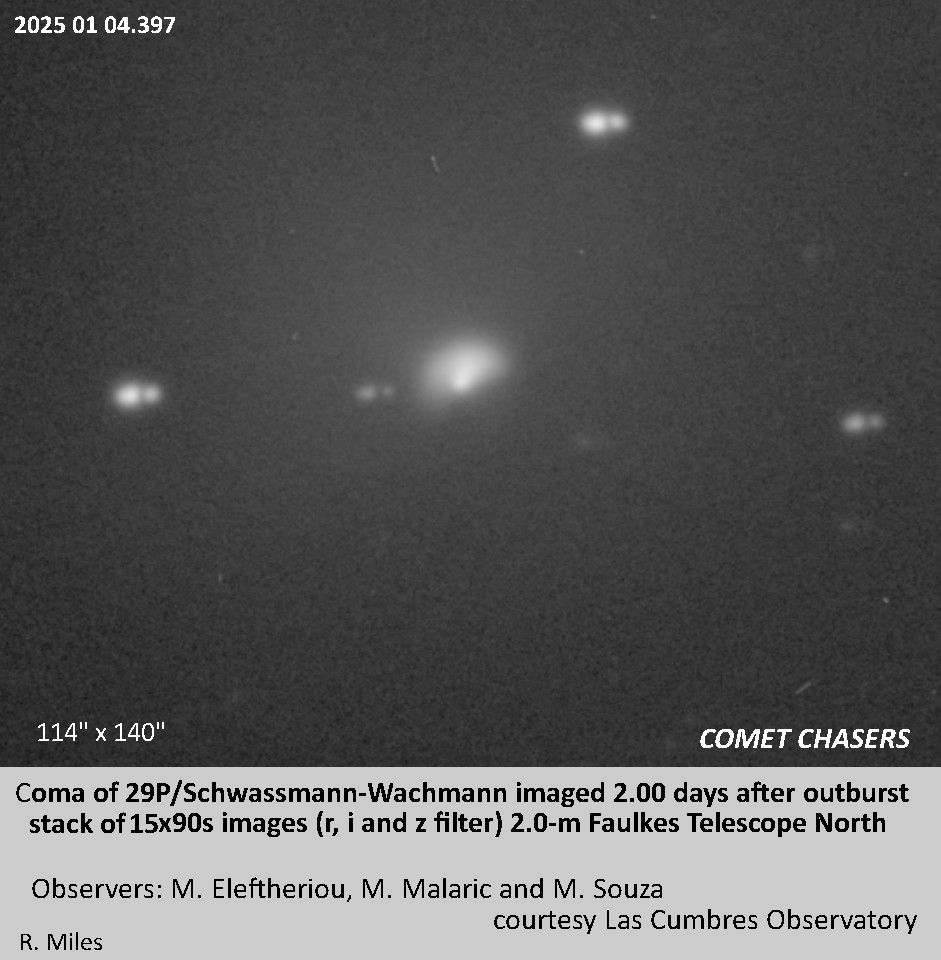
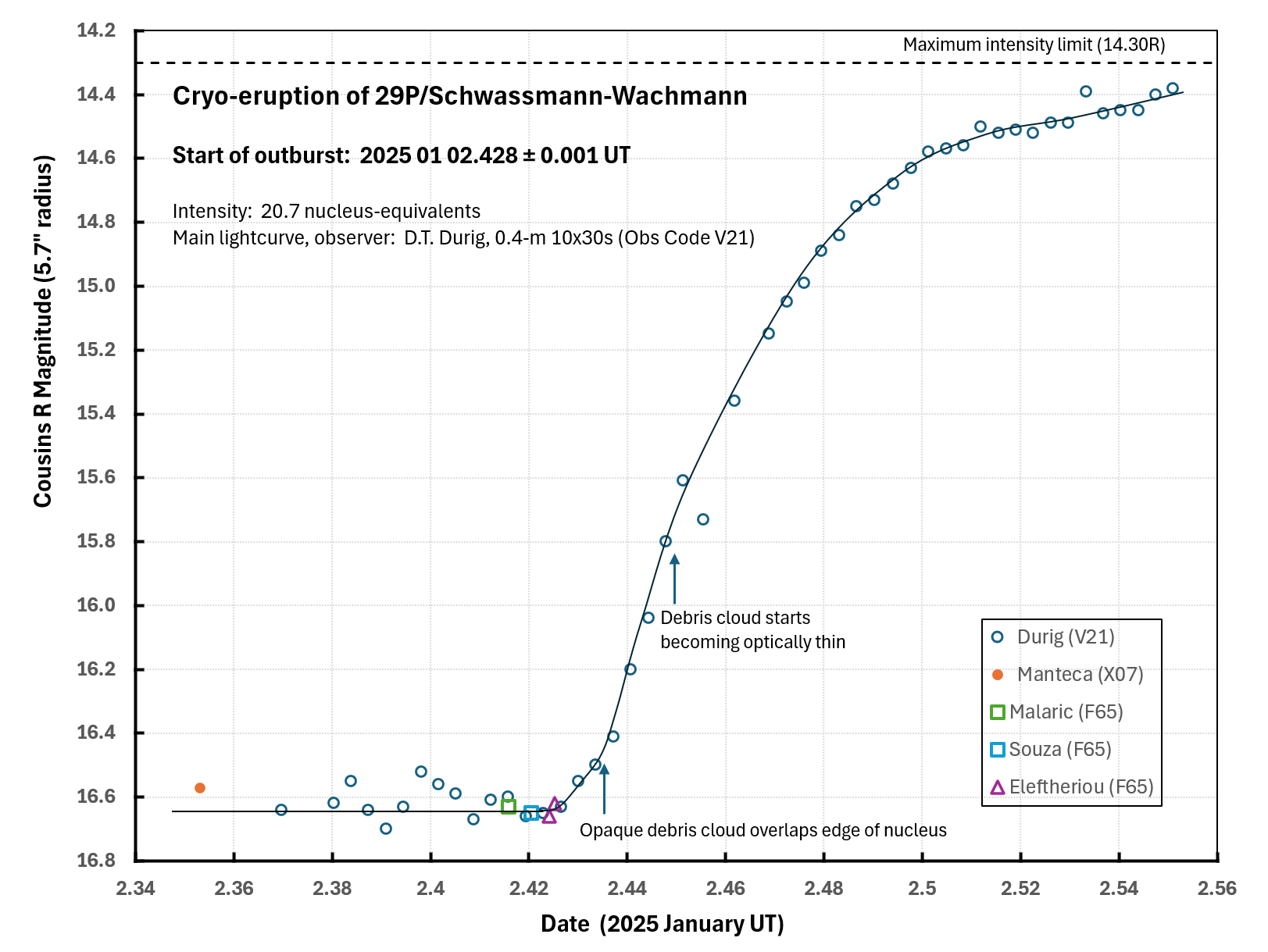
2024 December 24 30-day gap between outbursts
29P appears to have undergone a weak mini-outburst of amplitude 0.28 mag after a very long 30-day interval without any other significant outburst. That is the longest gap between consecutive outbursts that we have witnessed in almost 5 years of monitoring. The brightness increase was detected with the 2.0-m Faulkes Telescope North so we expect it to be confirmed when other images are taken tomorrow. The inner coma had faded to within 1.1 nucleus-equivalent, which is close to the faintest the 5.7″ radius coma reaches. More on this story later.
2024 December 11 – 17 days of continual fading of the outburst coma
There has not been any sign of a mini-outburst during the long fade interval. This looks to be a feature of mini-events so it will be particularly interesting how long this state of affairs continues.
Doug Durig has provided really good images covering the initial start of this latest multi-eruption, which began with a mini-outburst. Here is an initial photometric analysis of his images identifying the start time but which show another strong outburst beginning 1.9 hours later. Within a further 3.7 hours the brightness had reached magnitude 13.2 where it plateaued and remained for more than 12 hours. The shape of the mini-outburst rise fits that of other outbursts for which we see the rise from quiescence. Here the time to reach 50% maximum light is 0.02 hours, which value is very similar to the ”half maximum light times’ of other outbursts on their rise portion of their lightcurve. This suggests a very similar mechanism governs all these eruptions.
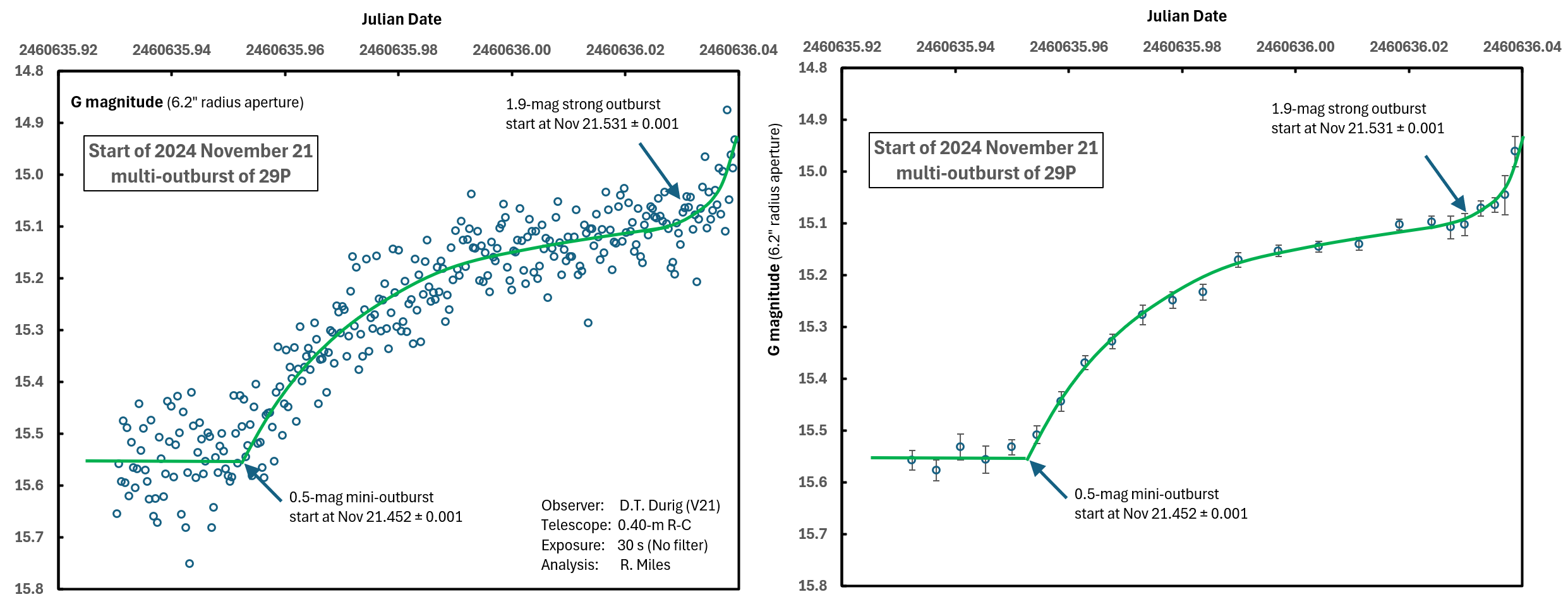
2024 November 27 – Update on multiple outbursts
The current coverage is very revealing in that at least 5 separate ‘kicks’ in the lightcurve have taken place over 3 days. We have yet to incorporate Doug Durig’s data showing the initial rise in brightness on the following lightcurve. A key finding from our photometry of the latest two sets of multi-outbursts this month is that in NO case do we see any gradual increase in brightness over say a day or two. Instead, every time the brightness displays a significant increase, it does so within about 2-3 hours of the initial start time during which the outburst coma has enough time to expand and become optically thin – in other words after 2 hours or so, the coma particles are sufficiently diluted in the increasing volume of space that they no longer shield one another from our view or from the Sun’s illumination. So an important conclusion of these latest studies (and the extensive preceding work) is that long-lasting cometary jets are virtually unheard of in the case of 29P, i.e. quite unlike the large majority of periodic comets. Low-level jet activity does appear to be the norm, as with many comets, but this only ever maintains a steady-state coma that is comparable in brightness to that of the nucleus itself.
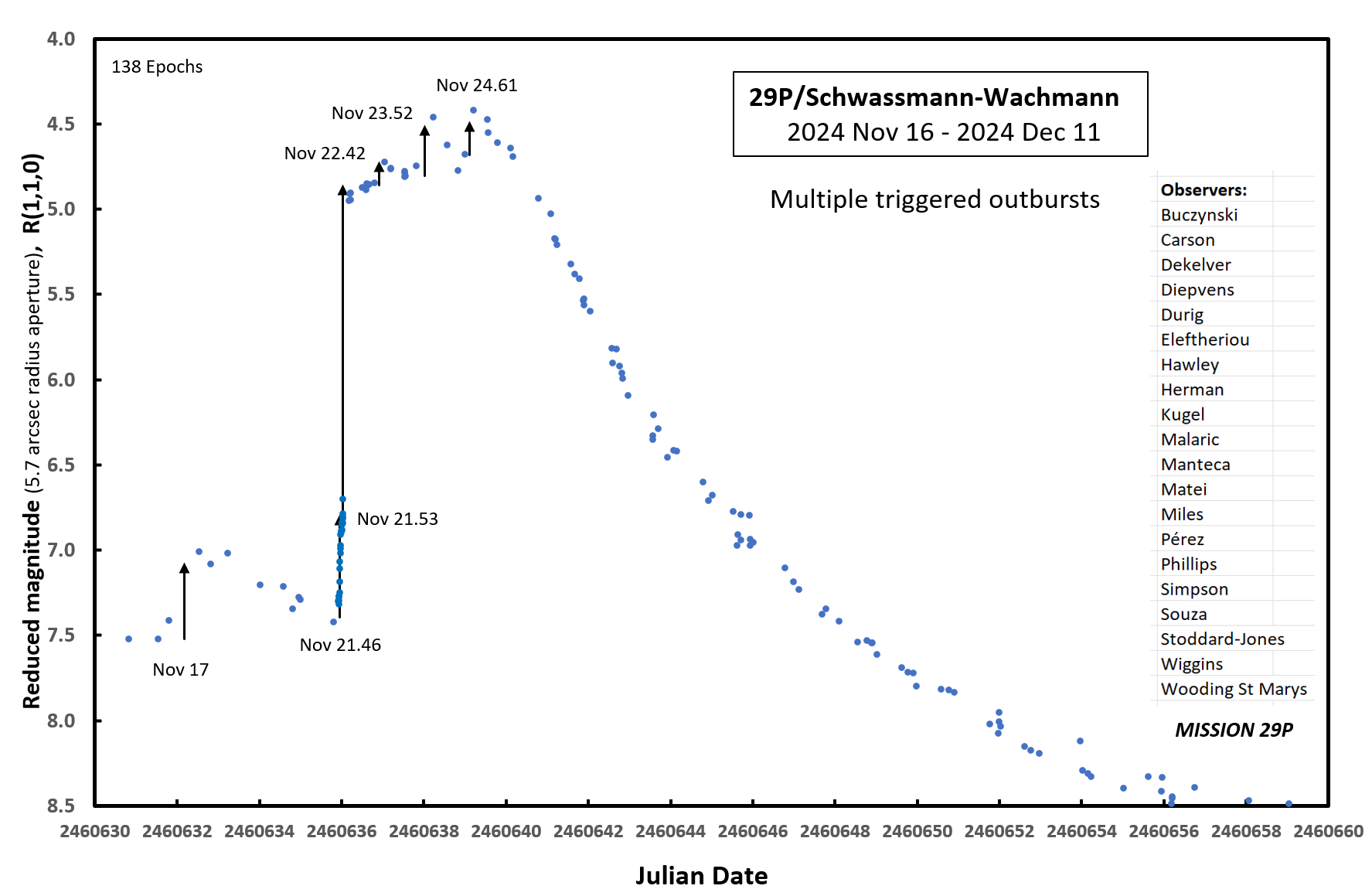
2024 November 25 – Multiple outbursts during the last 4 days with start of outbursts observed by Doug Durig from V21
The last few days has been dramatic!
These are the dates and intensity of events taking place:
2024 Nov 21.457 ± 0.001 (Intensity = 6 n.e.)
2024 Nov 21.531 ± 0.001 (Intensity = 77 n.e.)
2024 Nov 22.42 ± 0.08 (Intensity = 13 n.e.)
2024 Nov 23.52 ± 0.17 (Intensity = 31 n.e.)
2024 Nov 24.61 ± 0.08 (Intensity = 22 n.e.)
Thanks to an observing run between Nov 21.43 and Nov 21.54 conducted by D.T. Durig, we have detailed photometry of the start phase of this complex outburst. Also COMET CHASERS have used the Las Cumbres Observatory network to follow developments as has Pepe Manteca using iTelescope in Chile. We saw another set of 4 strong outbursts on 2024 Nov 02-03. But what is really surprising is that this latest set has occurred at virtually an identical rotational phase as was previously recorded during 2021 Sep 25-27 given a 57.68-day synodic rotation period for the nucleus (phase 0.72 to 0.77). It is difficult to predict what may happen next …
2024 November 21 – New very strong outburst 18 days after previous intense event
We have had an unusual set of 5 intense eruptions in the last 20 days after a spell of 220 days without any such event happening.
Here’s a logarithmic plot of the last 236 outbursts. Are there two types of outburst evident from these data?
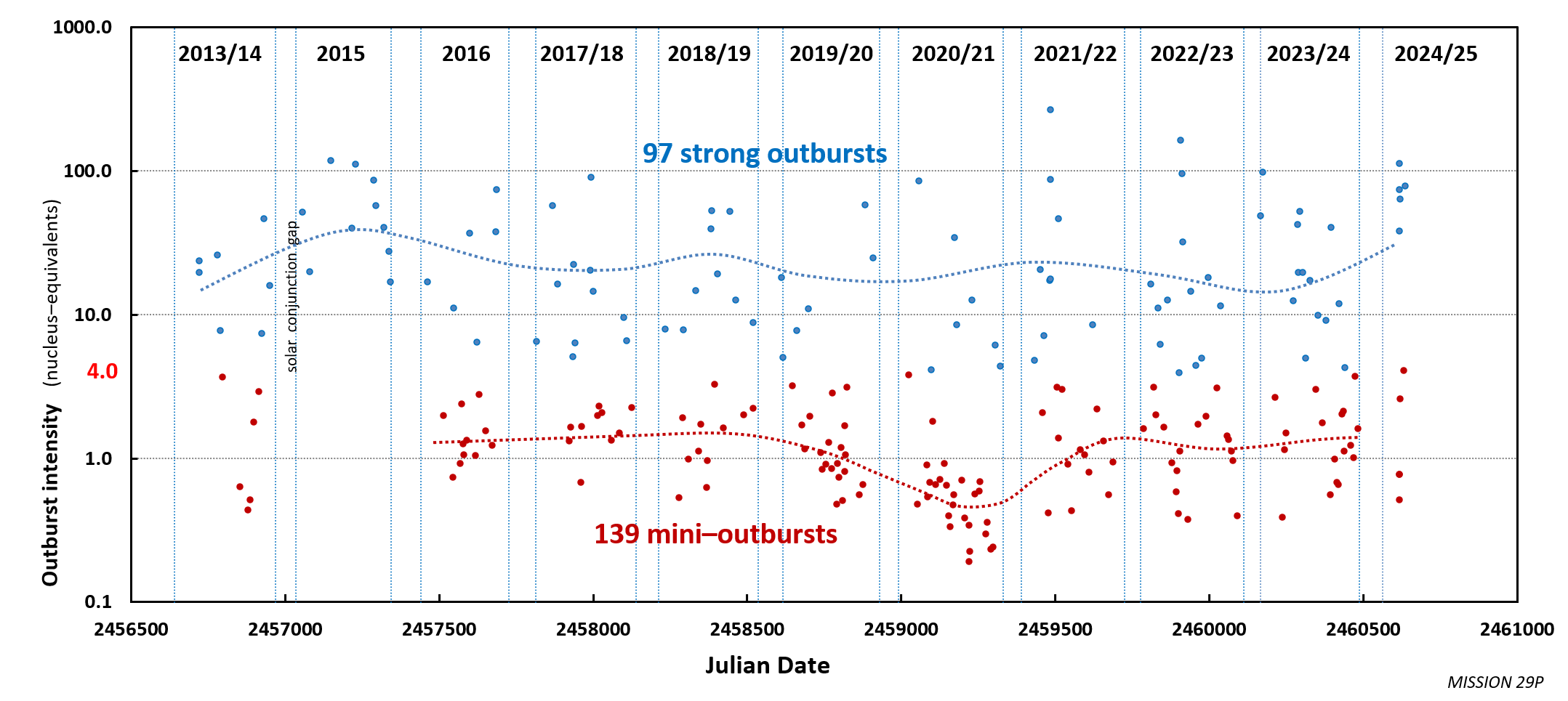
First small outburst following multi-eruption event
About 15 days following the previous major event, we have detected a 0.45 mag enhancement of the pseudonucleus indicative of a new outburst of intensity 4.6 nucleus-equivalents. Here is a 2.0-m image scheduled by Errol Simpson showing the new outburst coma imaged 3 days after the latest small outburst.
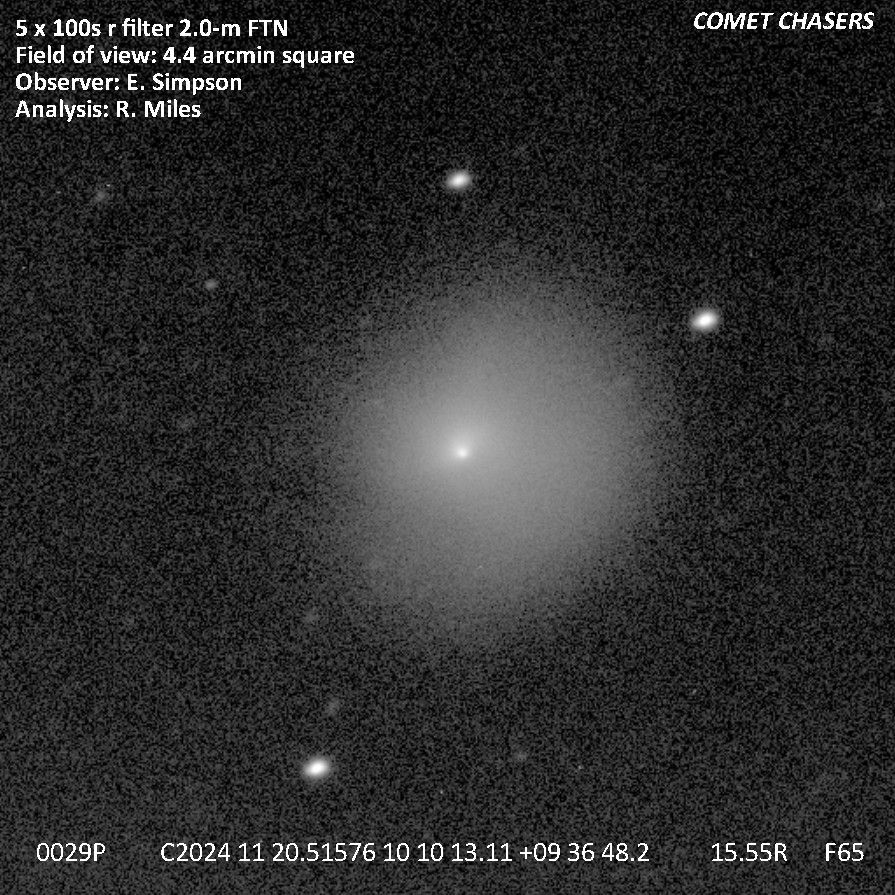
Strongest multi-eruption outburst, the most intense since 2021, first discovered by Jean-François Soulier
We appear to have had 4 strong outbursts within less than 48 hours, amounting to a total of 289 nucleus-equivalents in all, i.e. the ejection of material reflecting 289x the light reflected by the nucleus alone! The nature of this event is unusually very similar to a multi-eruption event that took place over 2.4 days during 2021 September 25‒27, the intensity of which totalled about 406 nucleus-equivalents. Such strong events result in a relatively spherical isotropic expansion of the outburst coma.
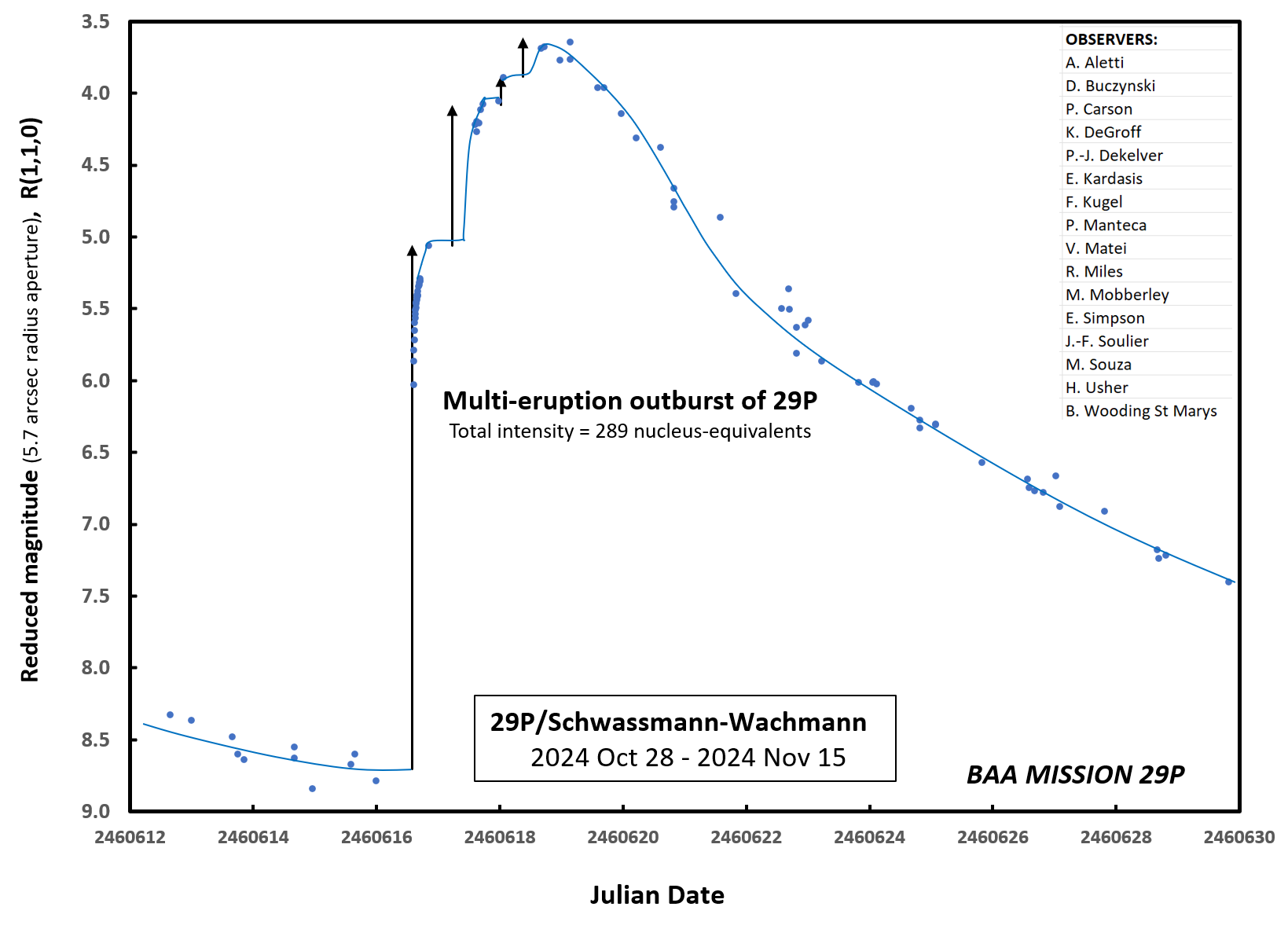
Fourth mini-outburst of 0.75-mag amplitude discovered by Jean-François Soulier and confirmed by Eliot Herman
Here’s the lightcurve thru’ to November 01:
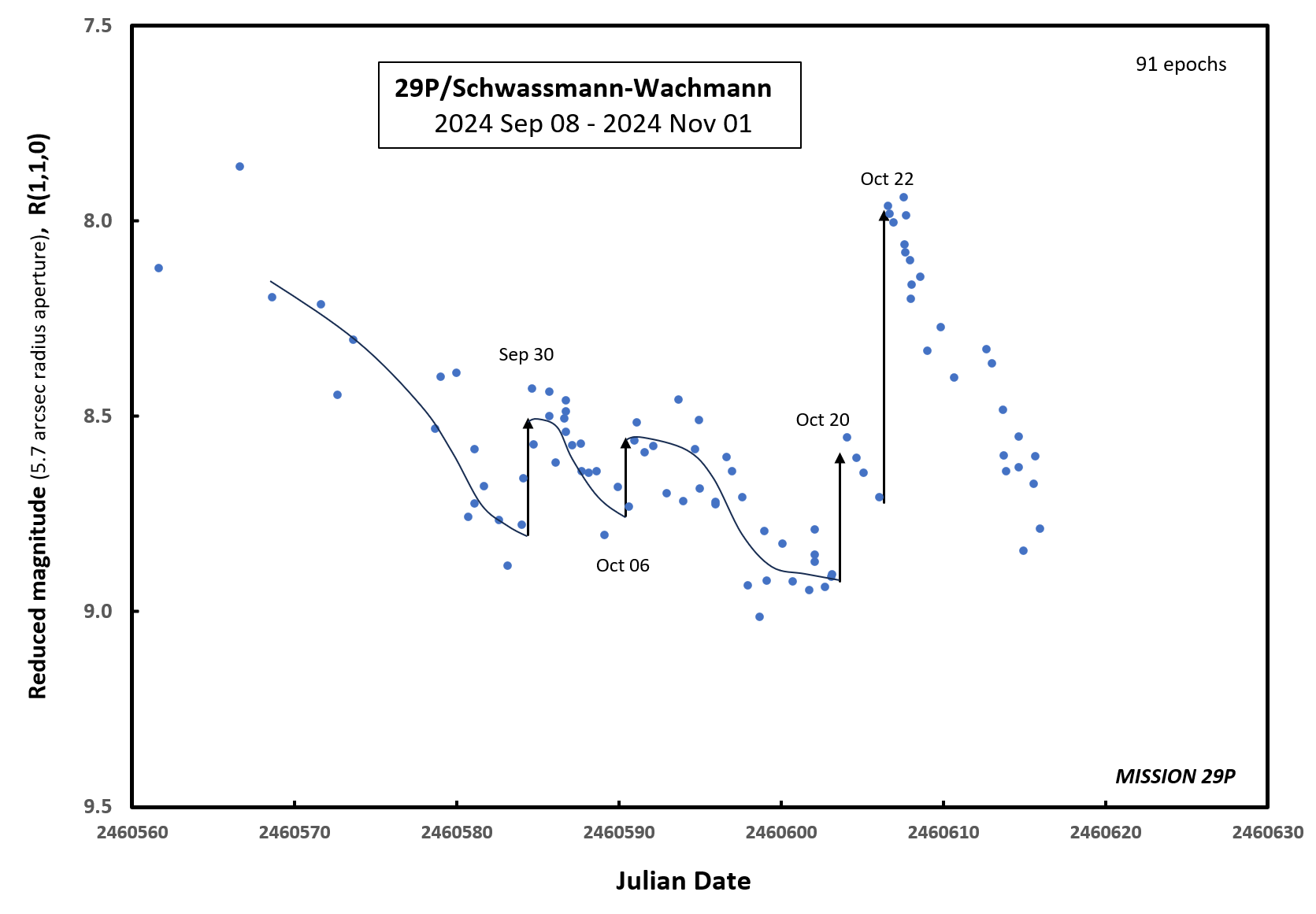
Six weeks coverage into the new apparition and we have detected THREE mini-outbursts
Today (Oct 02) a significant mini-outburst occurred, which has now been analysed and which shows along with the earlier data in the plot below that we have detected THREE mini-outbursts, the most powerful of which created a new outburst coma that was still less than the intensity of the nucleus alone (viz. 0.83 nucleus-equivalents). If we compare the time of this latest observation with one orbit earlier, there occurred a very intense outburst on 2010 Feb 02, which is 14.71 years ago. The current orbital period is given by JPL as 14.87 years although the times between its last two perihelion passages in 2004 and 2019 corresponds to 14.66 years. After 2010, the nucleus exhibited a full four years when no really strong outburst took place and we were able to determine the 57.7-day rotation period because smaller outbursts mainly originated from one side of the nucleus. Are we about to see the comet begin a repeat of that previous behaviour one orbit later? Let’s find out by keeping close watch!
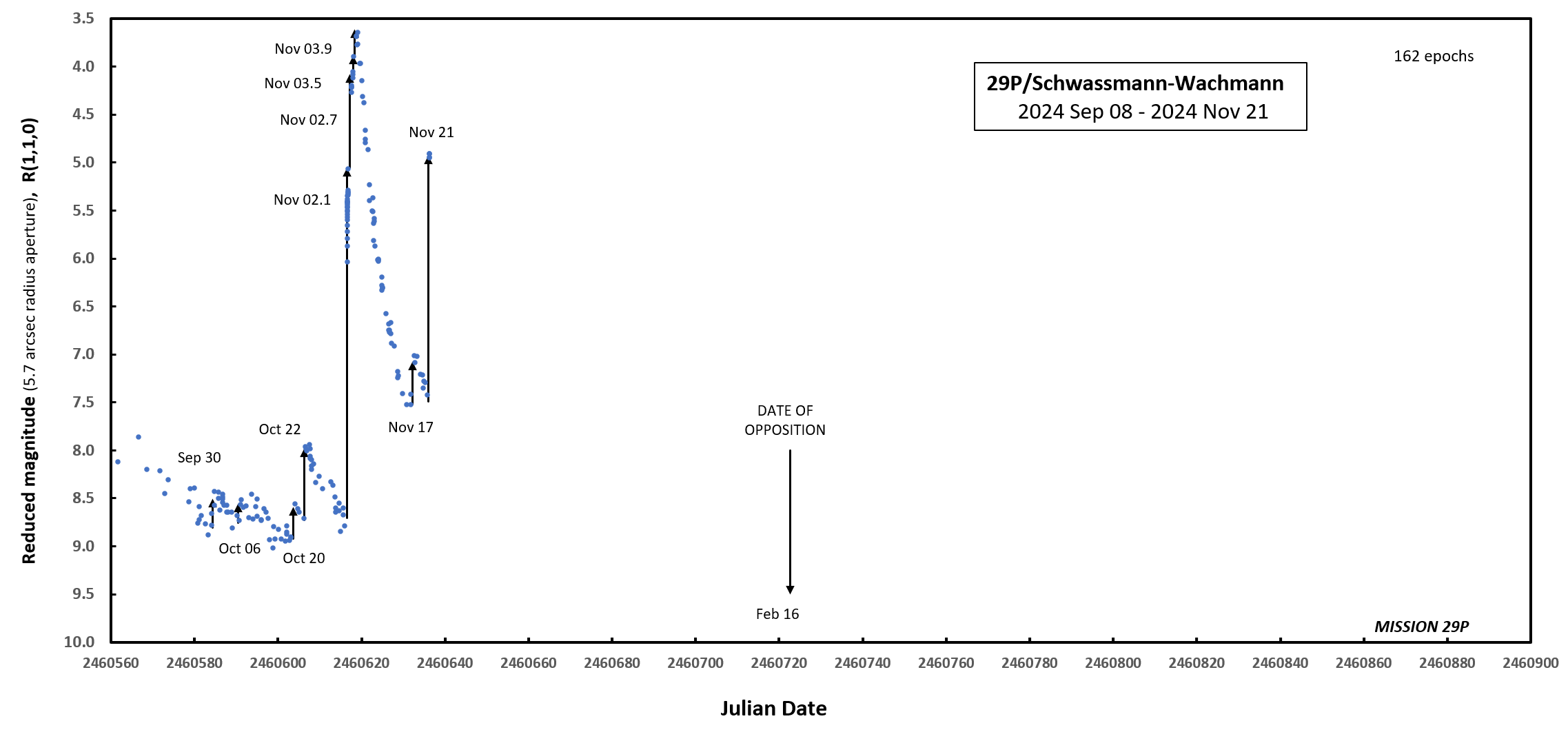
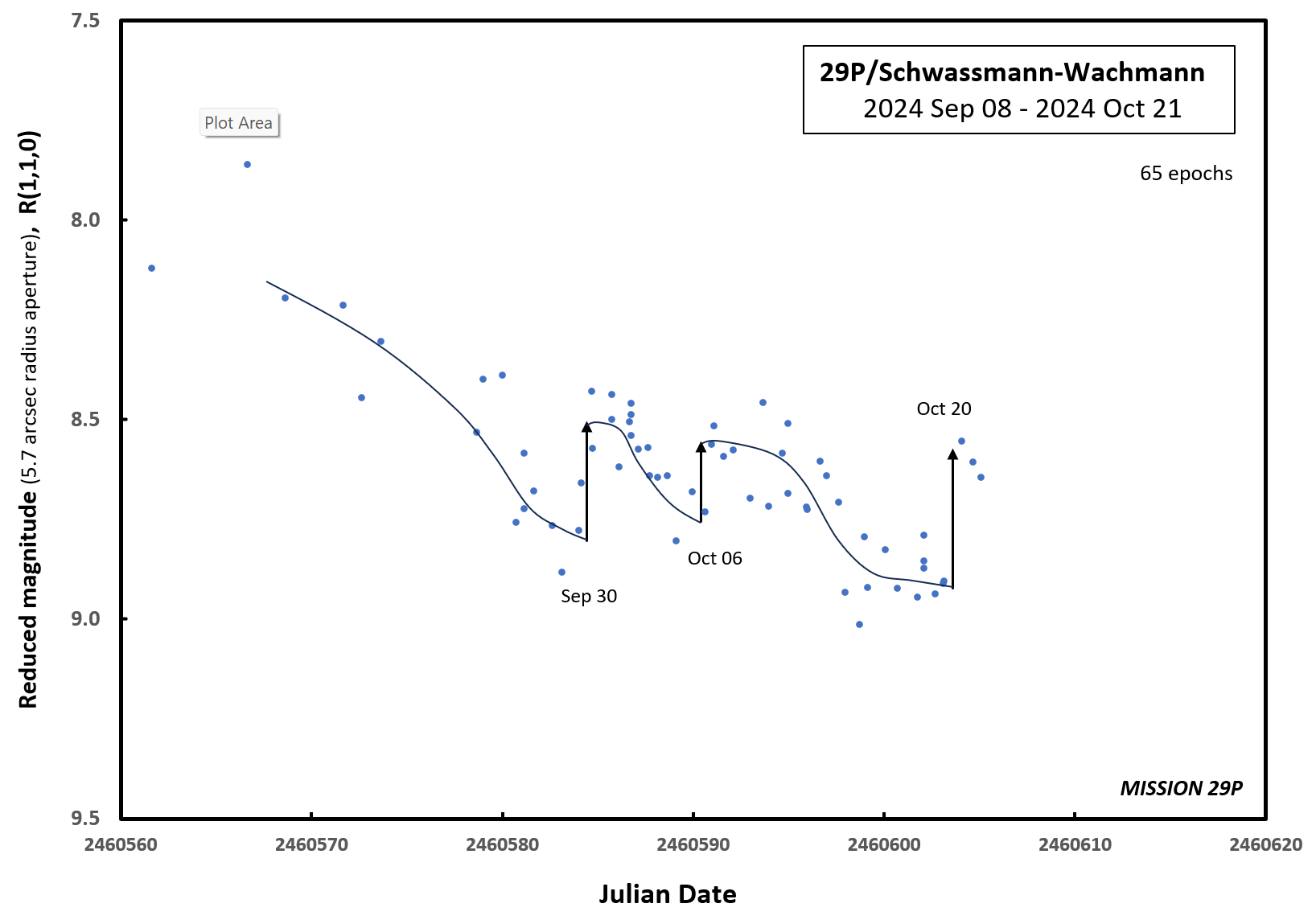
Commencement of the 2024‒25 apparition of 29P
Jean-François Soulier obtained the following impressive image on 2024 September 08 showing the comet to be largely quiescent at the moment.
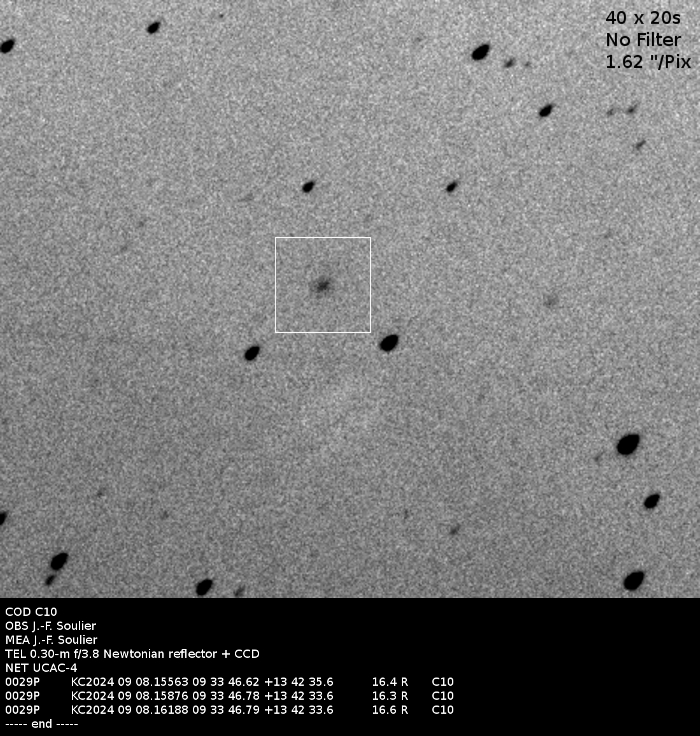
The image was taken at an altitude of 7° above the horizon and a solar elongation of 24.4°.
The gap in observations owing to solar conjunction has been 74.0 days, which compares favourably with the average for the last TEN 29P apparitions of 70.8 days.
The effective photometric aperture of Jean-François’ measurement was 7.3″ (radius) and so the measured mean value of 16.41R translates to a standard magnitude of about16.8R in a 5.7″ radius aperture. The cometwas 6.229 au from the Sun at the time and 7.133 au from Earth (3.8° phase angle), which is equivalent to an absolute R(1,1,0) mag of 8.5. It may therefore fade by up to a further 0.5 mag before we see the next outburst. On the other hand, an outburst may happen tomorrow! More observations are strongly encouraged.
——————————————————————————————————————
Observers totals for the 2023-24 apparition
Thanks to our 42 dedicated observers, we have amassed accurate photometry on 1047 epochs during the 11-month coverage of the 2023-24 observing window. Here are the observer totals:
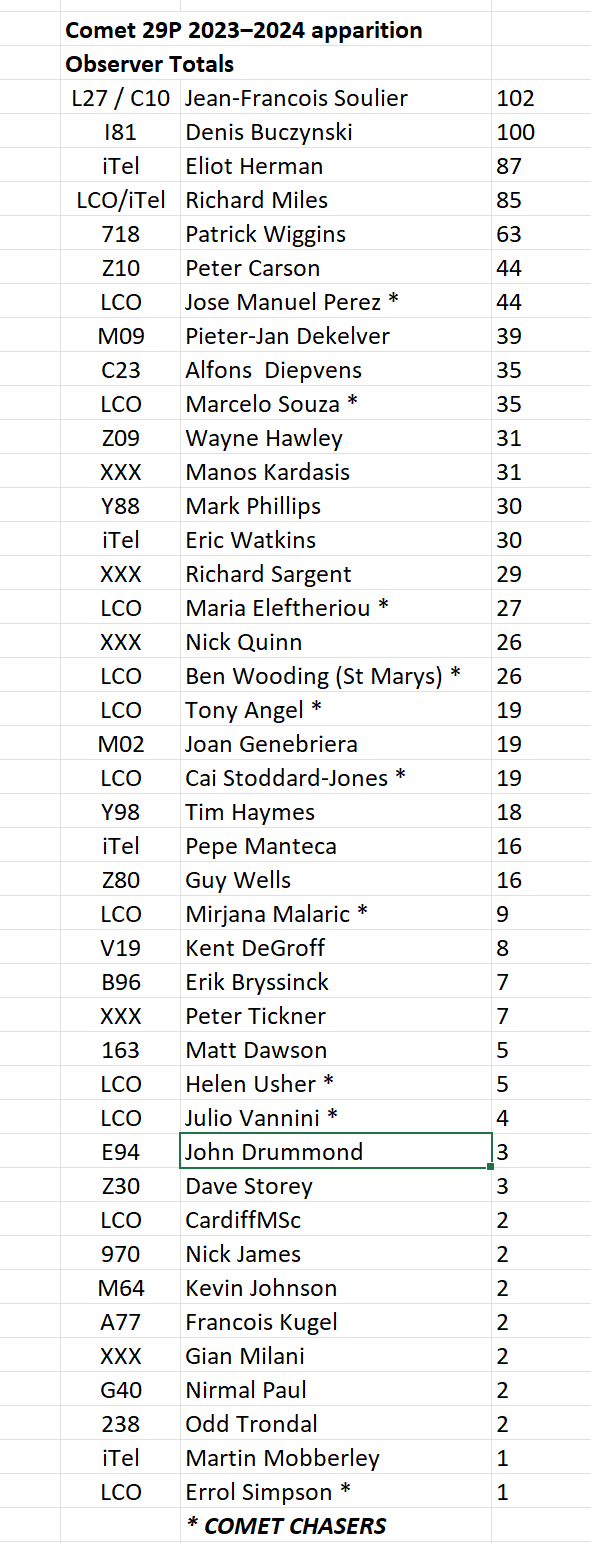
End of the 2023‒24 apparition of 29P
We have seen one last mini-outburst before our coverage ended on 2024 June 26 spanning a total of 321.0 days. During this time interval, we witnessed 31 outbursts (14 strong and 17 weak outbursts).
Reported photometry data are archived below.
Mini-outbursts on June 05 and June 11
Since beginning of April, we have detected 10 mini-outbursts and only one ‘strong’ outburst, which is very different for the period, December thro’ March when we had 10 ‘strong’ outbursts and only 1 mini-outburst detected. Clearly the nucleus has undergone a change in behaviour for some reason!
Mini-outburst on May 27 of 0.4 mag amplitude
First event after 17 days of fade.
FOUR mini-outbursts: 2024 April 30, May 04, May 07, and May 10 – 0.45 mag, 0.40 mag, 0.22 mag and 0.75 mag amplitude
That means we have detected SEVEN mini-outbursts and one stronger outburst (1.6 mag amplitude) all within the space of 34 days.
2024 April 21 – 1.6-magnitude outburst discovered by Wayne Hawley and Jean-Francois Soulier yesterday evening
2.0-m images taken this morning (April 23) show that this event has created a fairly typical asymmetric outburst coma, which indicates the eruption source is located towards the limb of the nucleus:
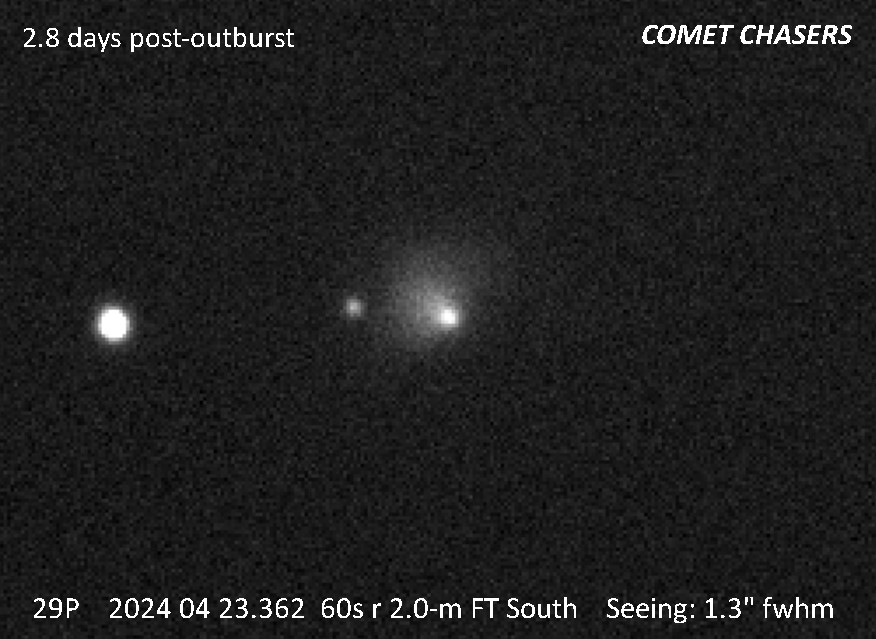
2024 April 07 – Mini-outburst on April 6 confirmed
Thanks to lots of observations by MISSION 29P observers, we can confirm a weak 0.30-mag amplitude eruption took place on April 6.
2024 March 26 – First image of the March 24 outburst coma
Here’s the close-up view thanks to the Comet Chasers group:
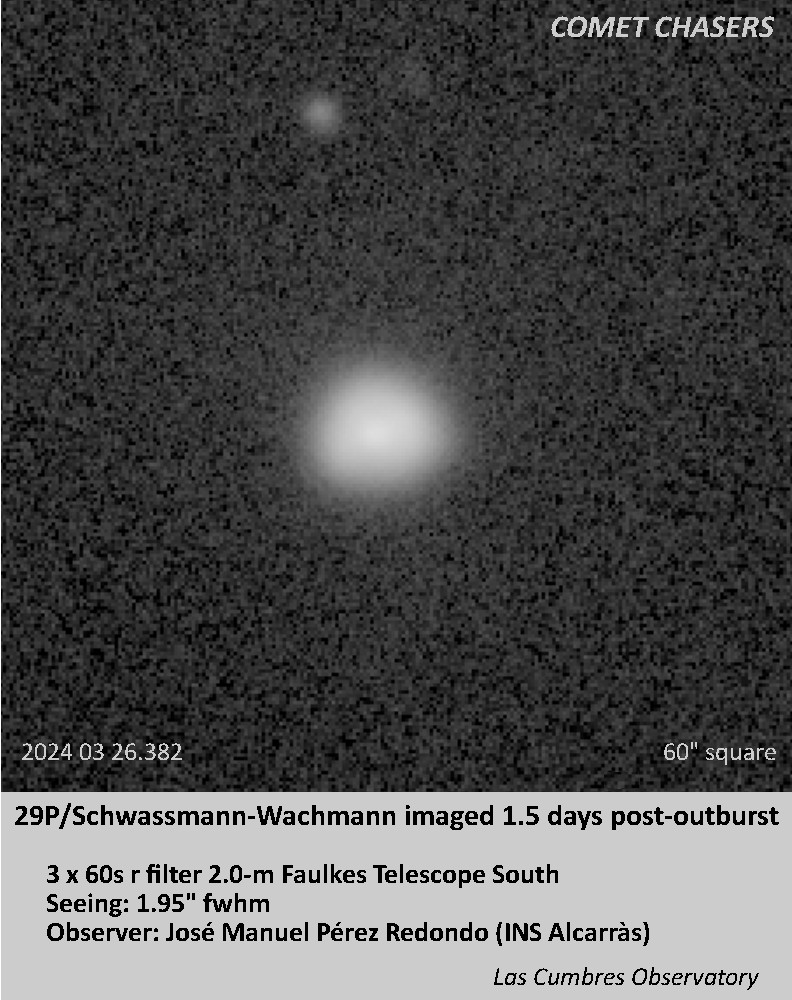
2024 March 24 – Strong outburst of 3 mag amplitude began during a 10 x 60sec imaging run !
Mark Phillips of the Astronomical Society of Edinburgh took a set of 10 x 60 sec exposures of 29P this evening. After the second exposure the comet then underwent a 3-magnitude amplitude outburst! Fortunately a live discussion ensued so Mark took some more images starting 35 minutes later, which showed a further jump of 1.7 magnitudes. Seven observers have contributed to the outburst lightcurve below – see also data on Observations Page. Further strong outbursts are expected.
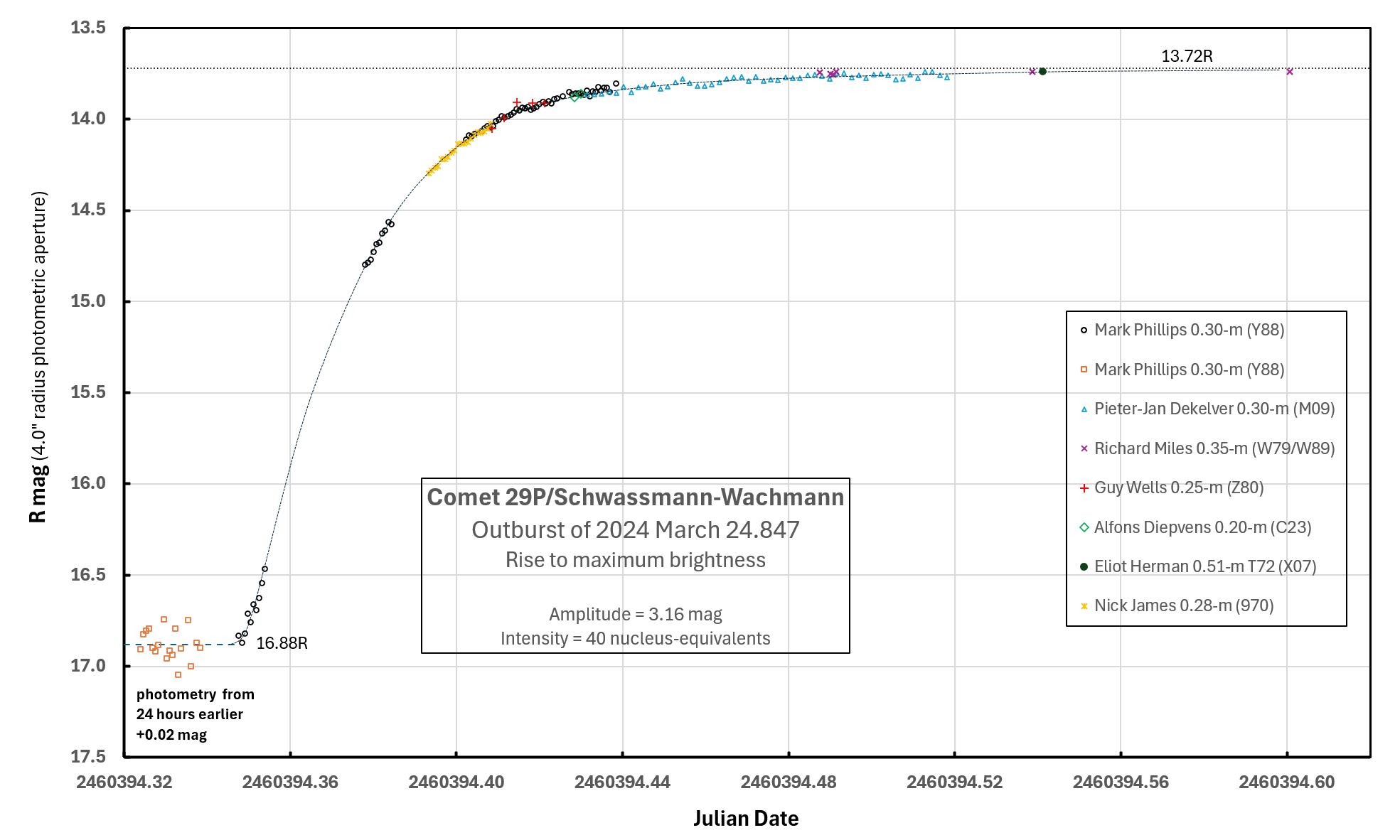
2024 March 08 – Outburst of 1.8 mag amplitude
Detected by Comet Chasers, part of the Faulkes Telescope Project, using the Las Cumbres Observatory 0.4-m telescope network in Tenerife. We may have a full outburst lightcurve in due course. Here is an image taken 36 hours after the eruption. Interestingly, the intensity of this event was almost identical to that of February 12, which took place 26 days earlier. The ‘spiral’ shaped coma appears similar but inverted in position (see February 12 image below for comparison). This suggests that the rotation of the nucleus is retrograde and that both eruptions took place near the morning terminator, the most recent being situated south of the local equator, whereas the source of the earlier event lay a similar distance north of the equator on the nucleus.
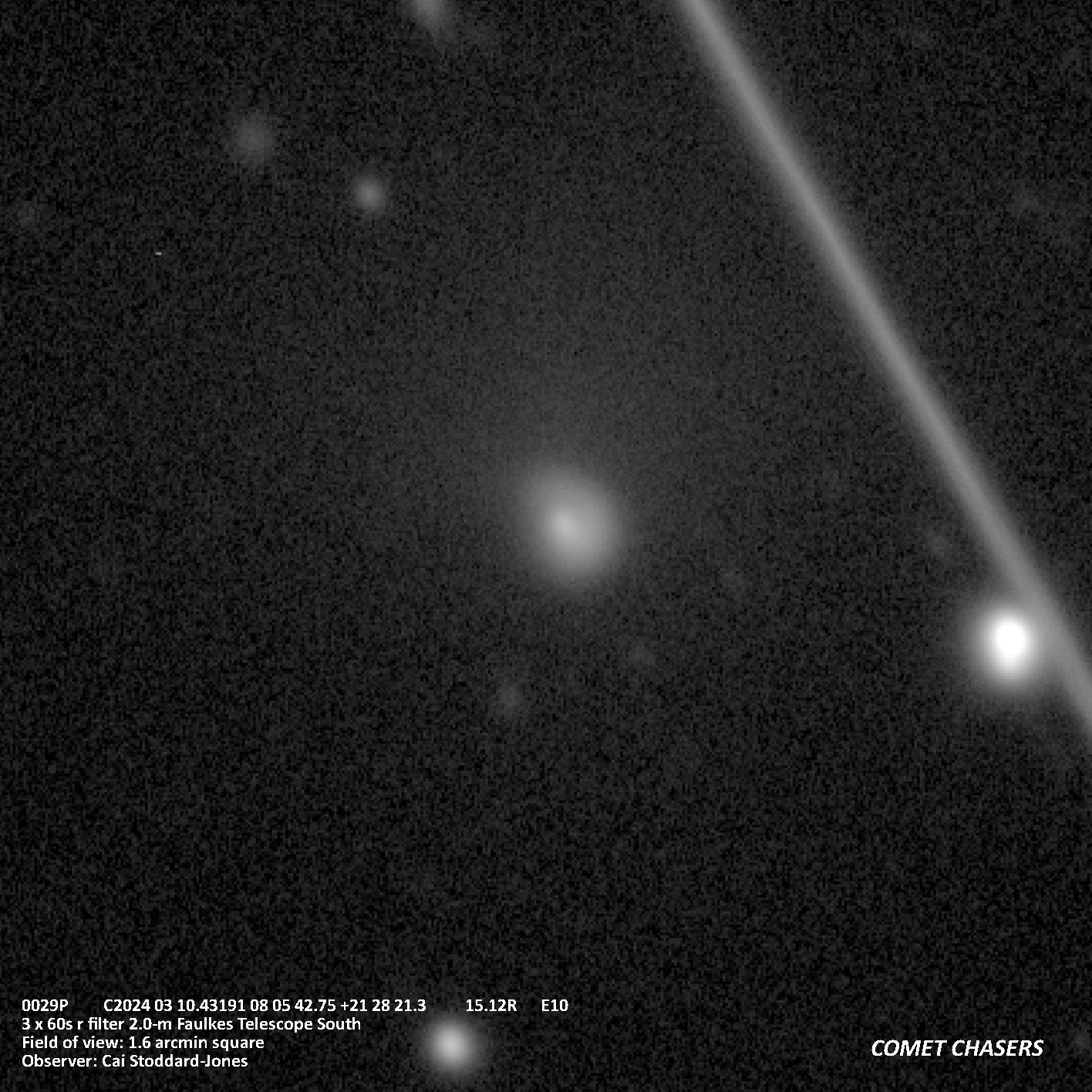
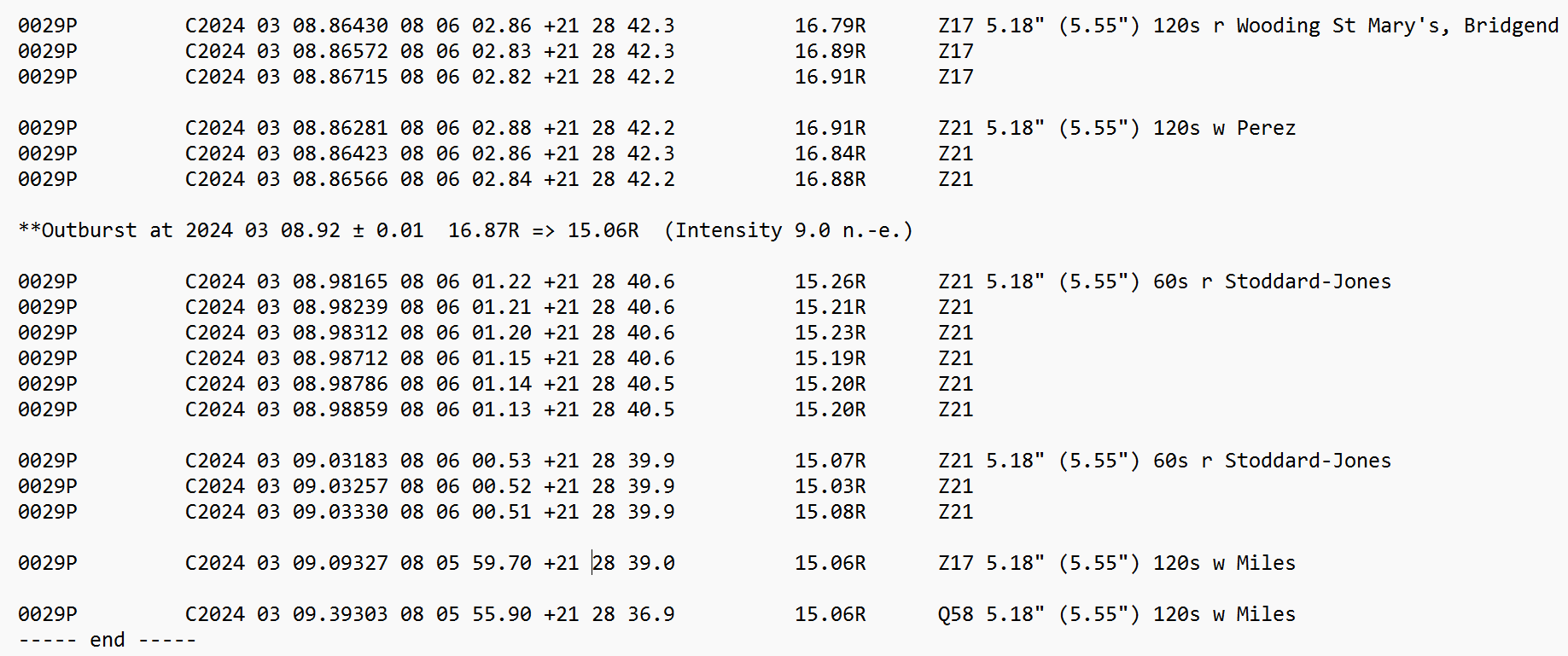
2024 February 25 – Mini-outburst of 0.6 mag amplitude
Clearly detected in photometry by Denis Buczynski and in images by St Mary’s School, Bridgend, Wales. Two days after this weak outburst, the new coma looks very different to its previous stronger eruption as shown in this 2.0-m image taken by Cai Stoddard-Jones, Cardiff University, in poor seeing:
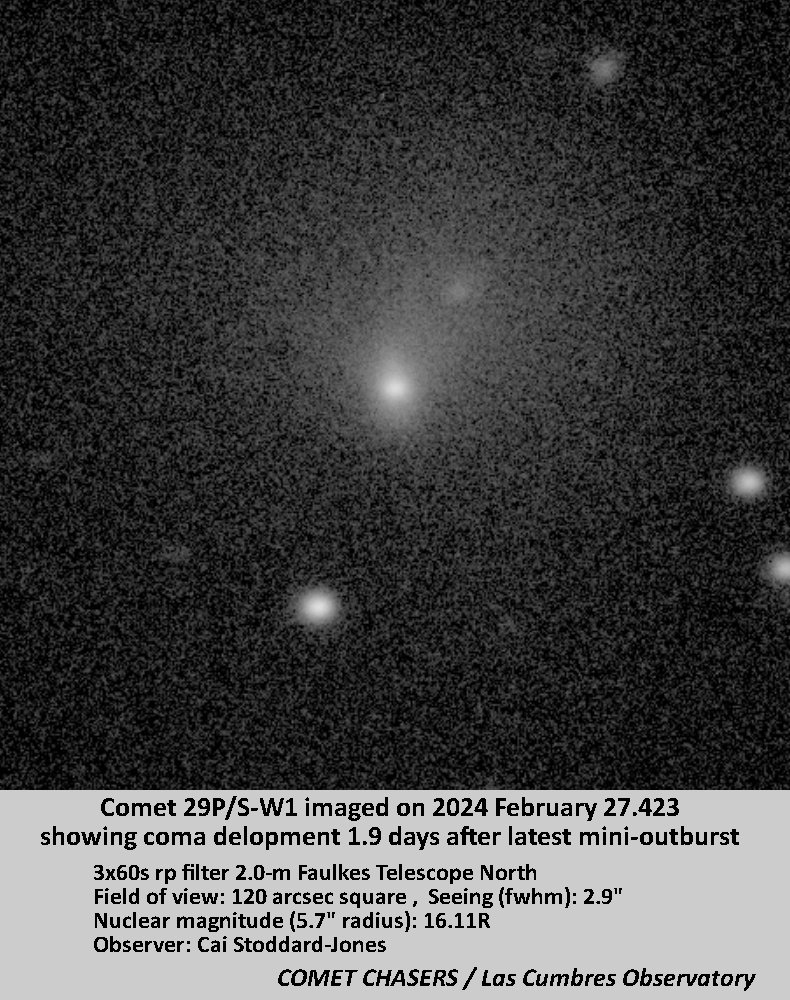
2024 February 12 – Outburst of 1.65 mag amplitude
Wayne Hawley discovered this strong outburst, which is more than 3 times more intense than the event 7 days earlier.
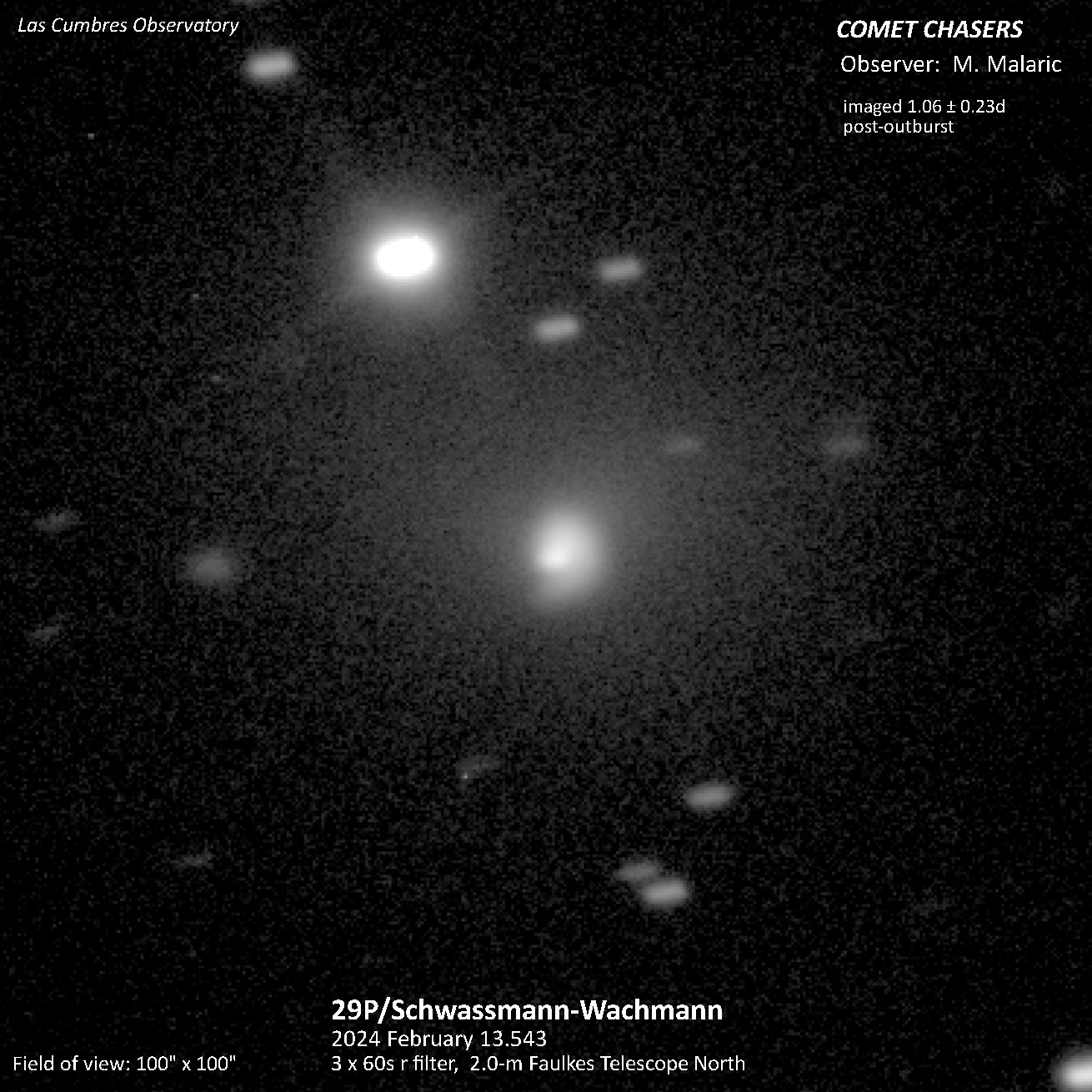
2024 February 05 – Mini-outburst of 0.82 mag amplitude
The high level of activity continues. Denis B. discovered this event on inspecting images taken on Feb 06.88. Here is a deep image of the latest mag 15.5R outburst taken with a 2.0-m telescope.
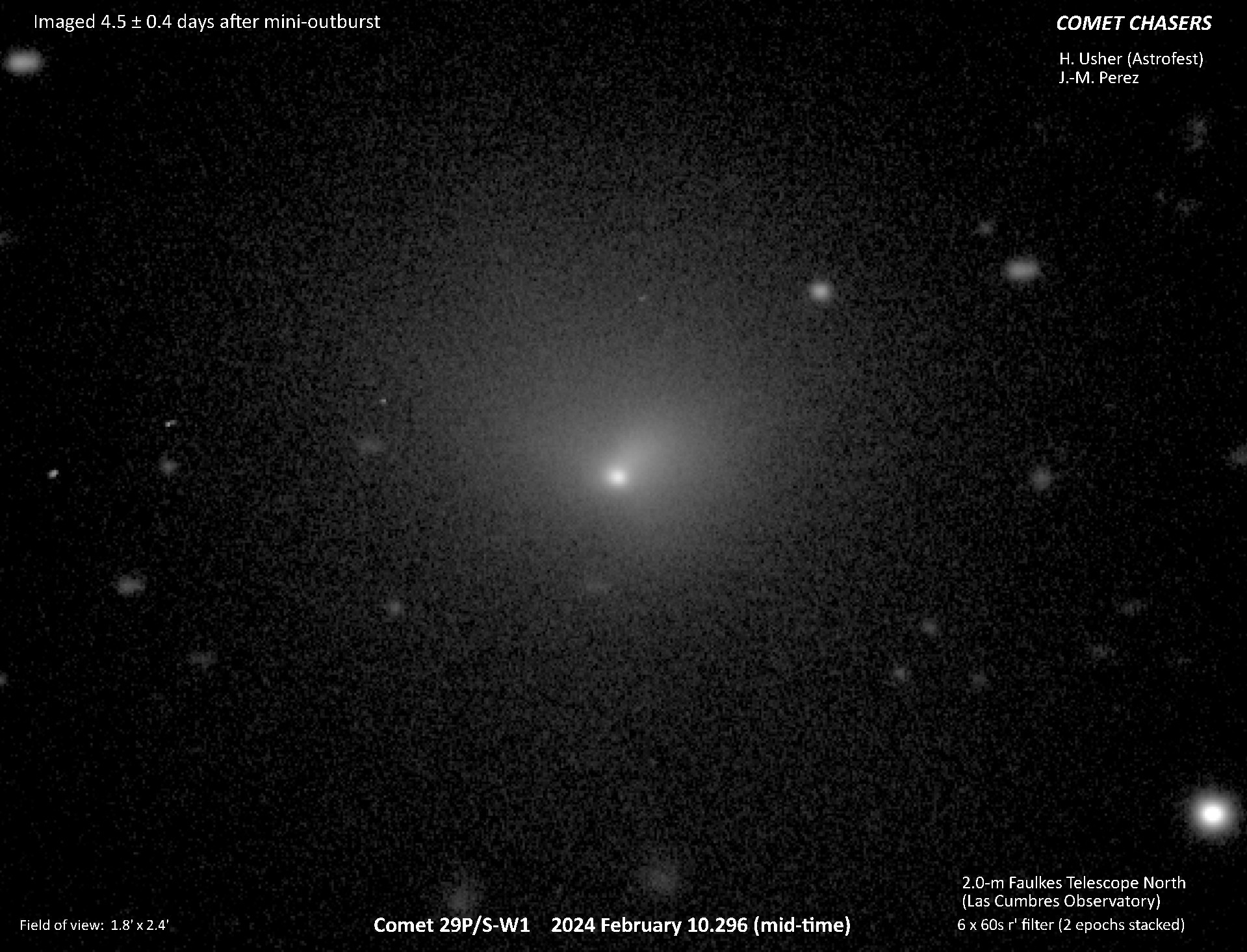
2024 January 04 / January 16 – Enhanced activity continuing into 2024
January 16 event discovered by Denis Buczynski (see latest data)
Another significant outburst on January 04 detected in image from Marcelo Souza, and confirmed about 7 hours later by Maria Eleftheriou of Heraklion Junior School both from the Comet Chasers project. We have now witnessed 6 strong outbursts within 26 days of each other.
2023 December 24 – Four strong outbursts in 15 days marks a distinct onset of enhanced activity
Activity during the 2023-24 apparition is now starting to rival that of the other strongest activity of the past 21 years, namely that of 2008-2009. The latest outburst on December 23 was discovered by Denis Buczynski using the 0.43-m Alnitak telescope at Astrocamp in Nerpio, Spain.
2023 December 14 – Another strong outburst 5 days after the previous two
Activity by way of discrete outbursts appears to be on the rise. The last two may have been triggered following the December 08 event.
2023 December 08/09 – TWO strong outbursts within ~20 hours
Imaging by Richard Miles caught the outburst still on the rise, followed by a second outburst in images by Marcelo de Oliveria Souza and Maria Eletheriou, all members of the Comet Chasers monitoring project. This is the strongest event since that of 2023 August 16.
N.B. Gap between these two noteworthy outbursts is 114 days = 2 x 57 days or TWO rotations of the nucleus.
On average, strong outbursts exhibit a 57.7 day periodicity, or small multiple of 57.7 days.
2023 November 23 – Strong outburst
Discovered by Denis Buczynski (using Alnitak telescope at I79, Nerpio, Spain) and confirmed independently by François Kugel (A77), this very definite event comes 58 days after the last most significant outburst
See data and plot.
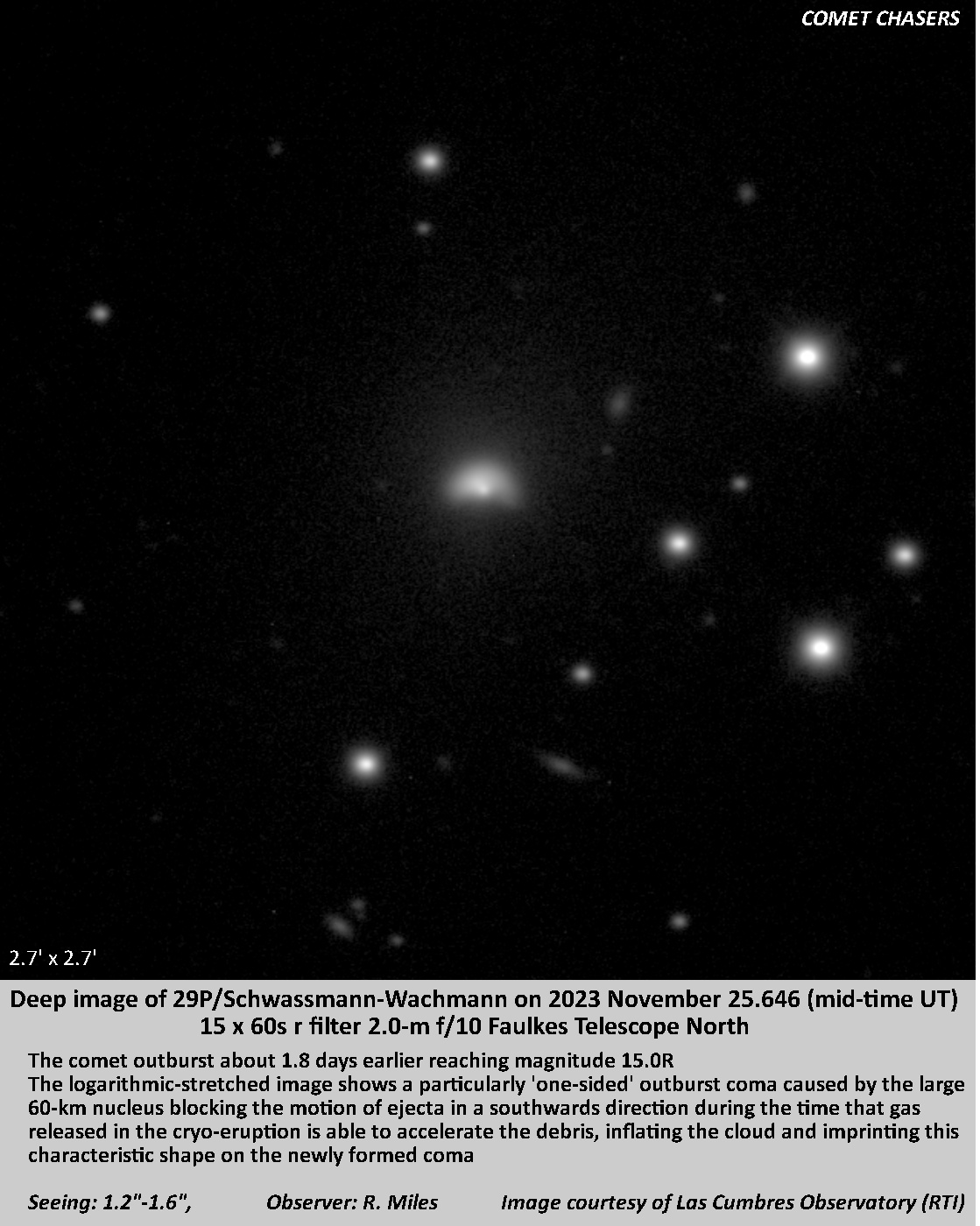
2023 October 26 – Third mini-outburst!
Mini-outburst evident in the image taken by St Marys School, Bridgend (B. Wooding)
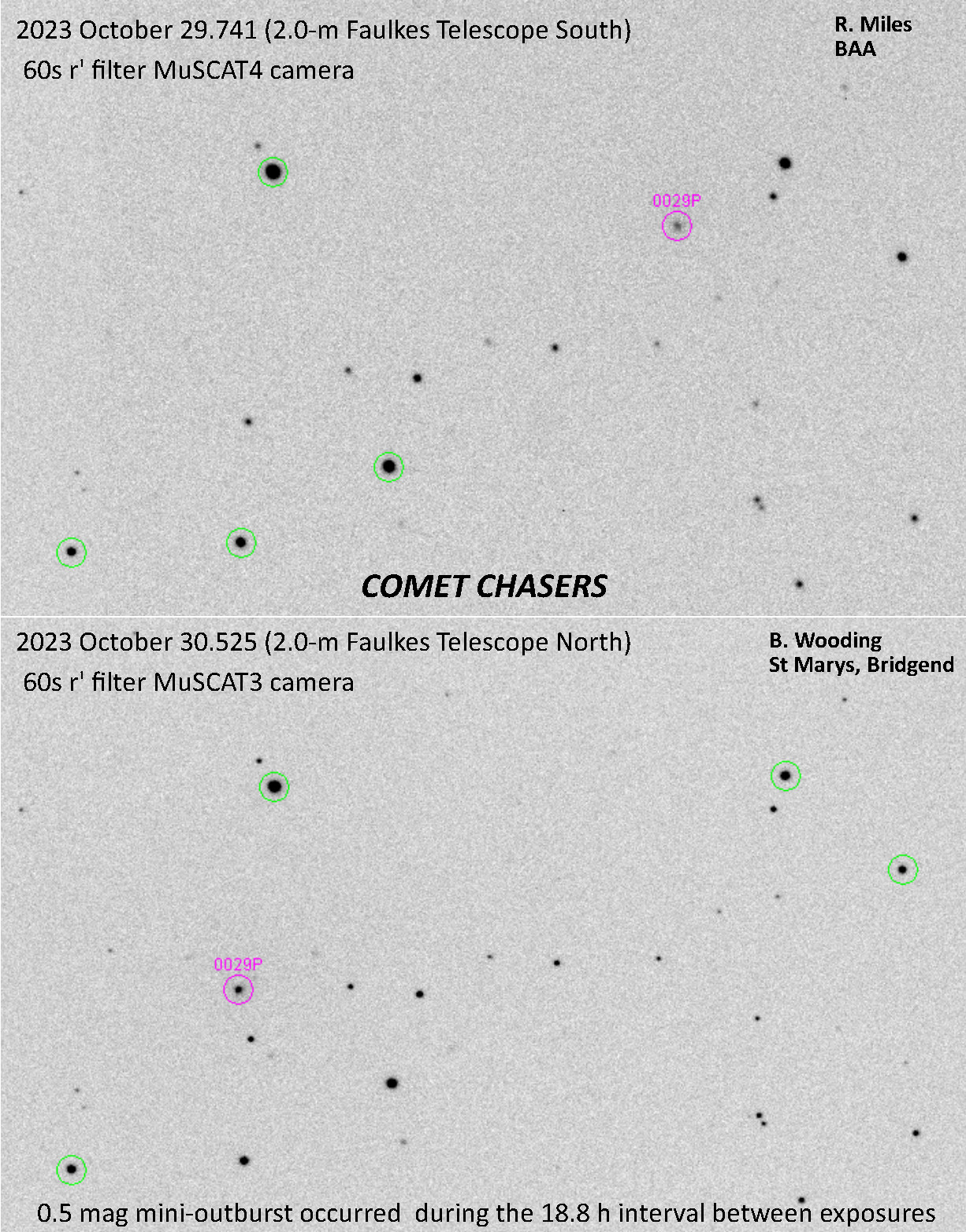
2023 October 26 – Two further mini-outbursts identified
The first took place on 2023 October 19.0 but as its amplitude was only about 0.20 magnitudes it was only properly recognised after a further 8 sets of observations over the next 2-3 days. Today we have witnessed a very obvious 0.5-mag outburst (October 25.9) thanks to an image taken by Maria Eleftheriou at Heraklion Junior School and which has now been confirmed.
2023 September 27 – First mini-outburst of the 2023‒24 apparition
Thanks to Jean-François Soulier and confirmation by Eric Watkins, we have detected a mini-outburst the ejecta from which have amounted to 2.3 nucleus-equivalent of material suddenly ejected into space following a cryo-eruption. The centaur-comet was still at less than 60° solar elongation when this was detected so we are doing very well with our initial coverage at the start of the new apparition. The forthcoming months promise to involve some energetic outbursts as we are currently near the peak of its seasonal activity during its 14.7 year-long orbit of the Sun.
2023 September 12 – First close-up of the outburst coma 27 days later
Thanks to Cardiff University PhD student, Cai Stoddard-Jones we have an earlier-than-expected image taken with the Faulkes Telescope North on Haleakala in Hawaii. There is still some structure visible in the inner coma something that amateur Denis Buczynski, observing from Portmahomack, Scotland, has also commented on today. It is now 27 days since the last of two strong outbursts happened within 7 days of each other so the visible material will have been the slower fraction ejected into space from each of these.
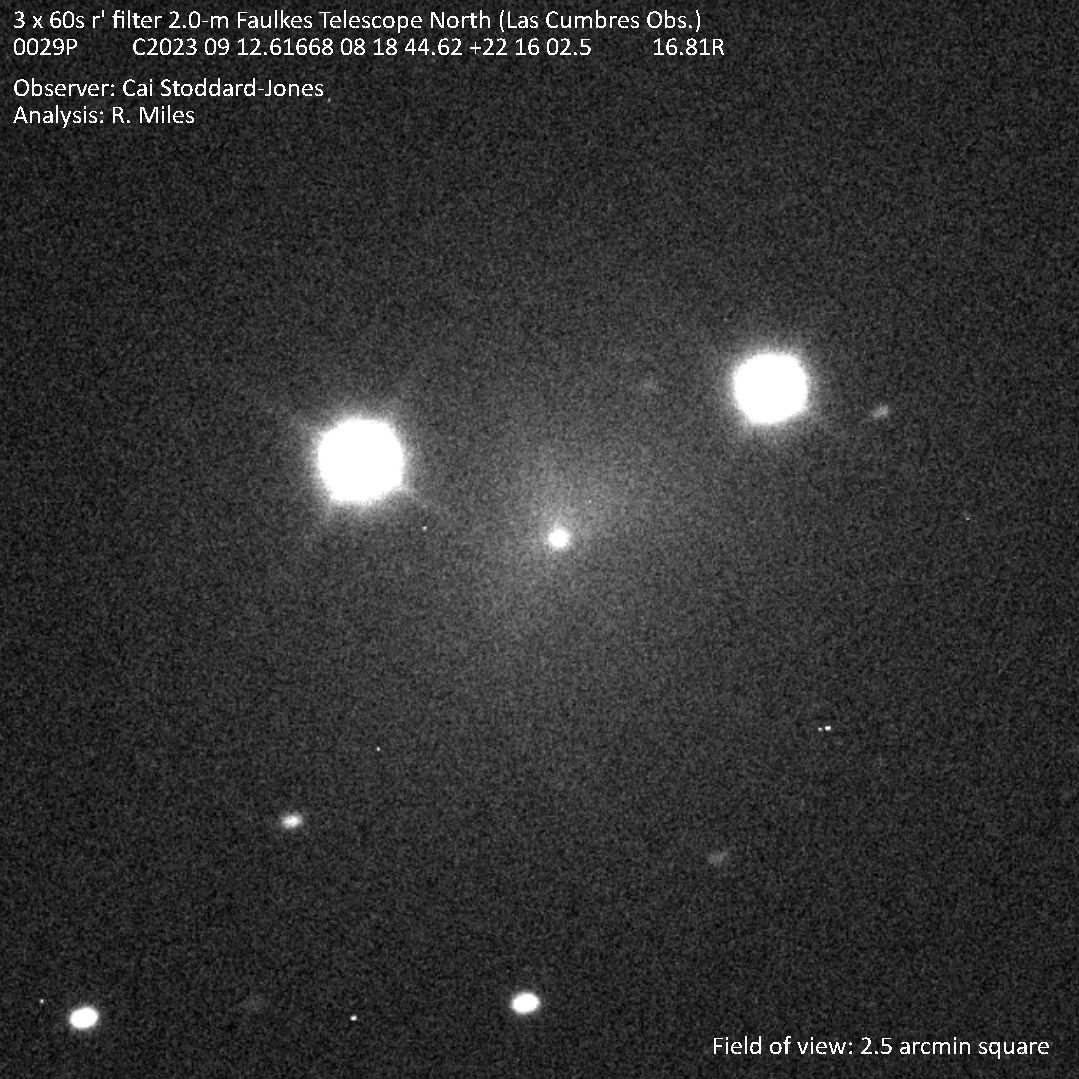
2023 August 18 – Second stronger outburst!
A second discovery by Jean-François a week or so after his first. The intensity of this second event amounted to approx. 98 nucleus-equivalents, the earlier was a little around 50 nucleus-equivalents. Peter Carson’s follow-up on August 20 resulted in an upgrade to its intensity.
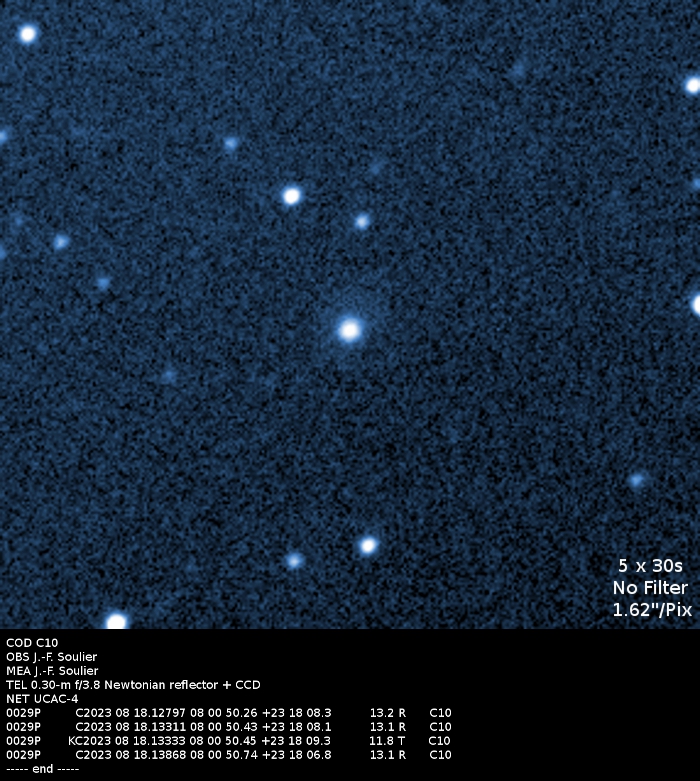
2023 August 14 – Start of the 2023-24 apparition with a new outburst!
Thanks to a strong outburst, 29P has been picked up early on in its new apparition by Jean-François Soulier observing from northern France, who also confirmed it on the following night. The 13th magnitude outburst was measured photometrically just 21° from the Sun. Although the comet has faded a magnitude, Matt Dawson has obtained some nice images from southern Italy with it at 24° solar elongation. This is an excellent start to the new season for 29P watchers! Well done Jean-François and Matt.
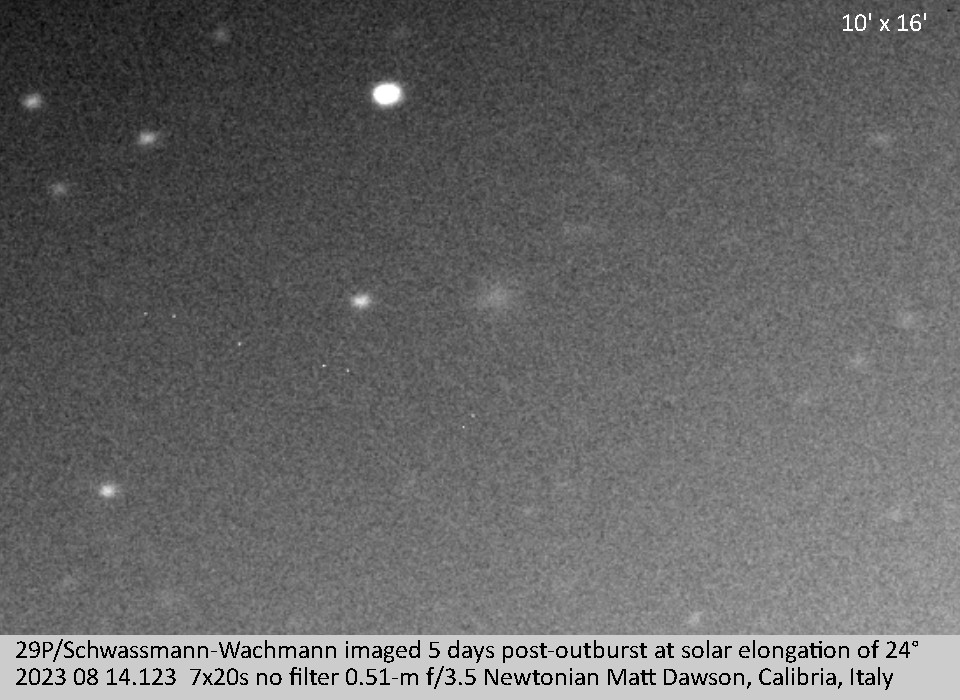
2023 July 17 – Observers totals for the 2022-23 apparition
Thanks to our 41 dedicated observers, we have amassed accurate photometry on 967 epochs during the 11-month coverage of the 2022-23 observing window. Here are the observer totals:
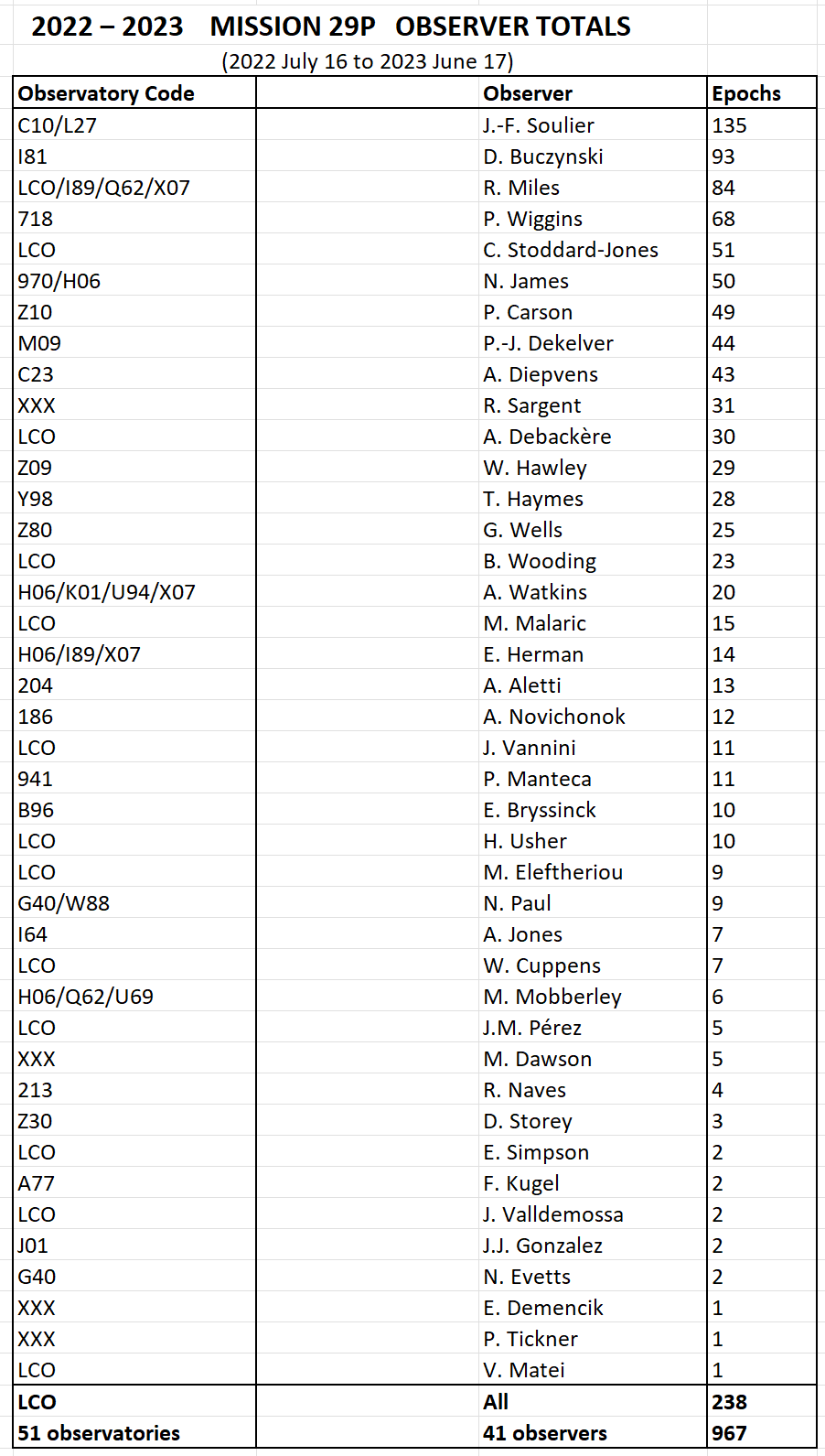
2023 Jun 16 / Jun 17 – Comet 29P fainter than 14.8R
The region of the sky containing 29P around 21° from the limb of the Sun was imaged on June 16.17 and June 17.17 from Utah by Patrick Wiggins! Its altitude was just 5° above the horizon. We can say that at the later time the target was fainter than 14.8R, so no particularly strong outburst has taken place in the last 12 days (since last imaged). We can definitely say goodbye to 29P until it reappears in the morning sky around 8 weeks from now.
2023 Jun 3 – Last few days when observations possible this apparition
Patrick Wiggins obtained images of the field containing 29P this morning when the centaur-comet was at just 31° solar elongation. Unfortunately it was at the time superimposed on top of a 15th magnitude field star so the photometry is relatively approximate at about 16.95R ±0.4 mag, i.e. largely quiescent. It will be a challenge to obtain further images of the field over the next few days as a clear atmosphere will be required given that its altitude above the horizon will be about 5° – 7° once the sky is sufficiently dark after sunset.
2023 May 17 – Grazing stellar occultation by 29P recorded from the UK on 2023 May 07
Despite patch weather conditions, a fourth observer, Malcolm Jennings has recorded a positive occultation lasting 0.38 sec compared to a maximum predicted duration of 1.9 sec. Here is Malcolm’s digitised plot and the four observers’ tracks relative to the position of the nucleus. This is the first-ever successful observation of a stellar occultation by the nucleus of a comet as seen from the UK. Well done all 4 observers given the low altitude in the sky and the deteriorating weather at the time of the event.

2023 May 11 – Yet another new mini-outburst
Ben Wooding of St Marys School, Bridgend, Wales scheduled three 0.4-m images which were taken earlier this morning using the Las Cumbres Observatory instrument on Haleakala, Hawaii. Surprisingly they show 29P shining 0.3-0.4 magnitudes brighter than it did in images by Maria Eleftheriou taken just 9 hours earlier. We might easily have missed this as it was only 4 days after the previous event. It shows yet again the importance of high-cadence coverage of 29P as a means of uncovering its true nature.
2023 May 08 – May 07 occultation results / New mini-outburst
Nick James, Simon Kidd and Phil Denyer all report negative observations indicating that the shadow path shifted a significant distance westwards compared to the Lucky Star prediction. Alex Pratt monitored the field from Leeds, but the field was obscured by a neighbour’s roof only 3 minutes before the predicted occultation time.
Patrick Wiggins’ images this morning indicate a 0.35-mag mini-outburst has occurred within the last 2 days and most probably on May 07. Well done, Patrick! Eric Watkins also obtained an image using iTelescope likewise from Utah around the same time as Patrick.
See: Latest Data and Lightcurve Plot of 29P – British Astronomical Association (britastro.org)
2023 May 04 – Forthcoming stellar occultation by the nucleus of 29P as seen from UK on May 07 22:43UT
This extremely rare occultation by the ~60 km nucleus of Comet 29P is due this Sunday, late evening.
The Lucky Star Project has all the details of the predicted event at:
https://lesia.obspm.fr/lucky-star/occ.php?p=122512
Tim Haymes’ Web page and notes are also helpful if you are planning to observe:
http://www.stargazer.me.uk/call4obs/29PUK20230507.htm
The main issue is that although the star is quite bright at magnitude (~11.7R) and the pseudonucleus of 29P is currently close to 17.0R (so a very large magnitude drop is expected), as seen from the UK the event takes place at low altitude (elevation above the apparent horizon) of just 11° to 16° depending on where the observing location is situated. So if you are planning to attempt this you will have to check that the area of the sky low towards the north-west is clear of any obstruction. I started to prepare a ground plot showing the predicted path of the shadow, which is accurate to ±20 km, the predicted time ±1 sec, and approximate altitude. Have appended it below.
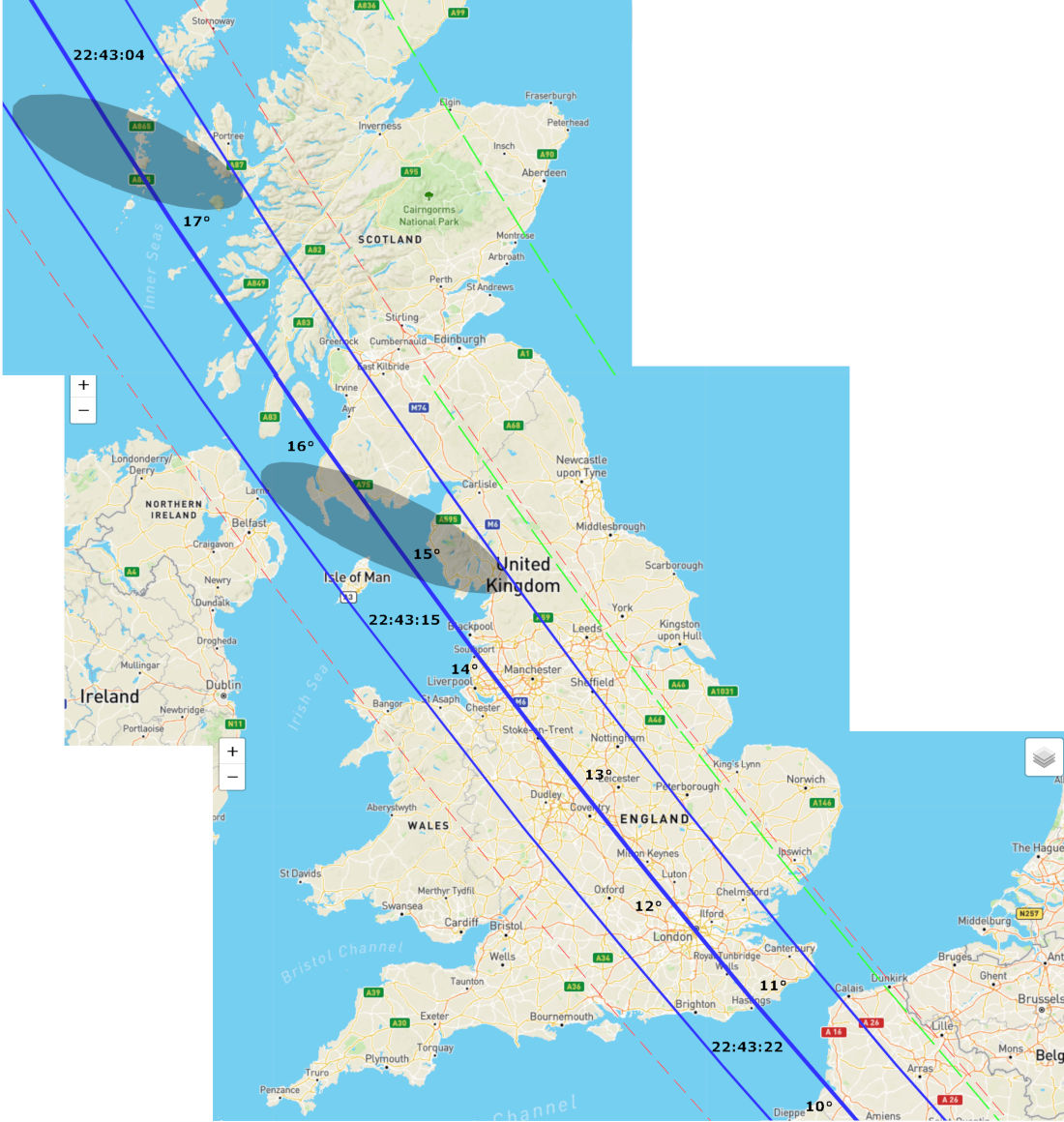
2023 May 01 – Mini-outburst on April 27
Thanks to Eric Watkins imaging with iTelescope’s T21 instrument in Utah, another weak mini-outburst has come to light. This has now been confirmed. It came just 4 days after the previous event. This type of behaviour can herald another especially strong outburst (>2.5 mag amplitude), of which we have only had one (a double eruption separated by 6 days) since October 2021. It seems that the unprecedented quadruple event of 2021 Sep 25-27 has taken the wind out of 29P’s sails these past 18 months!
2023 April 24 – Another mini-outburst yesterday
Thanks to Matt Dawson taking the trouble to observe in difficult conditions, namely high winds, he has recorded the latest outburst of 0.57 mag amplitude. This has been confirmed using accurate photometry on the 1.0-m LCO network in images taken from Texas thanks to Maria Eleftheriou, and also imaging by Patrick Wiggins in Utah. Thankfully, the time of outburst has been constrained to about ±5 hours since earlier images were obtained by Richard Miles using iTelescope’s T30 instrument in bright evening twilight from Siding Spring, Australia earlier yesterday.
This outburst occurred just as the coma faded and reached an intensity equal to 2.08 nucleus-equivalents. See the April 07 plot below for reference as to what this means.
2023 April 20 – What happens if the flow speed of ejecta does not exceed the escape velocity?
Thanks to the Faulkes Telescope Comet Observers group, frequent coverage of the quiescent nucleus when very faint has revealed a temporary brightening of the innermost coma as imaged with the 2.0-m Faulkes Telescope North on Haleakala in good seeing. Following a request, four members of the group obtained 1.0-m and 2.0-m images which have been analysed using multi-aperture absolute photometry. Here’s the plot so far:
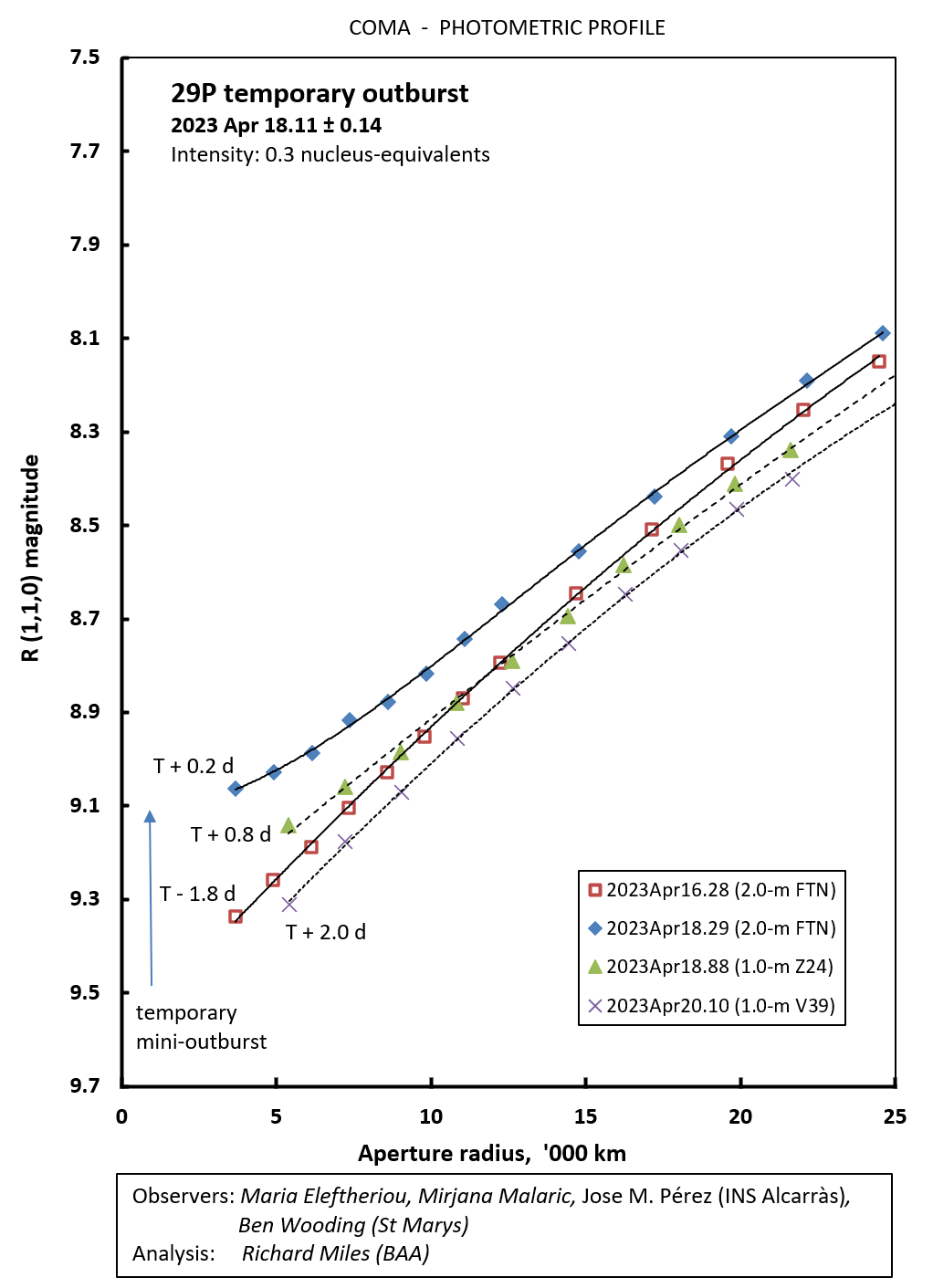
The image obtained on 2023 April 18.29 by Jose M. Pérez (INS Alcarràs) showed a 0.12 mag increase in a standard size aperture (5.7″ radius = 26,400 km), which when extrapolated to within a few thousand km of the nucleus equated to a 0.3 mag brightening (~30% of nucleus brightness). [Inspection of the individual pixel values showed no evidence of any cosmic ray noise within the area of the comet] Within 18 hours of the event happening, the enhancement had virtually disappeared indicative of fallback onto the nucleus. Presumably the stream of material ejected into space mostly failed to reach escape velocity (~25 m/s) and so was drawn back by the gravitational influence of the 60-km nucleus. This behaviour is only ever likely to happen with the weakest events. With strong outbursts, the median speed of the ejecta is more like 80-100 m/s and so only a small fraction falls back.
2023 April 07 – What triggers an outburst? – Some statistical evidence
Although Wikipedia currently states that 29P outbursts 7.3 times per year on average, this is far from the truth!
Since mid-June 2017, we have documented 143 outbursts (47 strong events and 97 mini-outbursts), which equates to an overall rate of about 30 per calendar year (allowing for the times when 29P is in conjunction with the Sun and hence is unobservable). Not only do we time outbursts and measure their intensity, we also obtain photometry just prior to each outburst (typically within <1 day of the event). BTW: Our median timing accuracy is 0.18 days thanks to intensive monitoring by observers.
Recently, 29P has been behaving in almost a clockwork fashion — as the inner coma fades, it seems to reach a limiting brightness such that another outburst takes place within just a day or two. Here is a plot that illustrates this non-random behaviour linked to the triggering of an outburst:
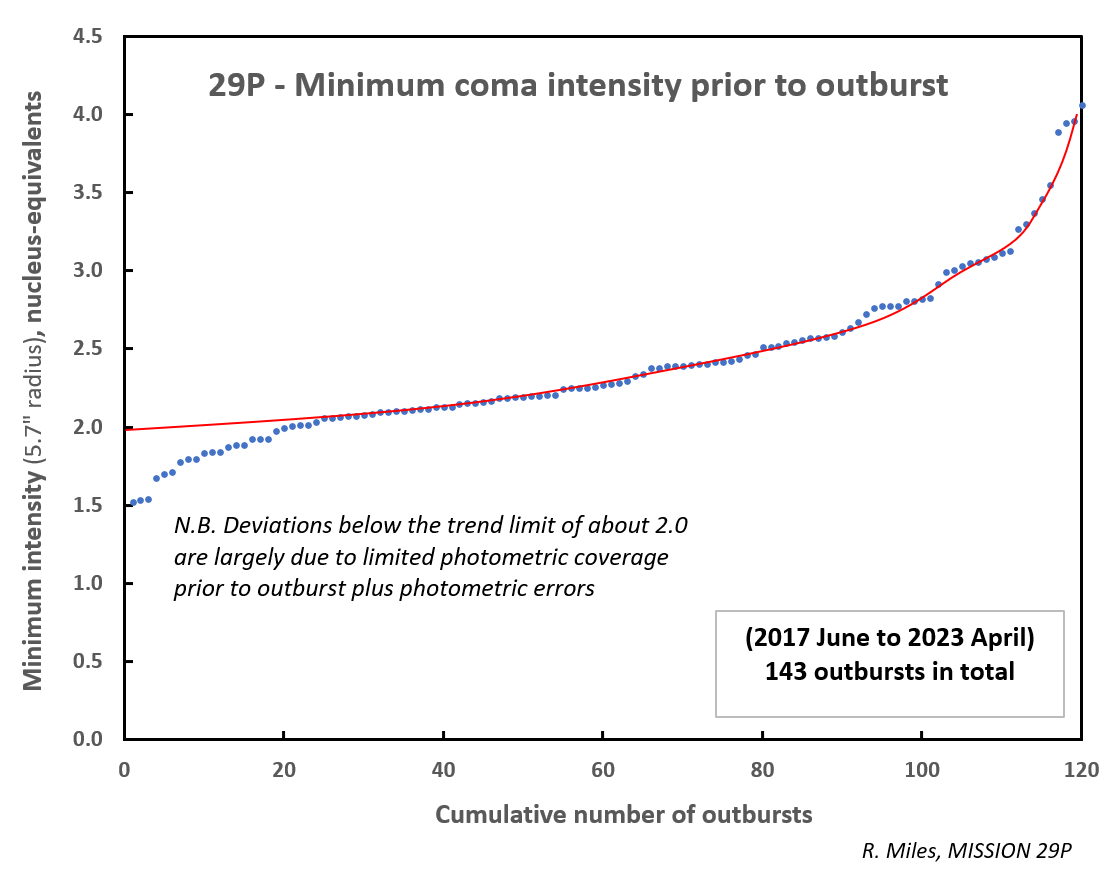
Given that outbursts are all or nothing — once material is released, the vent appears to seal within a fraction of an hour, the ejecta expand into space and the rate of fading generally follows an exponential decline towards the limiting value of about 2 nucleus-equivalents (5.7 arcsec radius). There is no intermittent activity. One interpretation of this behaviour is that the crust is consolidated and that the rate that gas is forming beneath it is greater than the leakage rate through porous regions within it. So pressure builds up beneath the crust until another mini-outburst erupts, rather like a cryogeyser. It will be interesting to see the findings from the James Webb Space Telescope which observed 29P at one of these critical times of quiescence about 30 hours before its next outburst. I expect the coma to have quite a low dust-to-gas ratio when in this low state since gas ought to percolate through a consolidated crust much more easily than dust. We shall see!
2023 April 02 – New strong outburst!
We have been watching 29P especially closely in recent days because the pseudo-nucleus has become very faint indicative of the crust sealing and preventing outgassing more than usual. In fact, 2.0-m multi-aperture photometry indicated the nucleus, and the region within a few hundred kilometres of it, was the faintest we have ever seen it [ R(1,1,0) = 9.94 ]. We know this thanks to postgrad student Cai Stoddard-Jones, who obtained crucial images less than 24 hours before this latest outburst, which was considered to be highly likely to happen. Thanks to Juango Gonzalez and Eric Watkins we have narrowed the time of outburst to an accuracy of ±3 hours.
Discovery images of this latest outburst were obtained by Maria Eleftheriou and Jose Manuel Perez Redondo earlier this morning using both the 2.0-m Faulkes Telescope South and its twin robotic scope on Haleakala, Hawaii. This is a strong outburst (2.0 magnitudes amplitude) as predicted: in this case the ejecta from the nucleus were so intense that the new outburst coma now reflects more than 10 times the light reflected by the nucleus alone. Here is a stacked image using the three exposures scheduled by Maria:
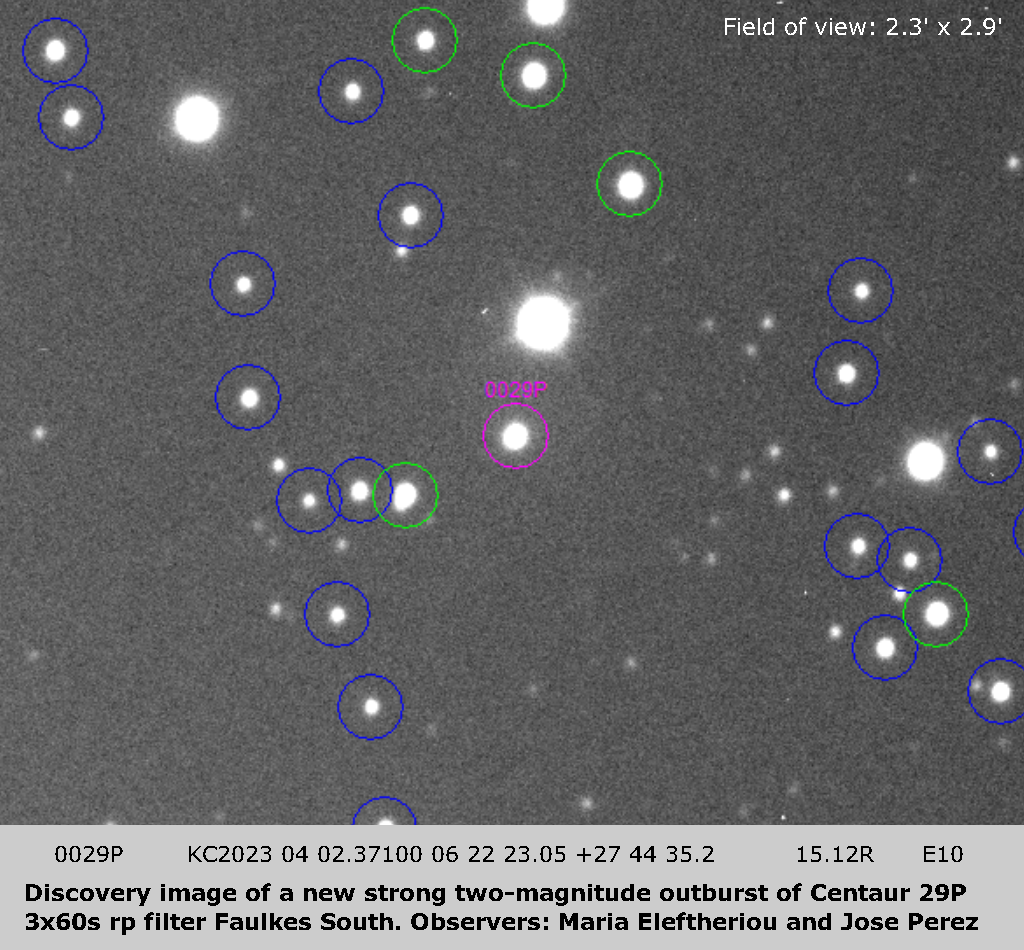
2023 March 21
We have had a 0.9-mag eruption within the last 24 hours, the first for some 28 days. Follow-up observations are encouraged.
2023 March 18
Latest photometry shows a continual fade having now reached almost magnitude 17.1R. There is a good chance that a new mini-outburst will happen in the next few days.
2023 February 28 – Example of archived observational data
Here is an example of the summarised epoch data corrected for differences in measuring aperture size starting just after the latest outburst of 2023 February 21.5. We have 664 observation lines in total this apparition with a few months to go before it ends. So far there are 3018 observation lines in the main spreadsheet.
Note that the data listed in Columns A to R are derived from the first line of observational data, the whole series of which have been averaged in Columns S to Y, the latter corrected for photometric aperture size.
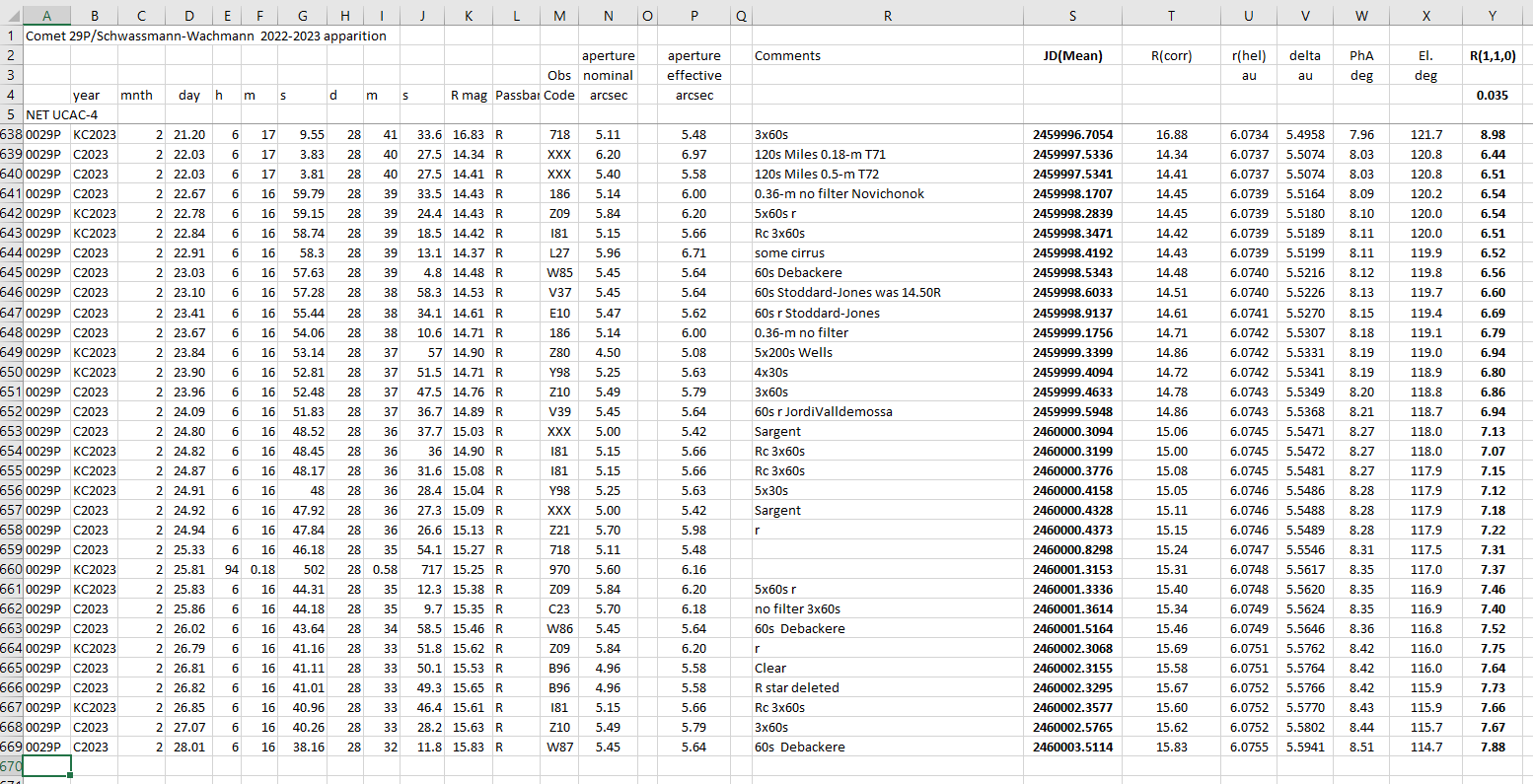
Here as an example are the individual lines of source data around the time of the 2023 02 21.50 outburst:
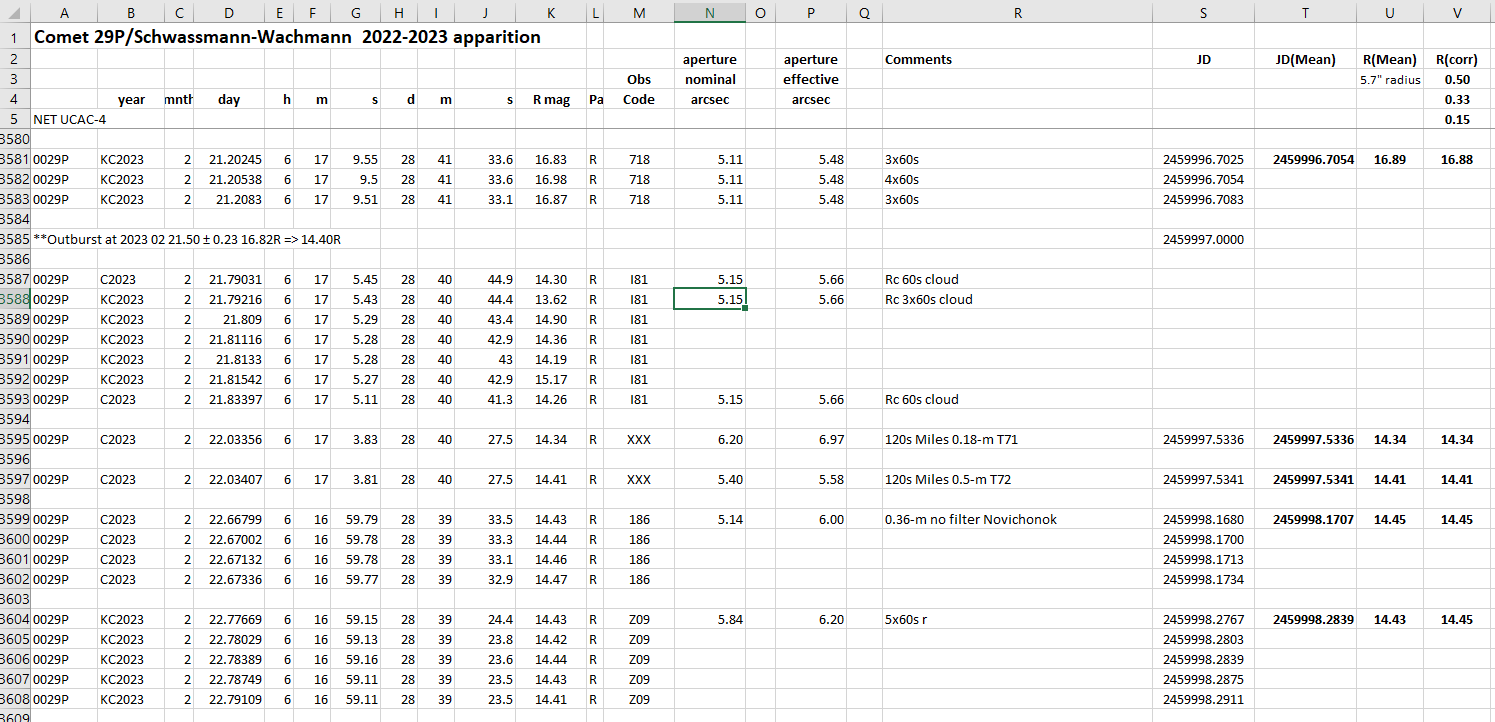
2023 February 24 – Two strong outbursts separated by 57 days
The last two strong events have been these:
Outburst at 2023 02 21.50 ± 0.23 16.82R => 14.40R
Outburst at 2022 12 26.73 ± 0.07 16.40R => 14.20R
Time difference = 56.77 ± 0.25 days
Although this time may be indicative of the same source erupting after one rotation of the nucleus, the outburst comae in the two cases appear rather different:
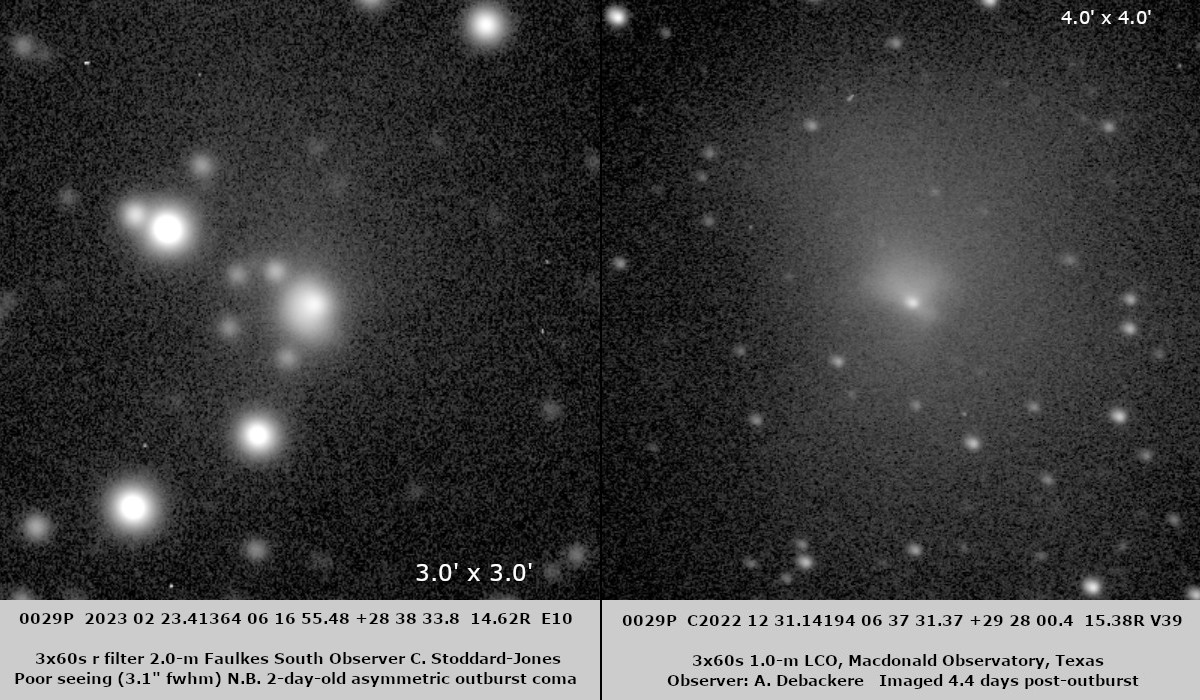
February 22 – JWST successful shortly before a new outburst!
JWST has has taken 8 x 525 sec spectral ‘maps’ (0.6 – 5 micron, resolution ~100) of the central 3 arcsec region (resolution ~0.1 arcsec) at 2023 February 20.14-22 when the nucleus was in its low activity state.
29P never switches off completely since gas and dust escape and maintain a weak coma at all times. So JWST will probe the immediate environment whilst the nucleus was in that low state.
Denis Buczynski, observing from Portmahomack, Scotland, has subsequently discovered that 29P has had a strong outburst reaching about 14.3R ~30 hours after the JWST’s observations. Here is recent photometry showing this:
0029P KC2023 02 21.20830 06 17 09.51 +28 41 33.1 16.87R 718 5.11″ (5.48″) 3x60s Wiggins
**Outburst at 2023 02 21.50 ± 0.23 16.80R => 14.3R (provisional)
0029P KC2023 02 21.79288 06 17 05.42 +28 40 44.4 14.2 R I81 5.15″ (5.66″) Rc 5x60s Buczynski
0029P C2023 02 22.03407 06 17 03.81 +28 40 27.5 14.41R XXX 5.40″ (5.58″) 120s 0.5-m T72 Miles
Confirmation was possible thanks to the use of iTelescope’s facilities in Chile.
Especially interesting is the fact that the last time 29P outburst so strongly was on 2022 December 26.73±0.23 when it reached 14.20R. The gap between these events is 56.77±0.25 days showing yet again the persistence of the 57-58 day periodicity in its strong outbursts, indicative of the rotation period of the nucleus.
2023 February 19 – JWST to observe 29P on 2023 02 20.14 to 20.22
James Webb Space Telescope is scheduled to observe 29P/SW1 starting at 2023 February 20 at 03:20 UT and ending around 05:18 UT. It will use the NIRSPEC IFU instrument that captures 900 simultaneous spectra over most of its 0.6–5.3 μm wavelength range where NIRSPEC is sensitive. The total area mapped comprises a square just 3 arcsec x 3 arcsec centred on the nucleus. Each element of the array measures just 0.1″ x 0.1″.
It is rather disappointing that 29P has been fading and it looks like it will be essentially quiescent when JWST takes a look and so we may not discover so much of what lies behind its bizarre behaviour. A large proportion of the hypervolatile gases that power its sudden eruptions travel at speeds of 0.3-1.0 km/s and so with JWST’s window opening 5.7 days after its last eruption there will be time enough for these to disperse.
On the other hand, one characteristic of 29P/SW1 is that it steadily outgasses through the crust, which process maintains a faint coma at all times. It is this environment that JWST will probe. Here is the overall lightcurve to date, with the last datapoint some 8 hours prior to the start of JWST coverage. 29P is clearly quiescent so the findings should be a fair representation of the object in its low state of activity. Click here for the latest plot and observations.
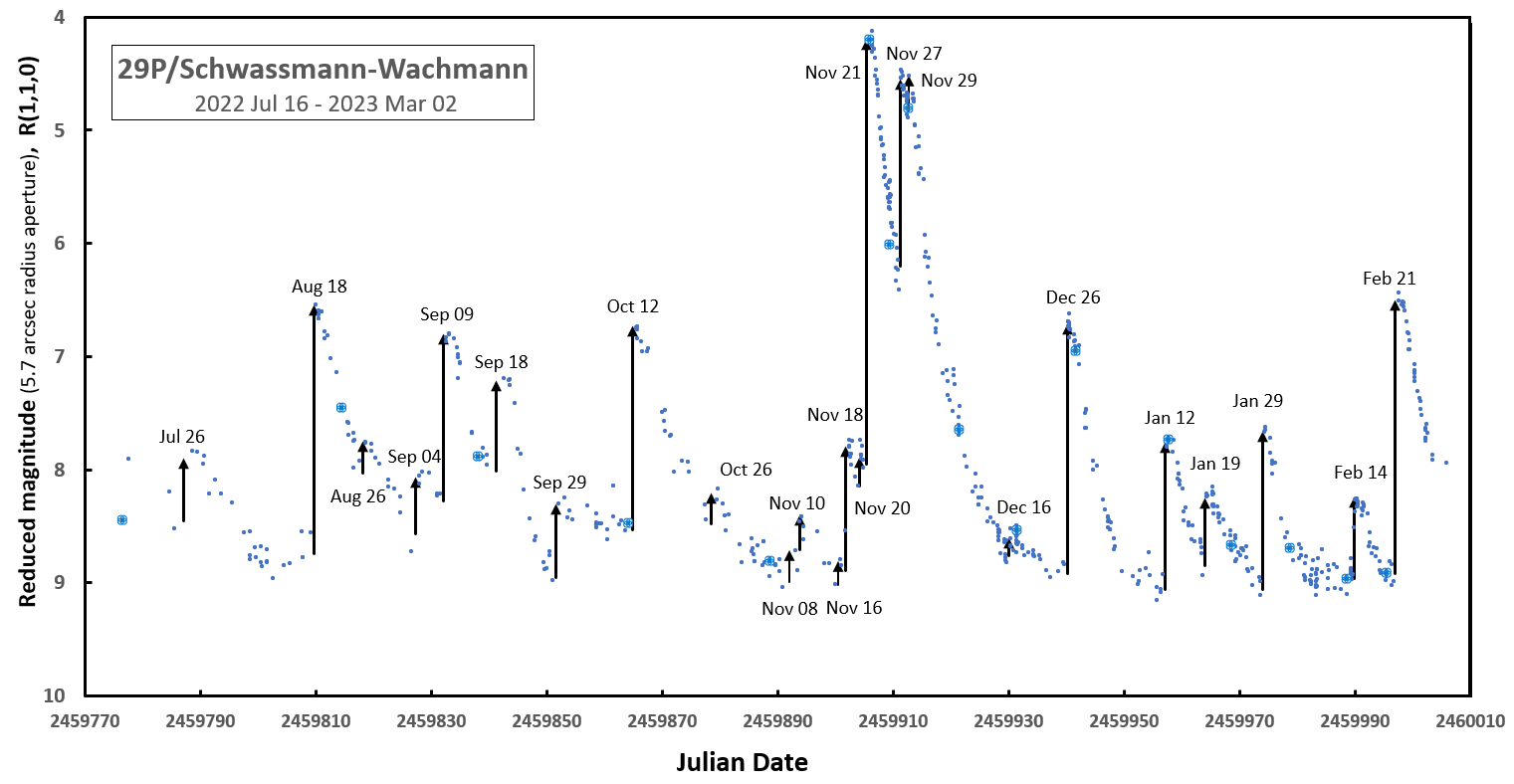
2023 February 18
Deep image showing mini-outburst coma from February 14.42 event
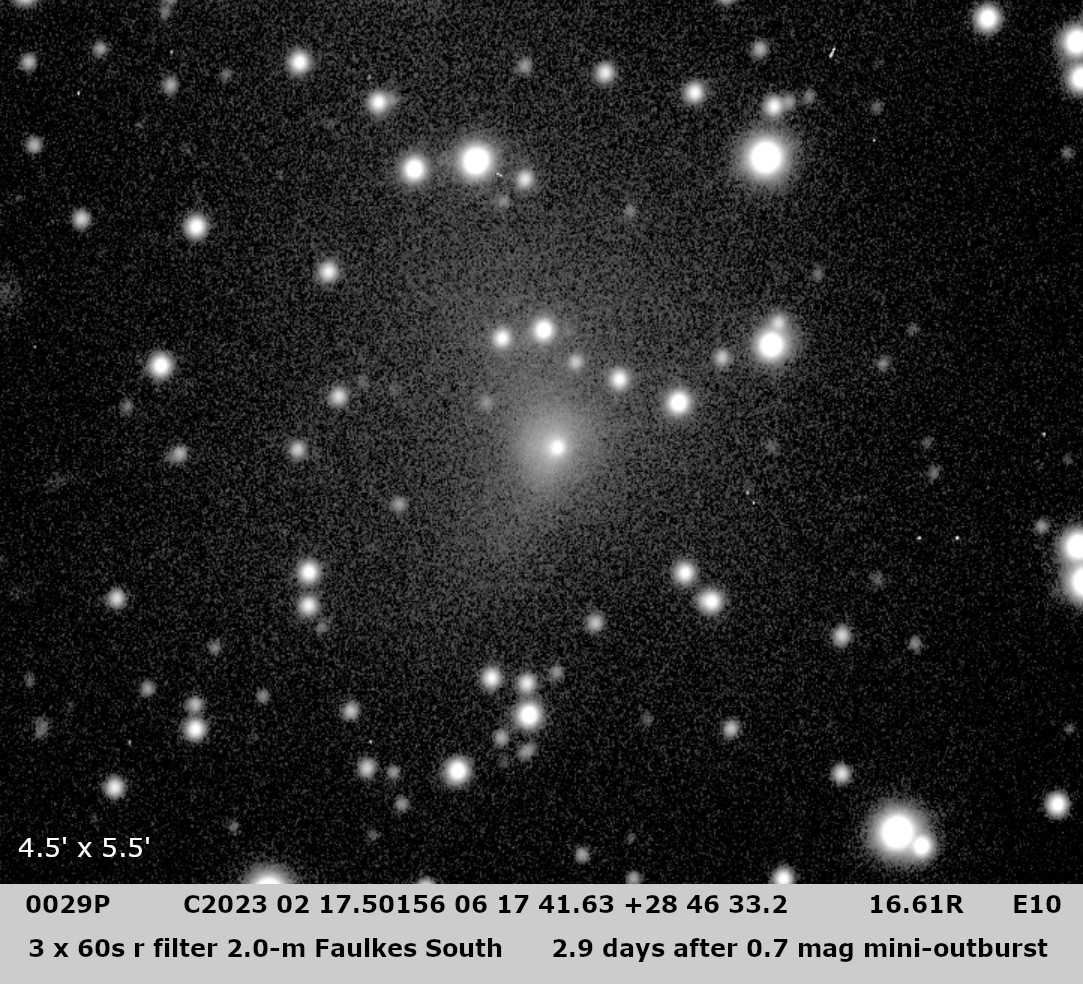
2023 February 15
Another mini-outburst about 0.7 mag amplitude has just taken place. Timing is very accurate owing to the fact that observations were made from iTelescope’s T30 0.5-m aperture instrument at Siding Spring whilst the event was unfolding!
We also have 2.0-m images taken from Siding Spring just 2 hours after the start of the event.
Coverage was very good thanks to Denis Buczynski in Scotland, Guy Wells in England, Patrick Wiggins in Utah, iTelescope facilities in Utah and Australia (used by Richard Miles), the Faulkes Telescope South, and Wayne Hawley in England, who confirmed the sudden rise in brightness just 6 hours after the initial eruption.
2023 February 12
Fade continues 14 days since last significant event. Updated plot below with latest contributions.
2023 February 5
Faint asymmetric outburst coma about 7 days post-outburst. Thanks to Wim Cuppens we have this view of the new outburst coma despite the strong moonlight present:
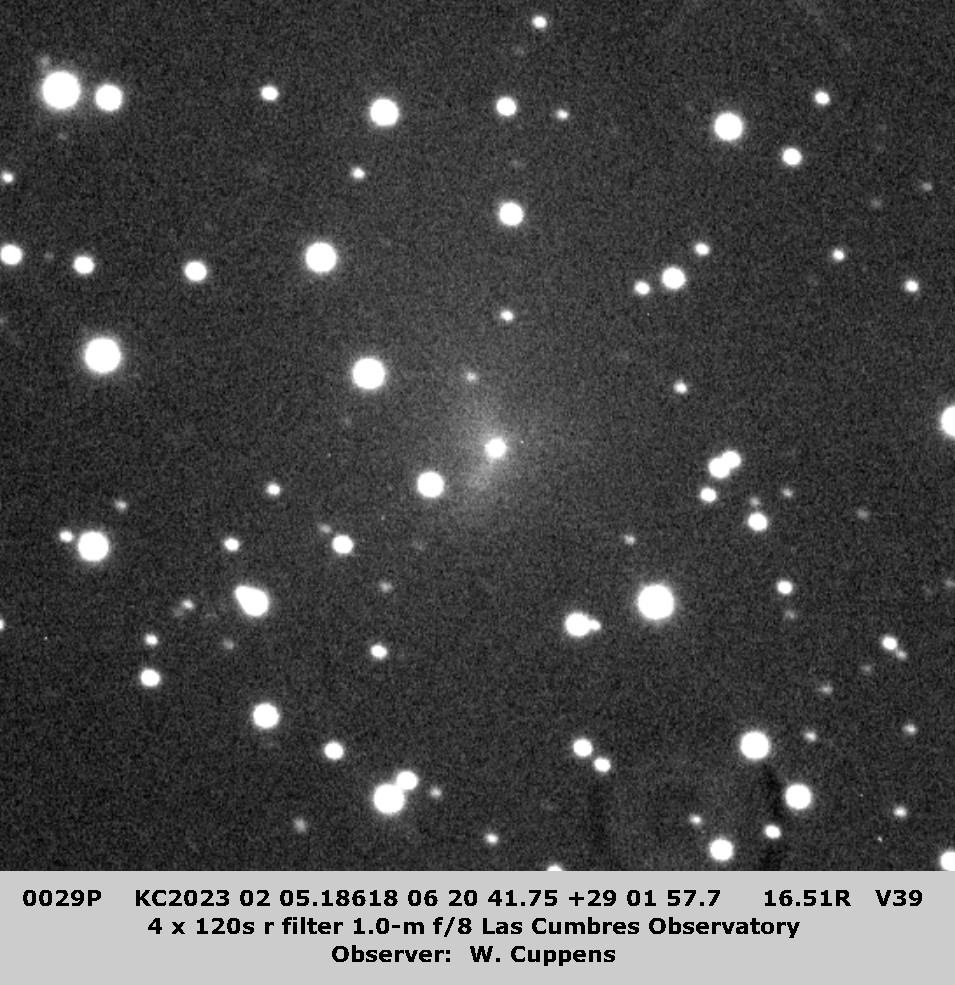
2023 January 29
New outburst discovered by Jean-François Soulier earlier today. More information to come. See latest lightcurve plot below.
2023 January 27
Here is a view of 29P immersed in its outburst coma most of which has originated from the strong outbursts of last November 21, 27 and 29. It was taken earlier today. The outer edges of the coma extend virtually to the edge of the 10′ square frame especially in the south direction.
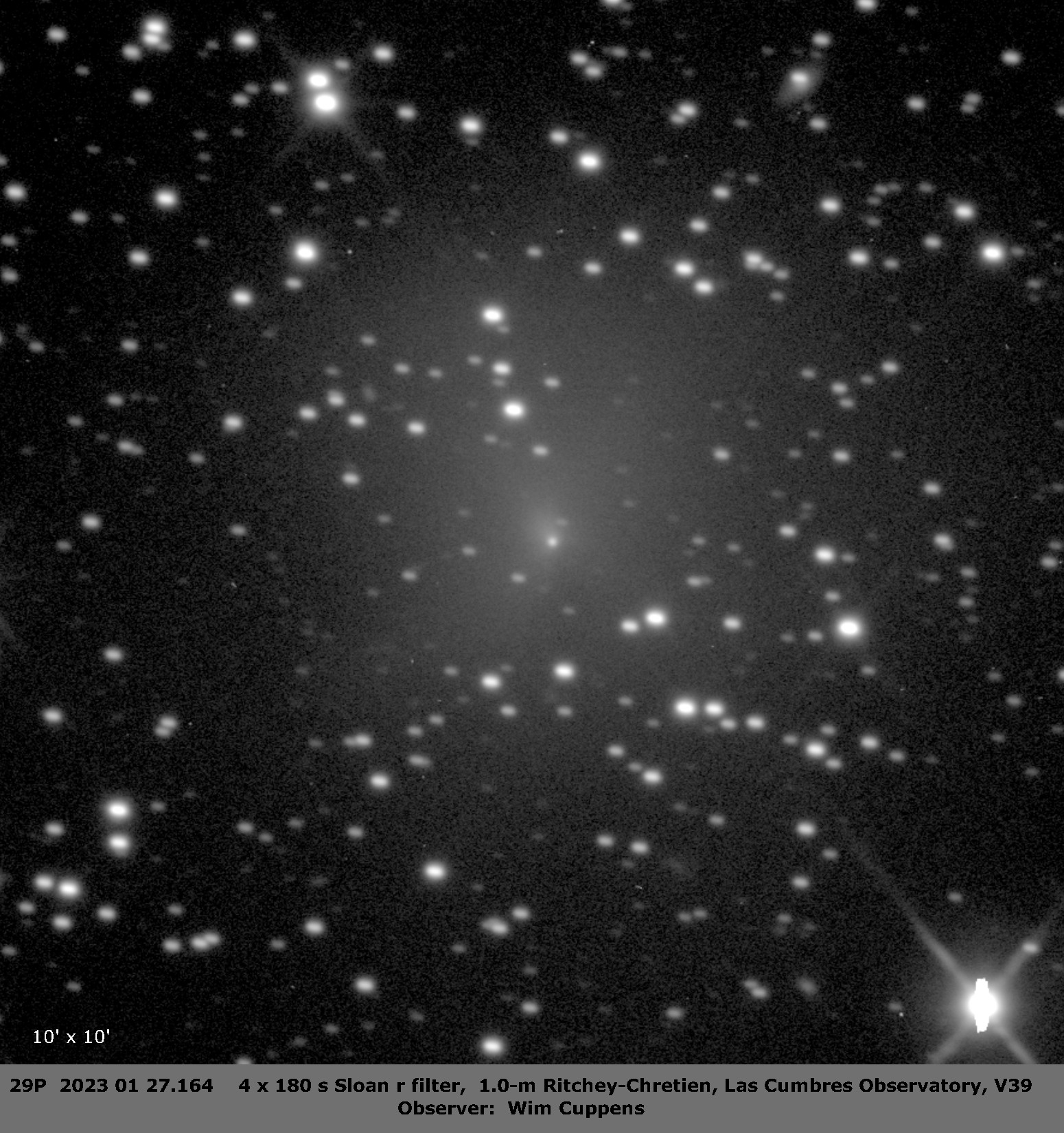
2023 January 21
Just 7 days have elapsed for the next event to take place, a mini-outburst of amplitude 0.6 magnitude r 1.7 nucleus-equivalents. Patrick Wiggins imaged it faint on January 19.11 whilst Adrian Jones imaged it bright at January 19.76, constraining mid-time to January 19.43.
2023 January 13
Another outburst has been picked up some 17 days after the previous. Amplitude is just 1.3 mag so we may expect a further event soon.
2023 January 11
29P has faded and to reach its steady-state quiescent state at around 17.05R in a 2.5″ radius measuring aperture. Unfortunately, a stellar occultation on January 09 near the southern California border with Mexico coincided with bad weather near San Diego and so far no reports have been received. In the last 5 or 6 days observations have been affected by strong moonlight, which has now come to an end so it will be a good time to watch out for mini-outbursts over the coming days.
End of 2022 update
Centaur 29P reached opposition on 2022 December 30.4 in the constellation of Auriga at a phase angle of 1.02°. We have detected 19 outbursts during the pre-opposition period, of which 8 have been strong eruptions (amplitude >1.0 mag or 4 nucleus-equivalents). The weak outbursts appear to represent a different phenomenon and recently we have witnessed few eruptions of intermediate intensity. The object is now well placed in the evening sky for close monitoring and our objective now is to have sufficient coverage to detect outbursts that are particularly faint. Of course we never miss any strong outbursts, which is testimony to the dedication of all our observers.
2022 December 28 – One positive observation of December 27 occultation
Although the weather conspired against most observers in the USA, Vadim Nikitin south of Roswell, New Mexico recorded a ~3.4 s (62-km) disappearance close to the predicted centreline despite clouds threatening to block his view.
2022 New strong outburst ahead of December 27 occultation
Discovered by Denis Buczynski from north-east Scotland, this event has been narrowed down in time to around 10 hours ahead of the occultation. We have received some excellent reports from observers confirming the outburst and showing it shining at magnitude 14.2R with the new outburst coma reflecting almost 15 nucleus-equivalents of sunlight. Postscript – Artyom Novichonok has observations from Uzbekistan which constrain the time of outburst further.
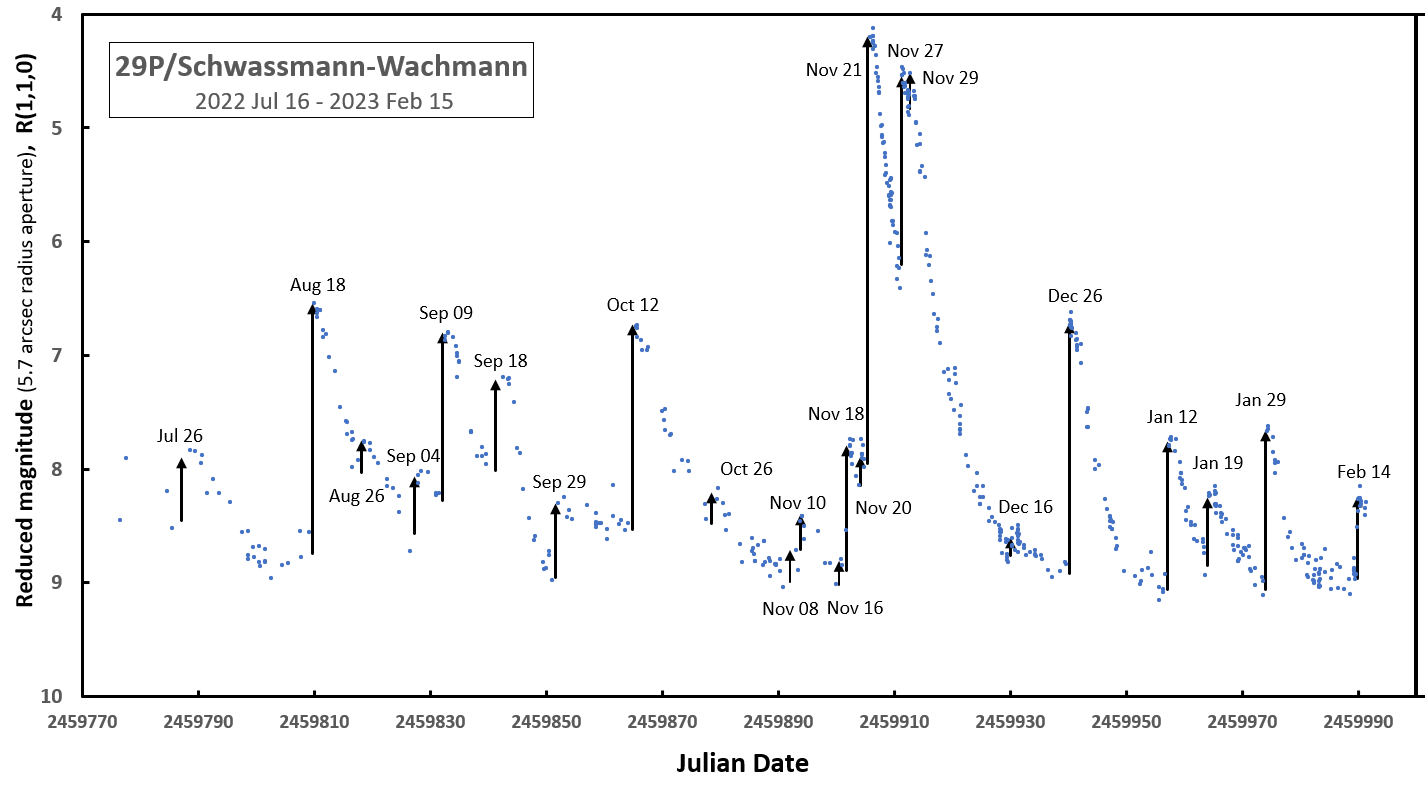
Preparing for the 2022 December 27.52 occultation
This event may prove to be the best this decade so observers please do try and cover it. It involves a 13th magnitude star and high accuracy predictions are available from the Lucky Star team. A video record, preferably with absolute timing, is required. Frame exposure times of 0.25 sec or shorter are recommended. The chart below is from Mike Kretlow’s Collaborative Occultation Resources and Archive (CORA). Current weather forecast indicates that the north-western part of the track north of the Grand Canyon will be plagued by cloud and some rain. New Mexico and Texas look to have clear skies early on the Tuesday morning. Predicted mid-times are:
12:20:12 UT San Antonio, TX; 12:20:22 UT Odessa, TX; 12:20:35 UT Socorro NM, and 12:20:42 UT Sanders, AZ.
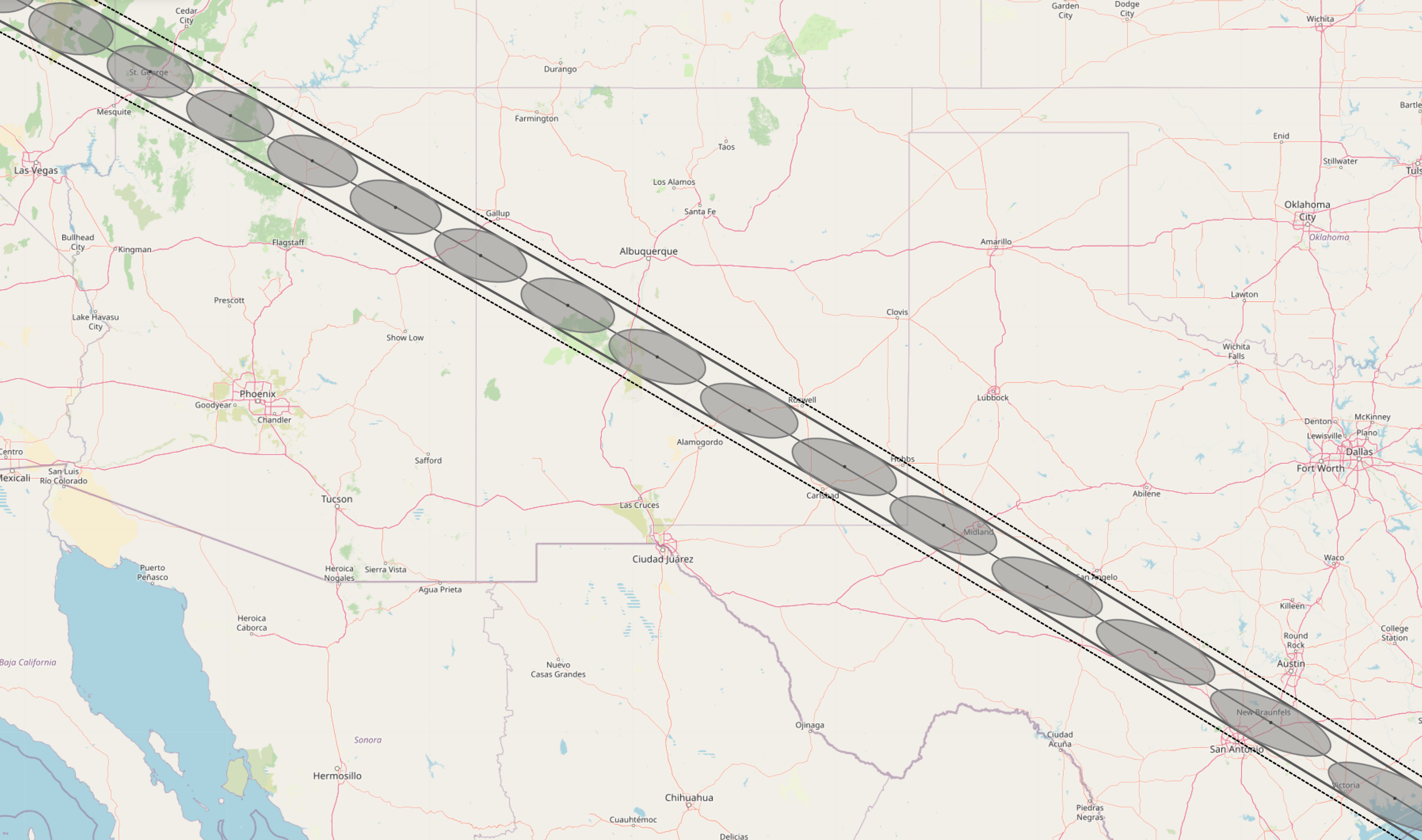
Occultation Success!
Bob Jones has made an initial report of a disappearance lasting 3.3 s from a location -17.7 km from the predicted centreline.
Norman Carlson was particularly lucky to record a short 1.5 s positive from +10.3 km off the centreline.
An initial look at these observations and those of a previous occultation seen from Cerro Pachón, Chile show they are consistent with a spherical body some 59-60 km in diameter. By some strange law of chance we have another favourable event on Dec 27.52 when 29P occults a 13th magnitude star as seen from very north of California, southern Nevada, central New Mexico and western Texas. This will be the best opportunity from N. America for many years to come. Here is a preliminary profile based on the December 19 observations:
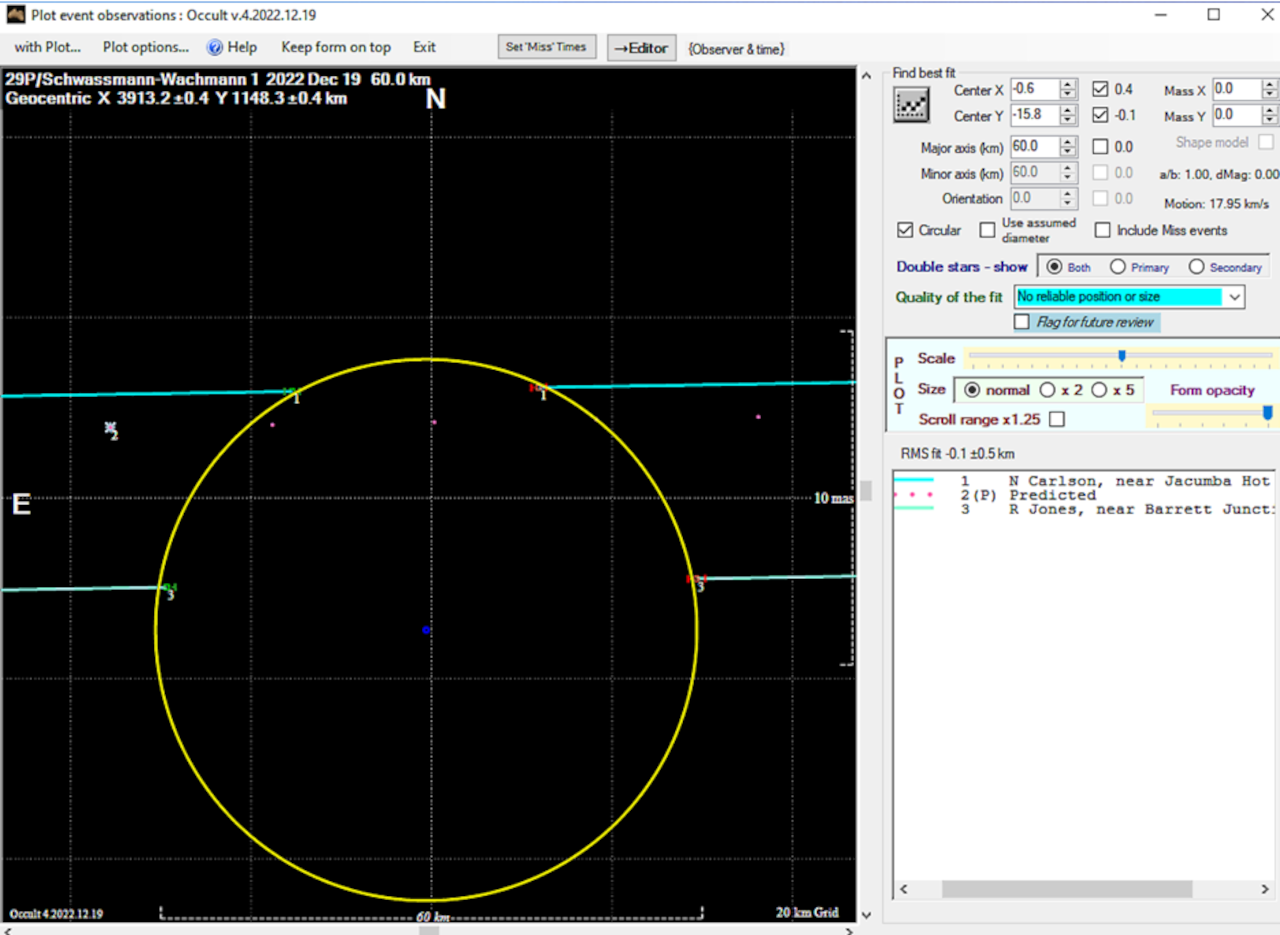
2022 December 19 update
Thanks to 1.0-m multi-filter imaging by André Debackère using the Las Cumbres Observatory network, we now have the BVRI magnitudes of the occulted star and that of 29P measured in a 5.8″ radius aperture seen <12 hours before the event. Patrick Wiggins has also imaged 29P just 4 hours ahead of the due time showing a slight fade of 29P to 16.3R in a 5.5″ radius photometric aperture. A total occultation will see the V or R light drop by 3.6 mag in an 11″ diameter aperture and 3.9 mag drop in a smaller 5″ one Here also is the latest 1.0-m colour image showing the star to be occulted.
occstar C2022 12 19.00083 06 43 51.06 +29 28 12.3 14.27B Z31
occstar C2022 12 19.00189 06 43 51.05 +29 28 12.3 13.23V Z31
occstar C2022 12 19.00299 06 43 51.07 +29 28 12.4 12.67R Z31
occstar C2022 12 19.00404 06 43 51.06 +29 28 12.3 12.09I Z31
0029P C2022 12 19.00299 06 44 06.59 +29 28 08.1 16.18R Z31 5.45″ (5.85″) Debackere
0029P C2022 12 19.00083 06 44 06.65 +29 28 08.2 17.50B Z31
0029P C2022 12 19.00189 06 44 06.63 +29 28 08.2 16.67V Z31
0029P C2022 12 19.00404 06 44 06.55 +29 28 08.1 15.63I Z31 NET USNO-B1.0
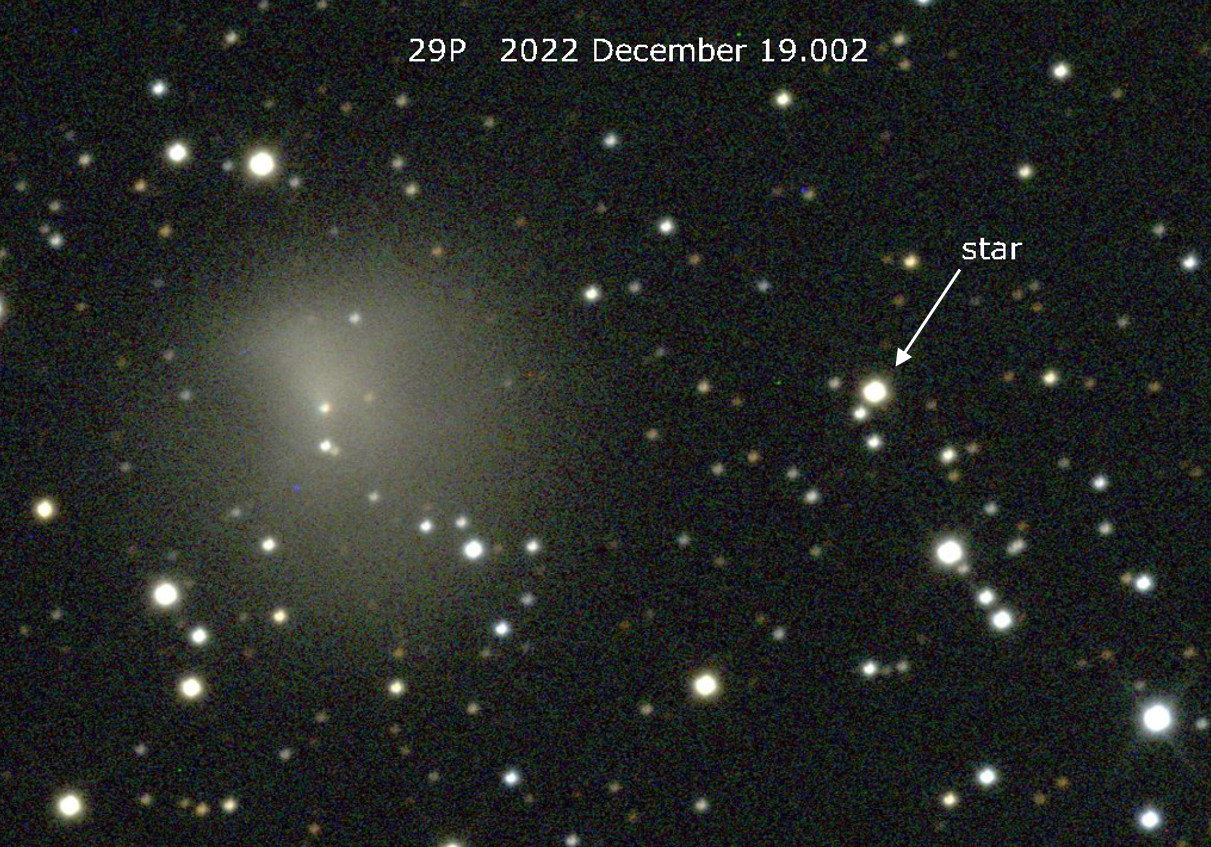
2022 December 18 update
A mini-outburst has taken place 1.92 ± 0.25 days ahead of the occultation. The amount of material lofted into space by the event is equivalent to a projected area of 0.4 nucleus-equivalents. There is a chance the occultation record will contain evidence of some of this material, a significant fraction of which should fall back onto the nucleus within 2-4 days. Here’s the photometry:
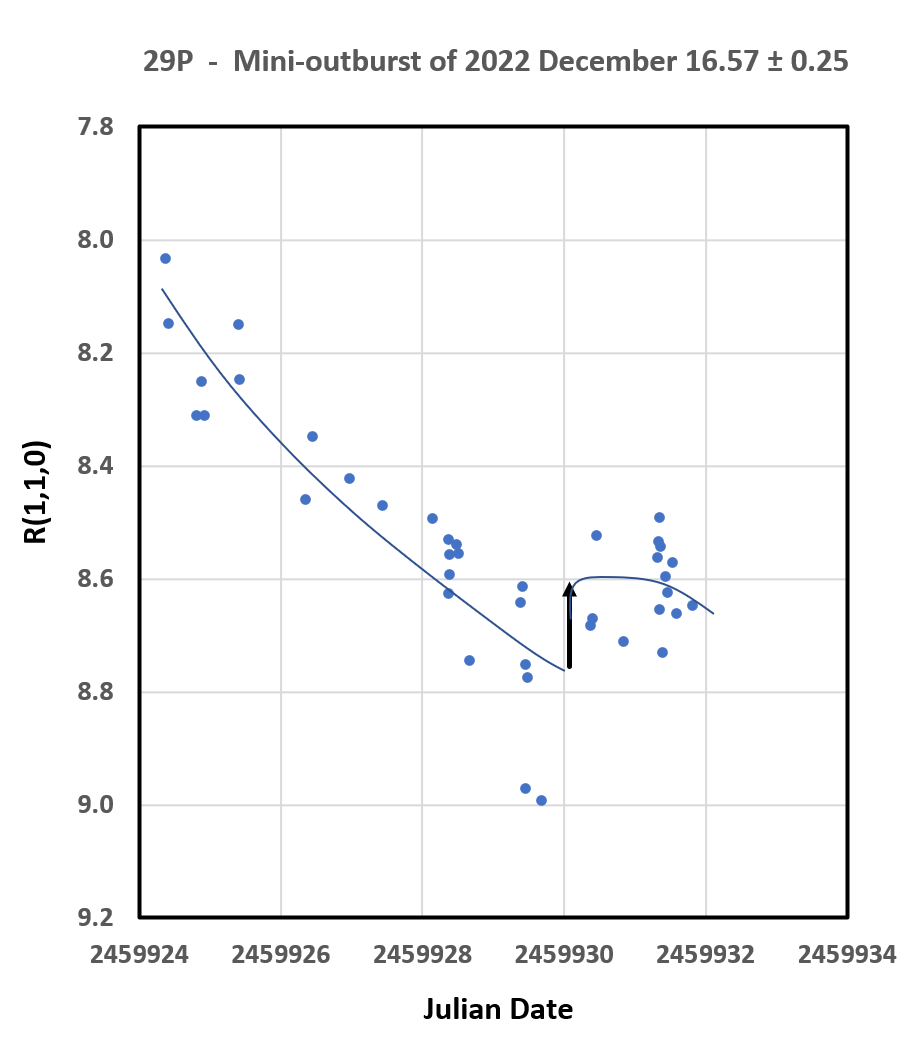
2022 December 19.49 stellar occultation information
An exceedingly rare stellar occultation of a 12th magnitude star by the nucleus of Comet 29P, the track of which passes over populated areas, is due between 11:44-11:55 UT on 2022 December 19 (Sunday night/Monday morning).
Mike Kretlow of CORA (Collaborative Occultation Resources and Archive) has provided these details:
Occultation Date + Time : 2022-12-19 at 11:49:22 UT +/- 0.06 min
Object Designation : 29P/SW1
Star Designation : GDR3 3386666379589120128
Star Coordinates (ICRF) : RA = 06 43 51.06, DEC = +29 28 12.1
Star Magnitudes : G = 12.94 mag, RP = 12.24 mag, BP = 13.48 mag
Object Magnitude : R = 16.6 mag (assuming no further outburst)
Estimated Magnitude Drop : 4.5 mag in R
Estimated Max. Duration : 3.6 sec
Object Mean Diameter : 64 km
Speed of the shadow : 17.7 km/s
Elongation to Moon & Sun : 115° (sunlit = 20%), Sun = 166°
Cross-track uncertainty : 5.9 mas = 21 km = 0.36 path-width (1-sig)
Mike has made available an interative map here:
https://astro.kretlow.de/cora/occultations/1bc3dc23-629a-4ecc-96a2-1ece73df41f5/
2022 December 15 UPDATE: The Lucky Star team observed a 29P occultation of a faint star on December 05 and this has led to a further improvement in the known orbit of the nucleus. Details including an iterative map can be found here:
https://lesia.obspm.fr/lucky-star/occ.php?p=121926
The occultation is predicted to cross Taiwan during Sunday evening (~11.54-11.55 UT on December 19, viz. night of Monday, December 19/20 local time):
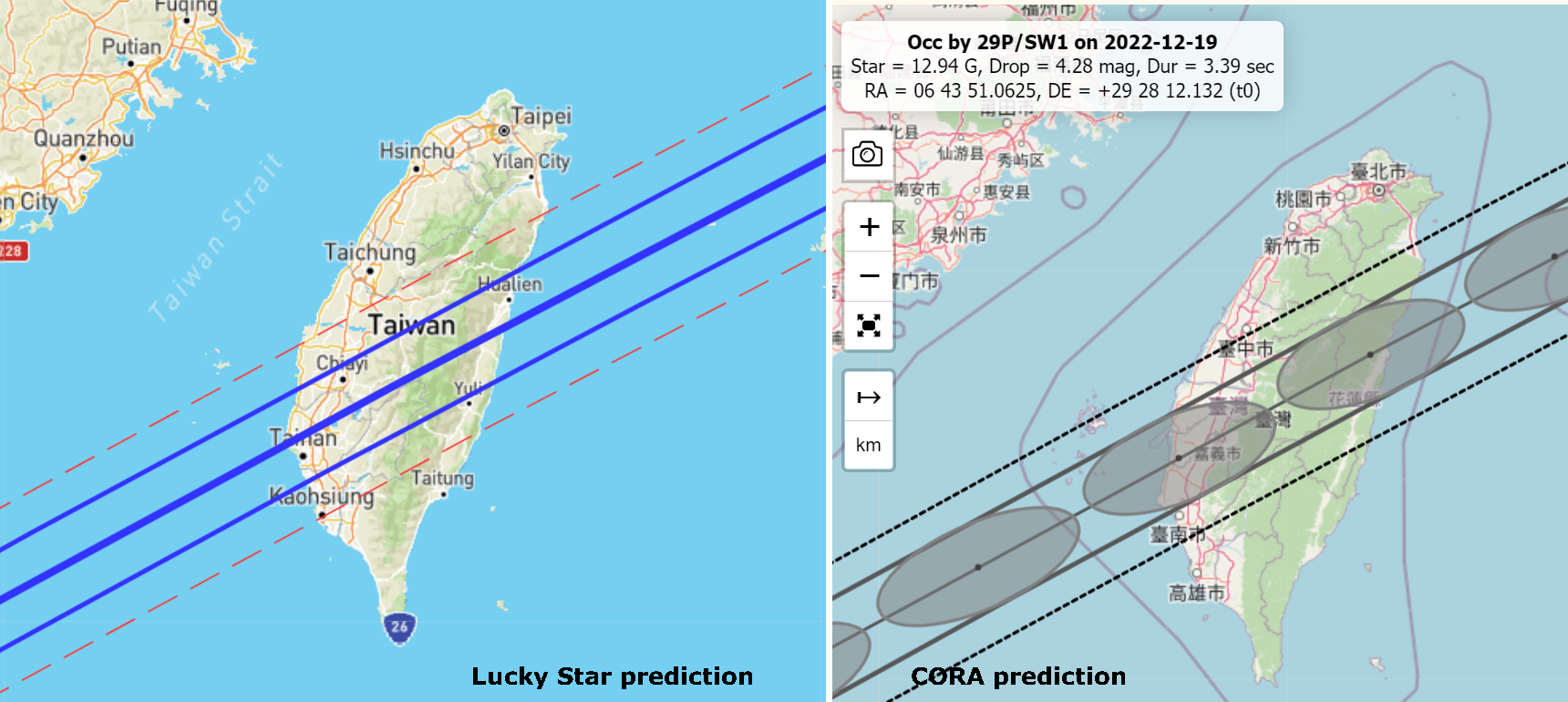
Earlier around 11.44-11.46 UT the path of the shadow track crosses close to the U.S. / Mexico border visible in the early morning sky Monday. The following maps depict the ground track with the Lucky Star one now indicating a southwards shift of around 60 km. In practice the uncertainties in the position overlap significantly.
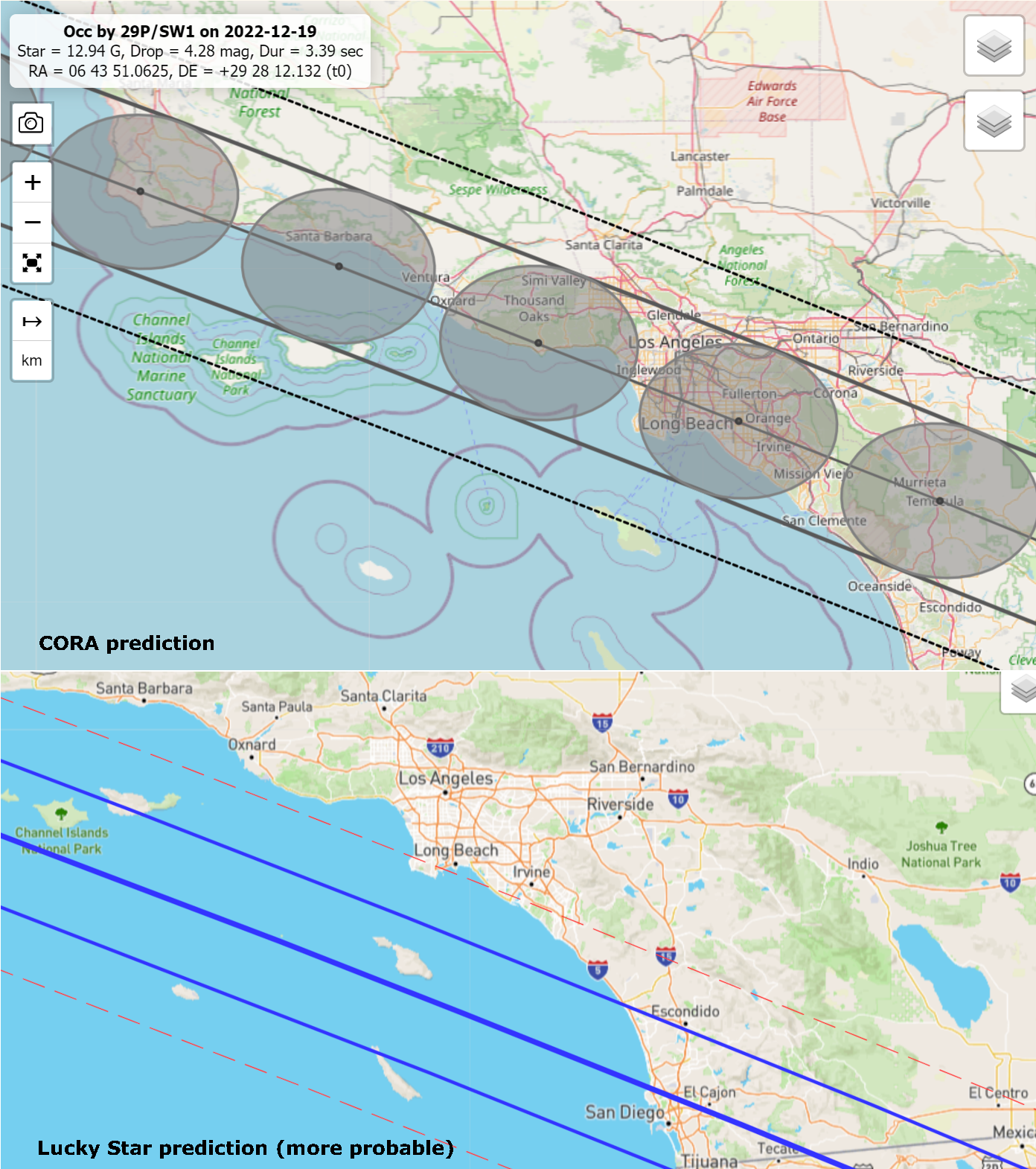
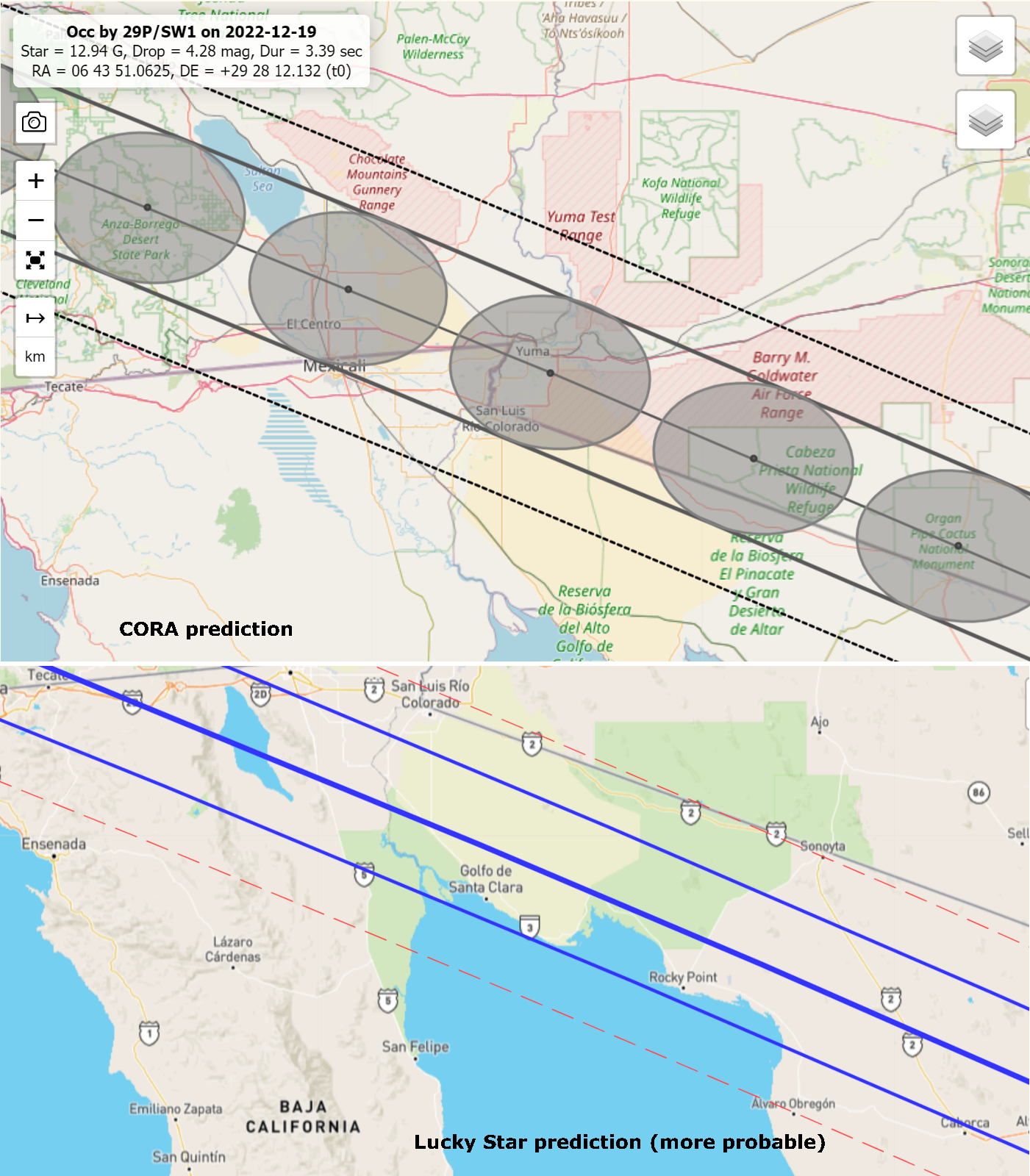
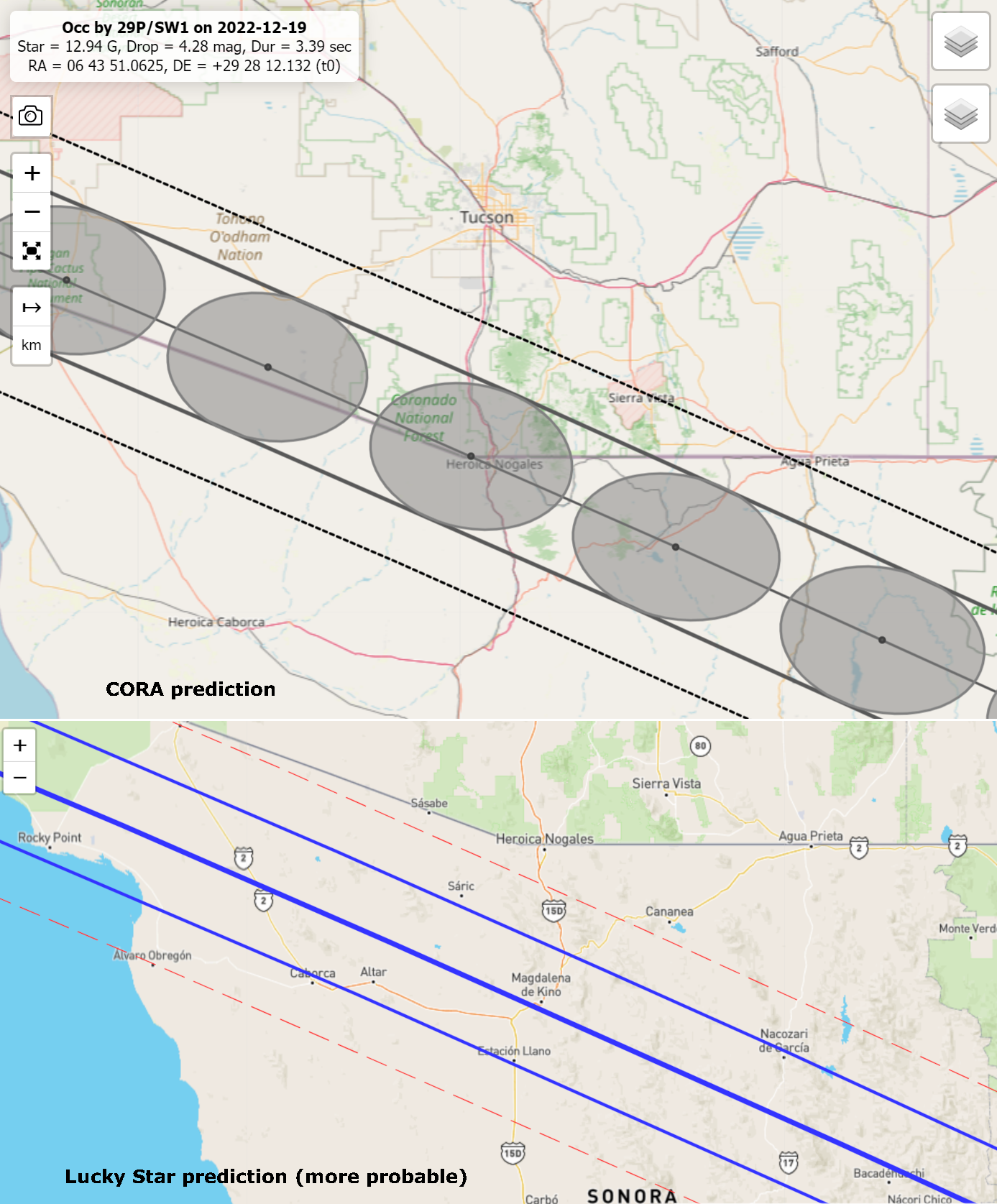
Observers many km away from the predicted track may detect attenuation of the star by a debris disk created by this comet’s outbursts. There is evidence that the nucleus is unusually spherical in shape and so observers are encouraged to obtain a video record of the event since this will readily test this inferred shape without the need for absolute timing accuracy.
2022 December 13
More 2.0-m images thanks to the Comet Chasers Group:
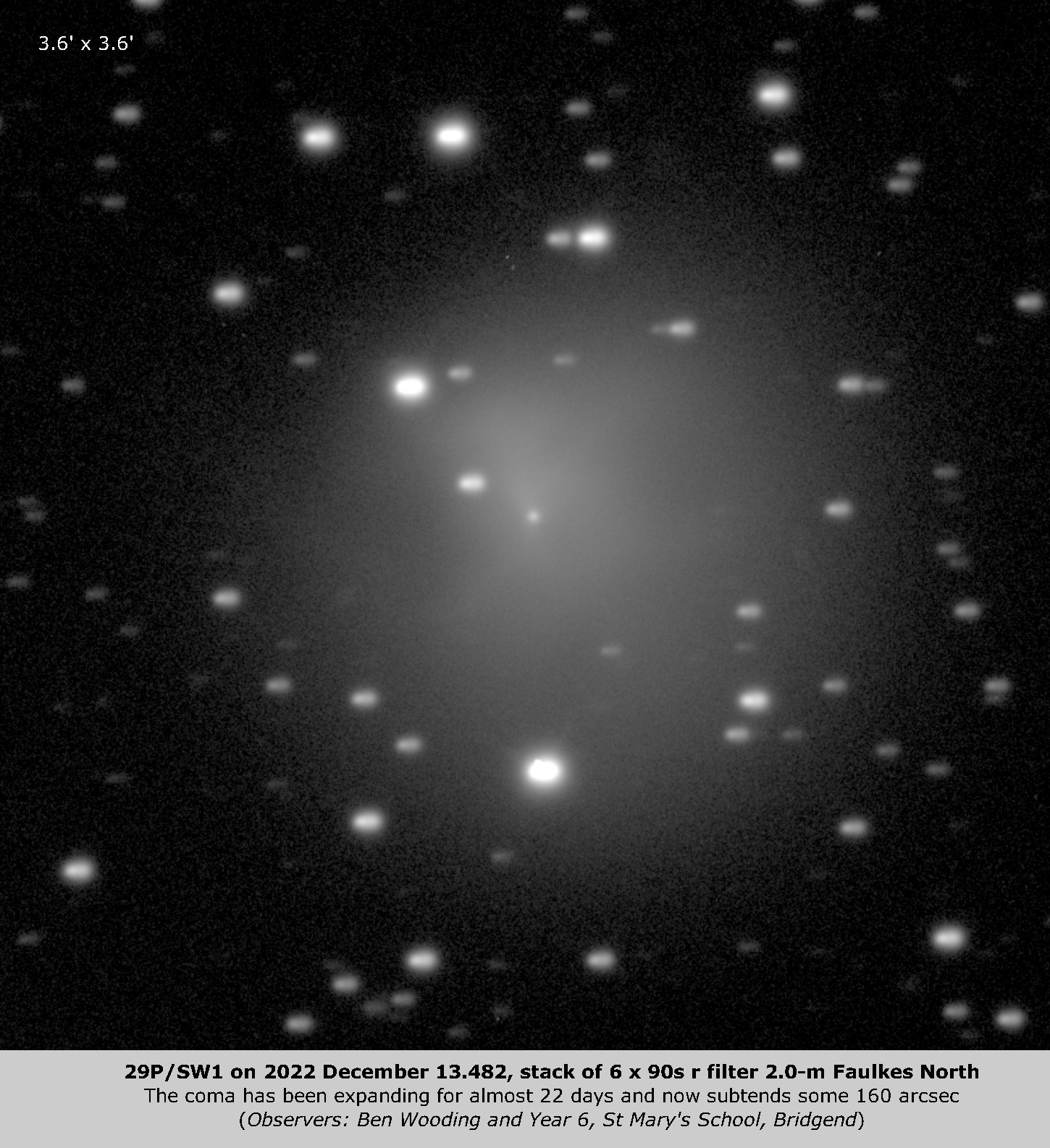
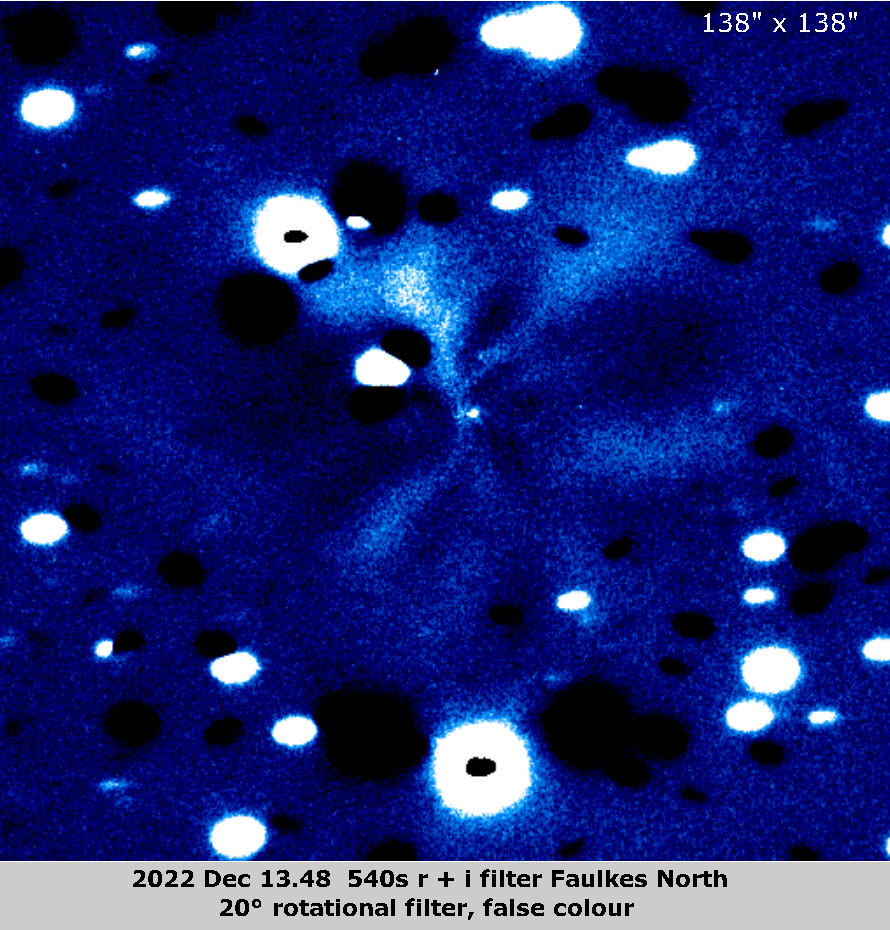
2022 December 12 — ALERT! Very favourable forthcoming stellar occultation on early morning of Monday, December 19
Here is a view of the evolved coma over 12 days after the last outburst, obtained by Jean-François Soulier last night from his robotic ’29PREMOTE’ observatory in Dauban, Haute Provence, France (L27). The pseudo-nucleus is now fainter than 16.0R, which bodes well for the forthcoming stellar occultation visible near the U.S.-Mexico border on 2022 December 19.49 involving a magnitude 12.2R star. High-precision astrometry updated to a few weeks ago and a recent occultation event has narrowed the uncertainty in the N-S track position shown below to a mere ±25 km (1 σ). N.B. The current JPL K192/76 ephemeris has the orbit displaced some 1300 km to the North of the actual orbit.
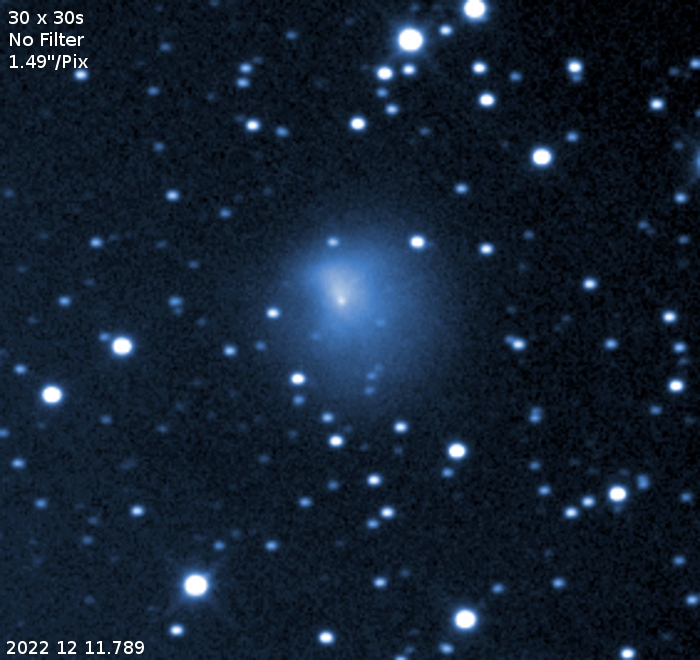
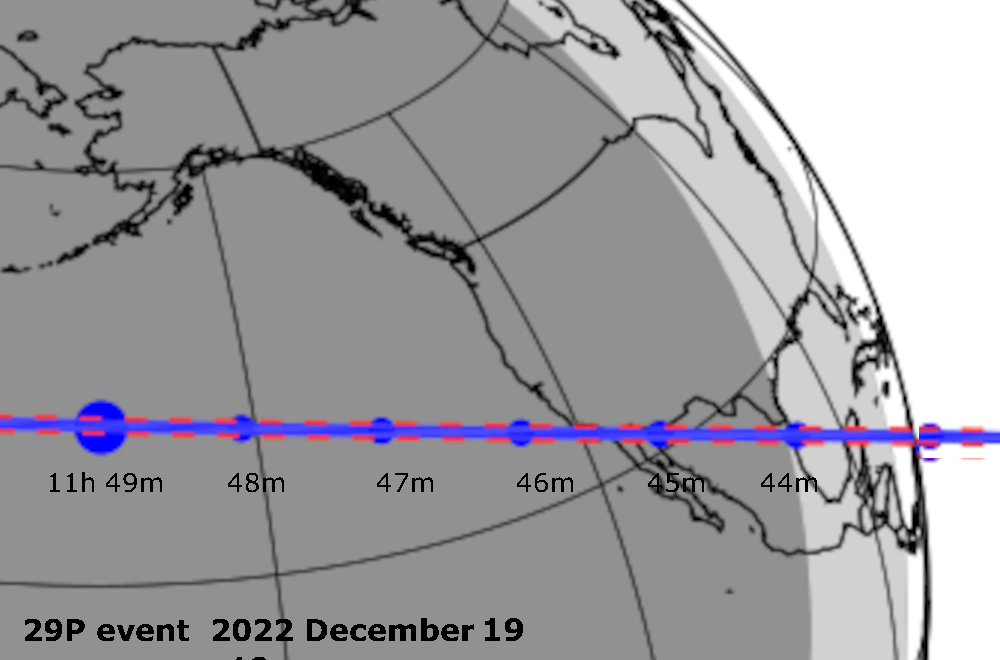
December 2
We have now obtained 2.0-m images taken earlier today by Mike Beer and Valentina Matei in good conditions after a long spell of bad weather, etc. The coma appearance is a composite result produced by the recent 3 strong outbursts. The grayscale image was taken almost 11 days after the initial major outburst and has been subjected to a logarithmic stretch to show the coma as it might appear visually through a very large telescope. The blue-white images are the same stack of 12 frames but subjected to a 15° rotational gradient filter using IRIS software and depicted in false colour. One noteworthy feature of the outbursts triggered by the initial event of Nov 22 is that a strong outflow is directed towards p.a. 30°, which is almost the opposite direction to the direction of mass flow from the initial event.
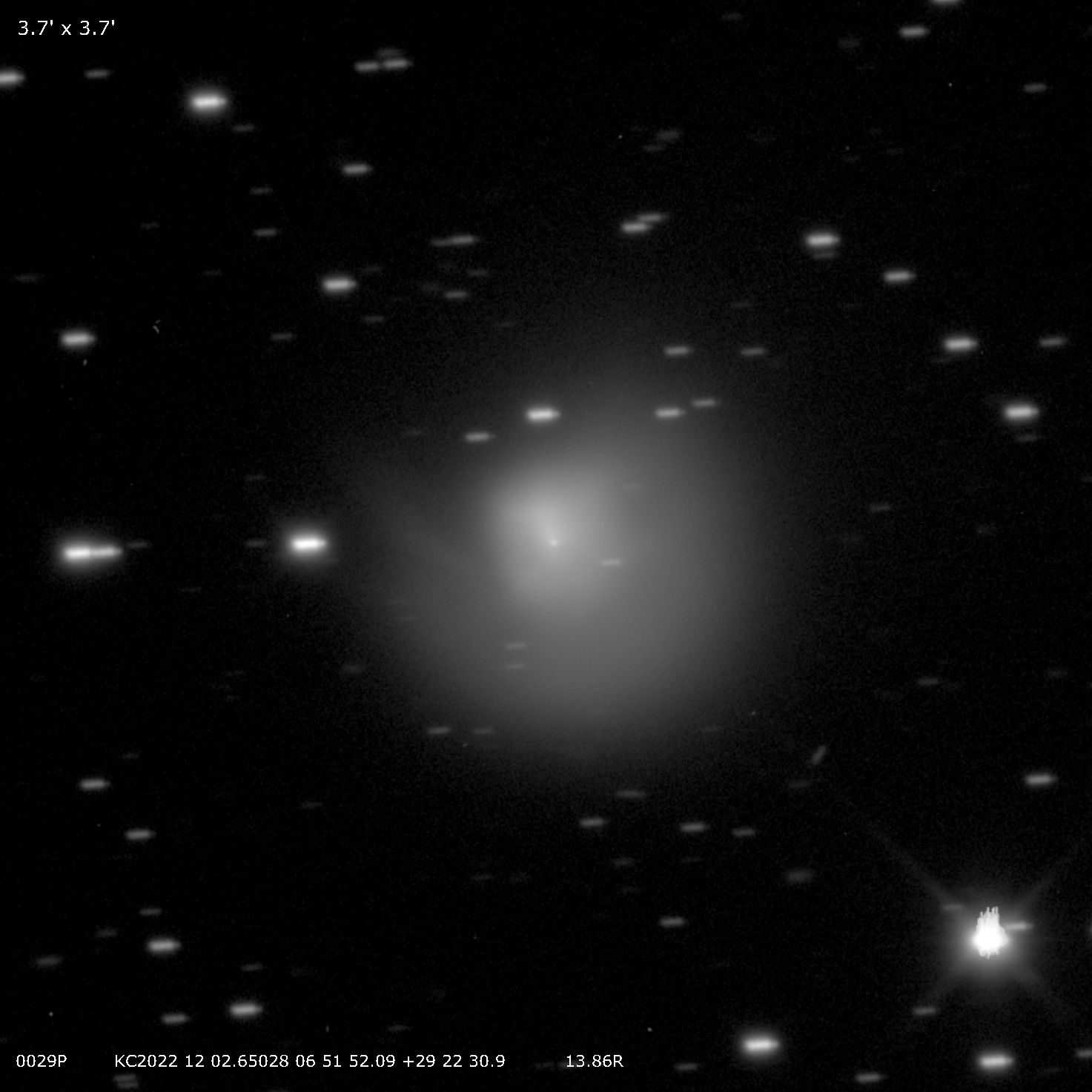
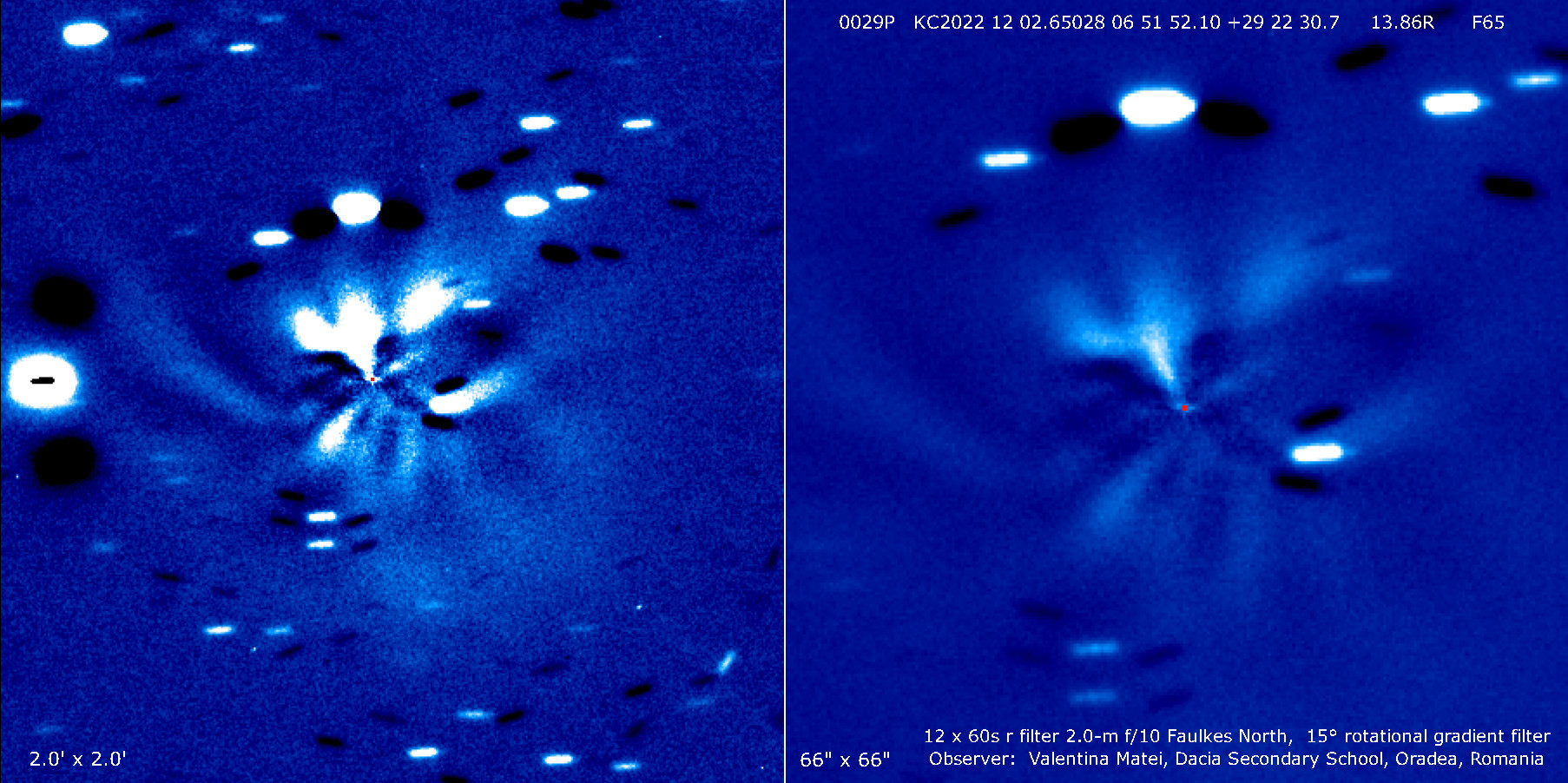
2022 December 1
Here’s an update showing the lightcurve depicting the third outburst and its subsequent evolution.
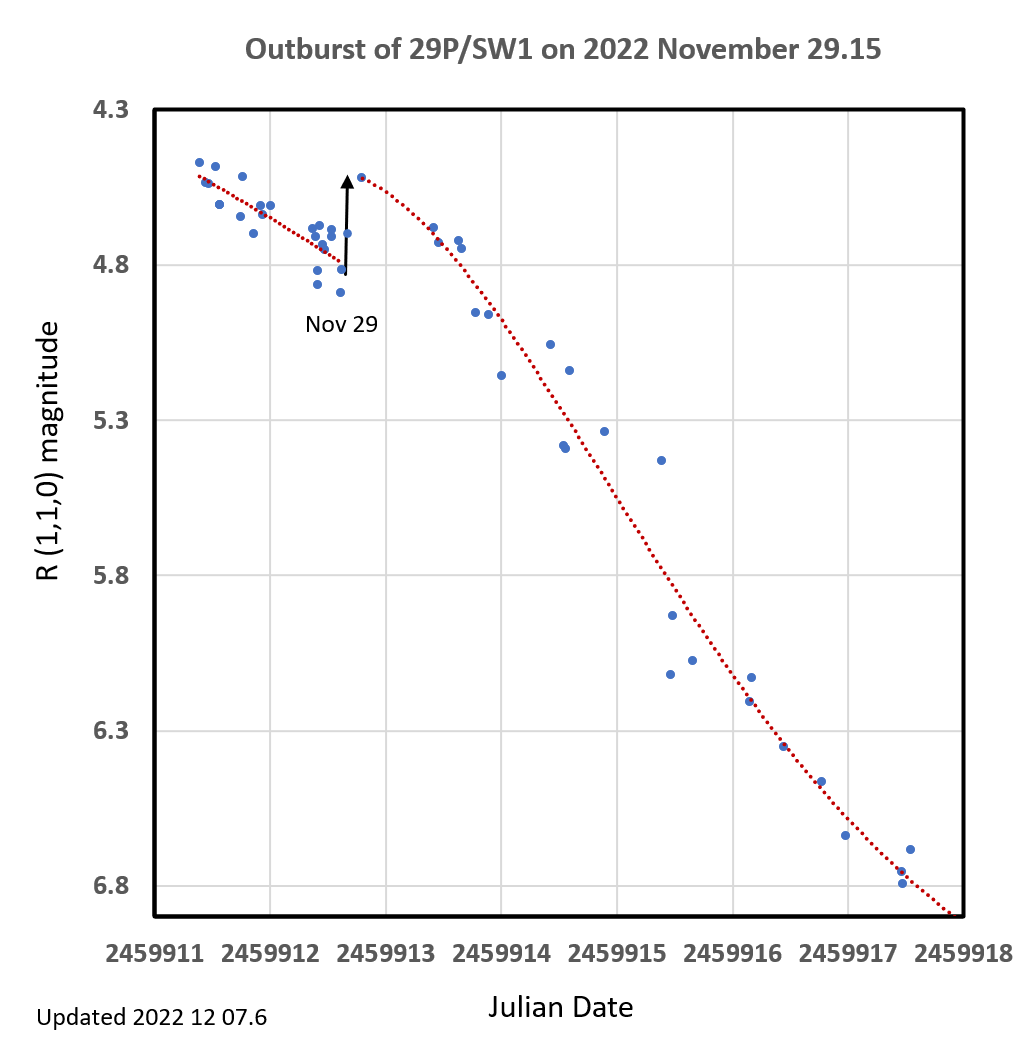
2022 November 30
Here is the latest lightcurve for the current apparition with still one month to go before 29P reaches opposition. We have now entered a particularly revealing episode in the revival of intense activity that started in 2021 September. The brightening of November 29 that we observed within ~3 hours of the start of the outburst appears to have been rather short-lived – something that might have been missed in the past. More observations needed!
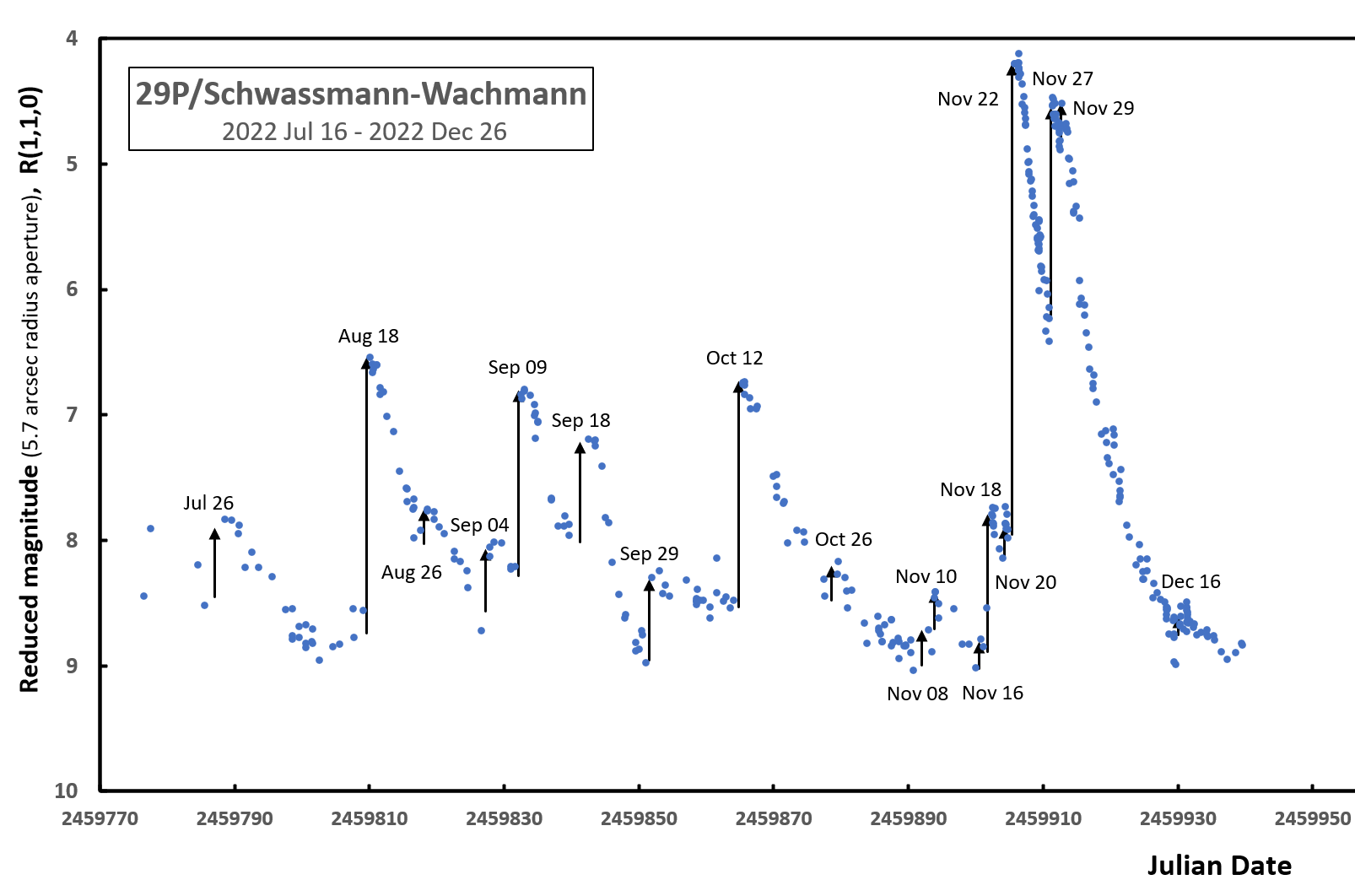
Thanks to Alison Tripp of the Faulkes team, I have now downloaded some November 26 2.0-m images taken by Errol Simpson. Here is the image-processed result, which should allow us to extrapolate to a more accurate time-zero:
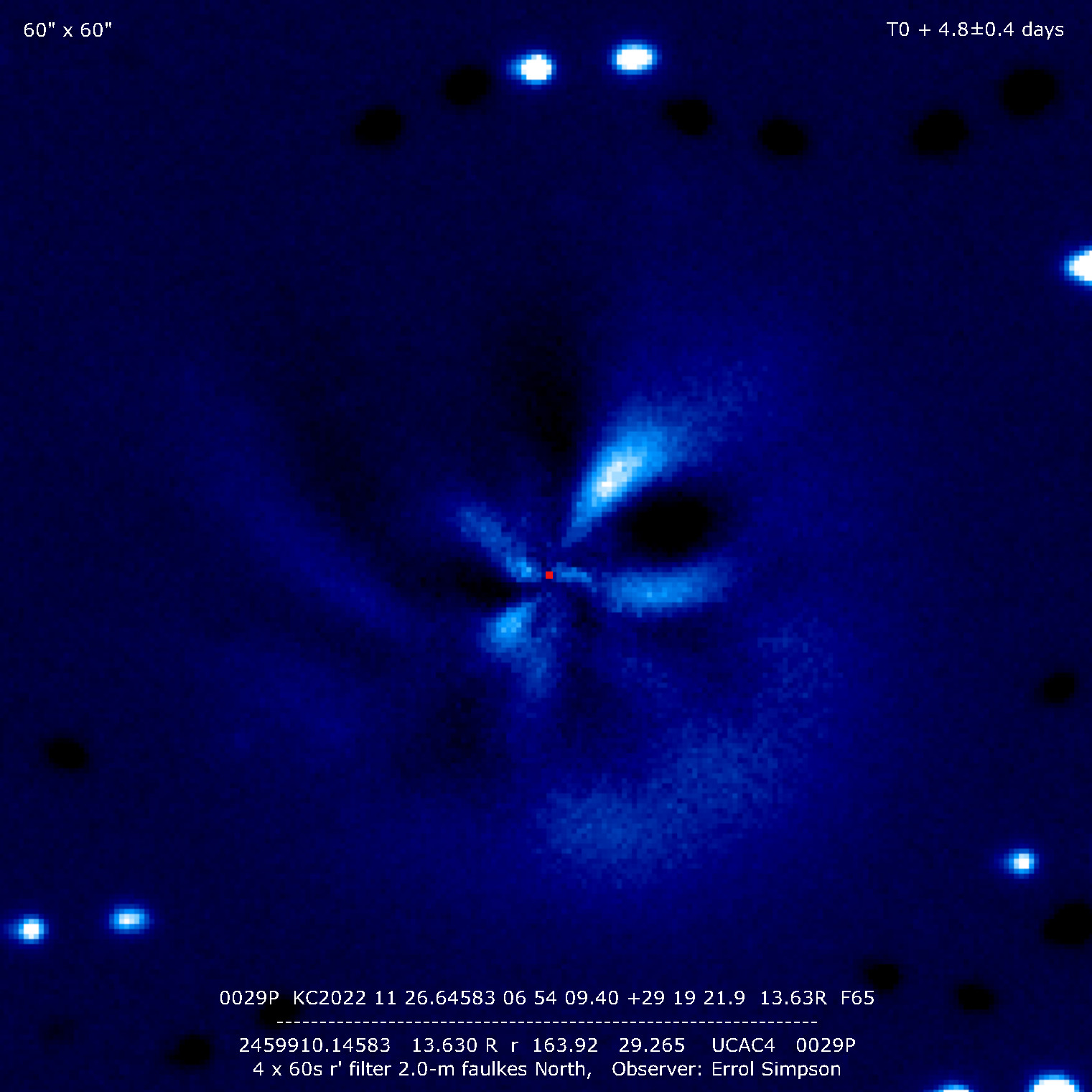
2022 November 29
Another weaker outburst has just been detected thanks to 1.0-m imaging by Ben Wooding at St Mary’s School, Bridgend.
Although the small brightening is immersed in a strong outburst coma, the extent of the change is still equivalent to a ‘strong’ outburst, roughly equal to 30 nucleus-equivalents and so we should see a more complex expanding cloud of ejecta as a result. Dave Storey from his Isle of Man observatory has images taken around Nov 29.16-29.17 and these look to have been taken around the start of the latest event so we have a good fix on the time it began.
Image processing of the latest 1.0-m exposures from Las Cumbres Observatory, Chile show the ejecta released in these last two outbursts of Nov 27 and Nov 29. The following false-colour picture has most of the circularly symmetric coma subtracted and thereby reveals the new expanding coma outflows close to the nucleus, which fan out mainly in a northwards direction.
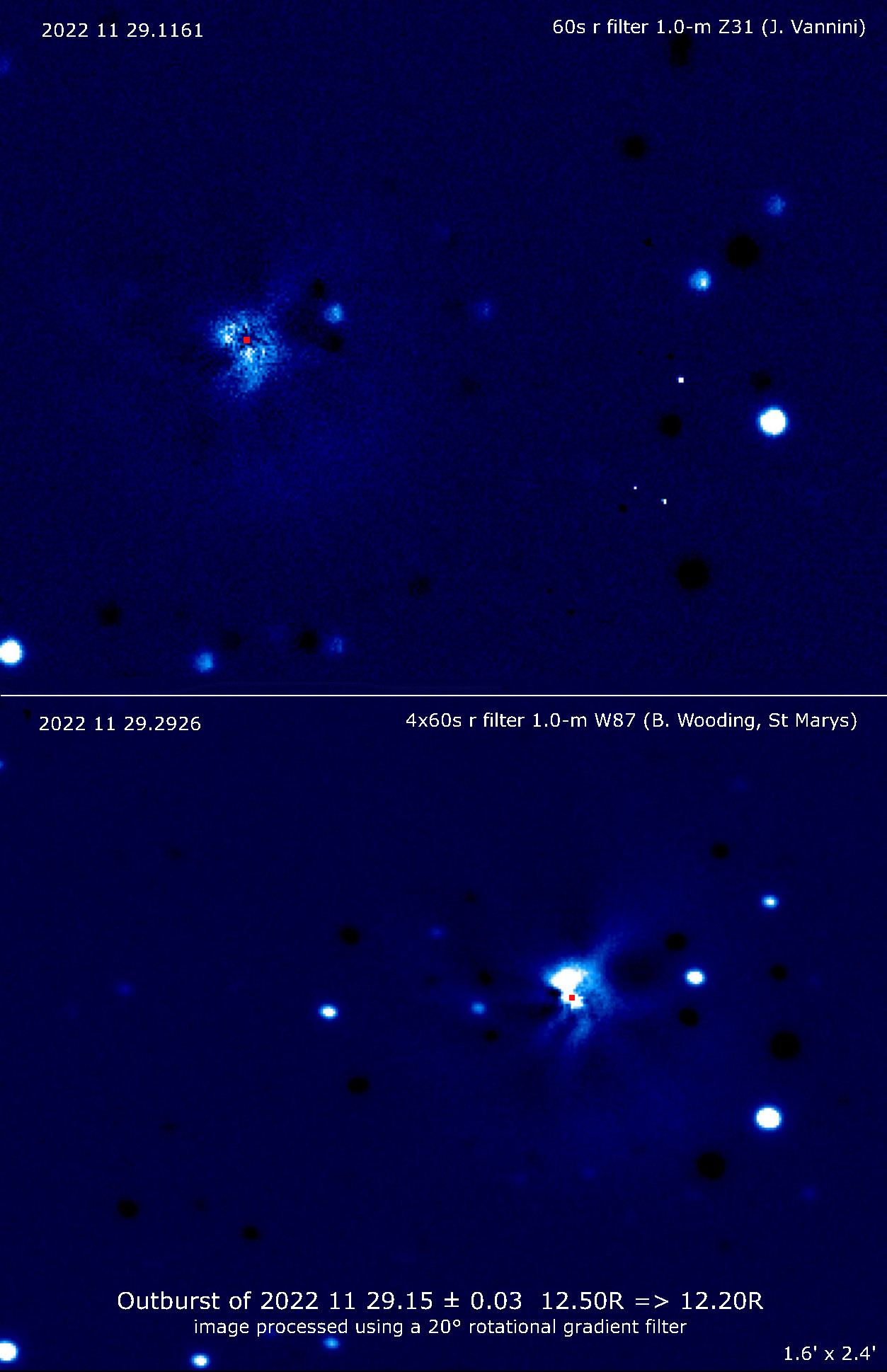
New strong outburst from about 14.1R to 12.2R detected thanks to Denis Buczynski’s measures:
0029P KC2022 11 27.88355 06 53 43.02 +29 20 01.7 12.22R I81 5.15″ (5.66″) 3x60s Rc
0029P KC2022 11 27.88571 06 53 43.00 +29 20 01.4 12.19R I81
0029P KC2022 11 27.88786 06 53 42.91 +29 20 01.8 12.05R I81
0029P KC2022 11 27.89002 06 53 42.91 +29 20 01.8 12.20R I81
Confirmed by Wayne Hawley – See observations listed halfway down this page.
——————-
Here is an excellent processed result using 22 frames with a 0.4-m instrument from François Kugel in Haute Provence. Notice the excellent correspondence of the features in the outburst coma with those shown in the 2.0-m image below. The pixel size of the two instruments was 0.83″ vs. 0.27″ with the larger telescope.
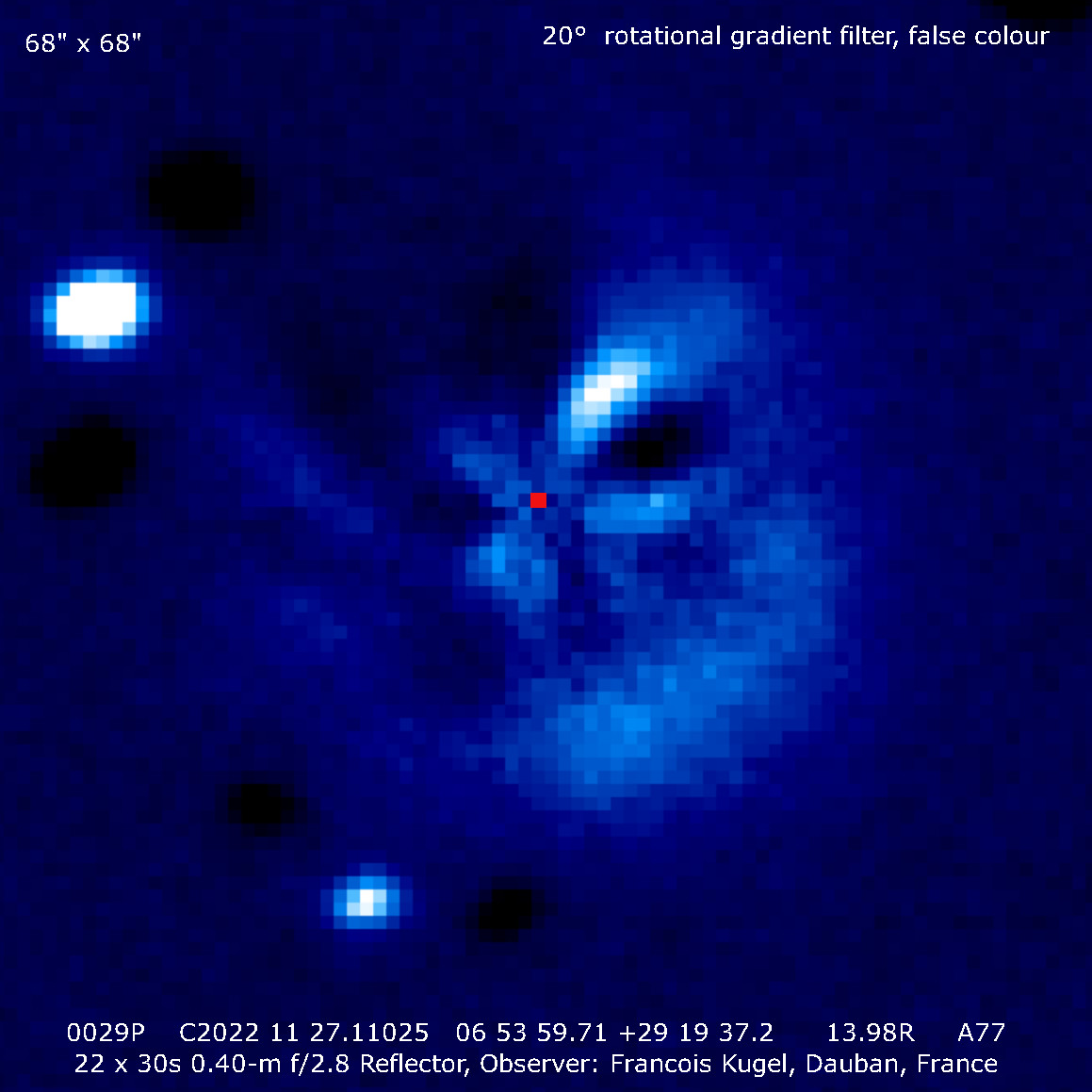
2022 November 25
We are now starting to see fine detail in the expanding debris cloud. Here is the latest from the Faulkes Telescope North reproduced to the same image scale as the similar processed image dated 2022 Nov 23.63, i.e. exactly 2 days earlier:
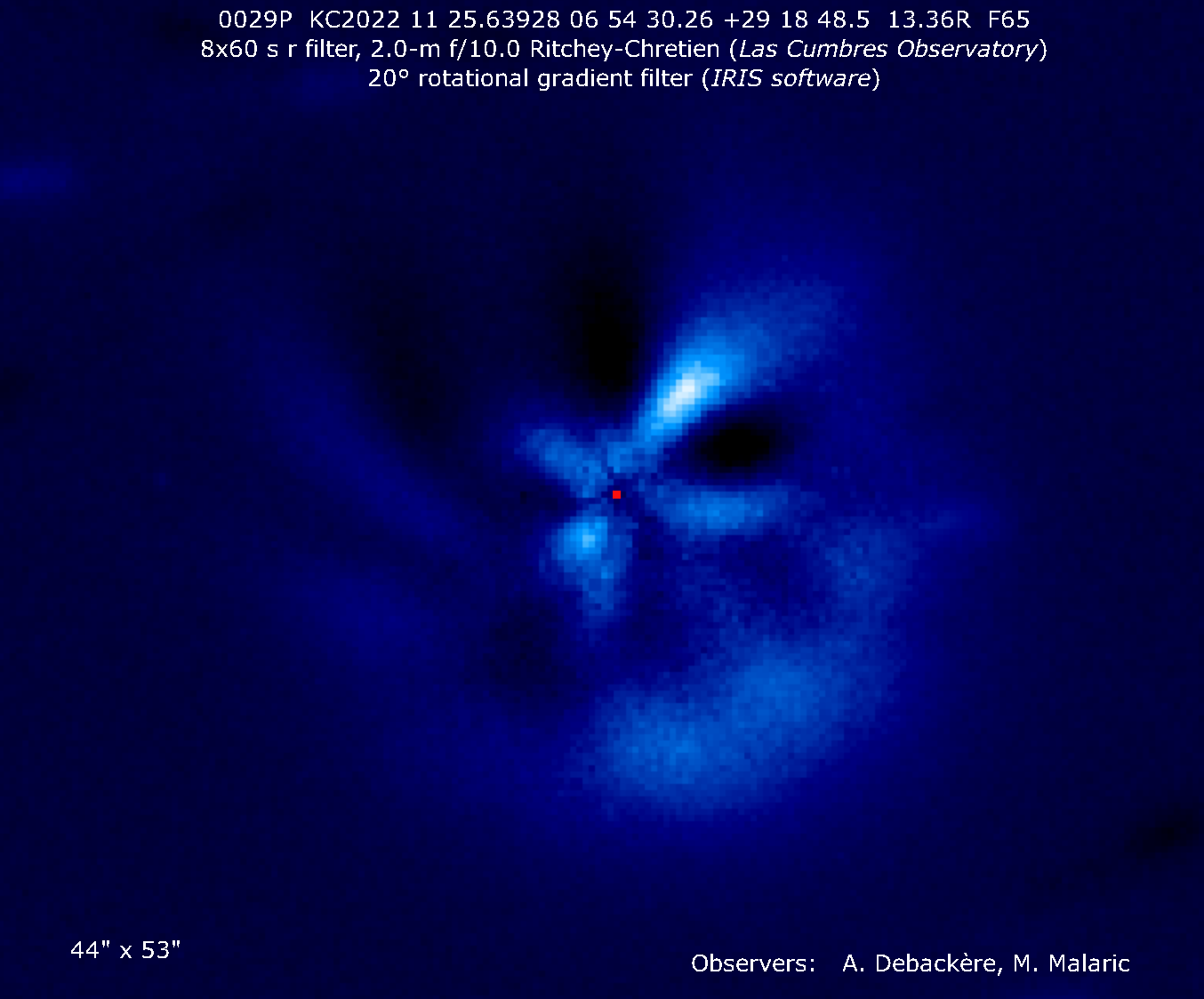
2022 November 24
Coma expanding but no sign yet of a further outburst. Here is a higher SNR image obtained by Cai Stoddard-Jones along with an image processed close-up version in false colour that reveals an intense condensation travelling outwards towards p.a. 330° approx, the centre of which has displaced 3.0 arcsec. equivalent to 11,500 km or 75 m/s, whereas the outer edge of the near-spherical debris cloud has reached 56,000 km, i.e. a maximum expansion velocity of 360 m/s.
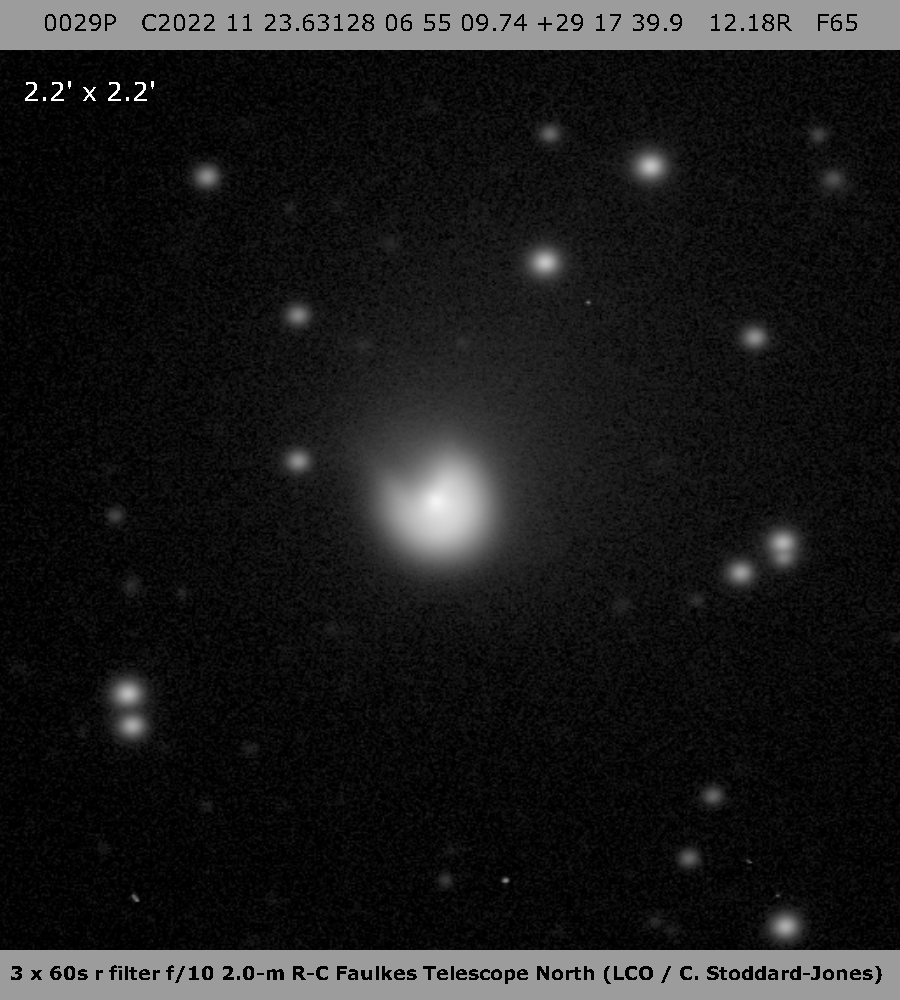
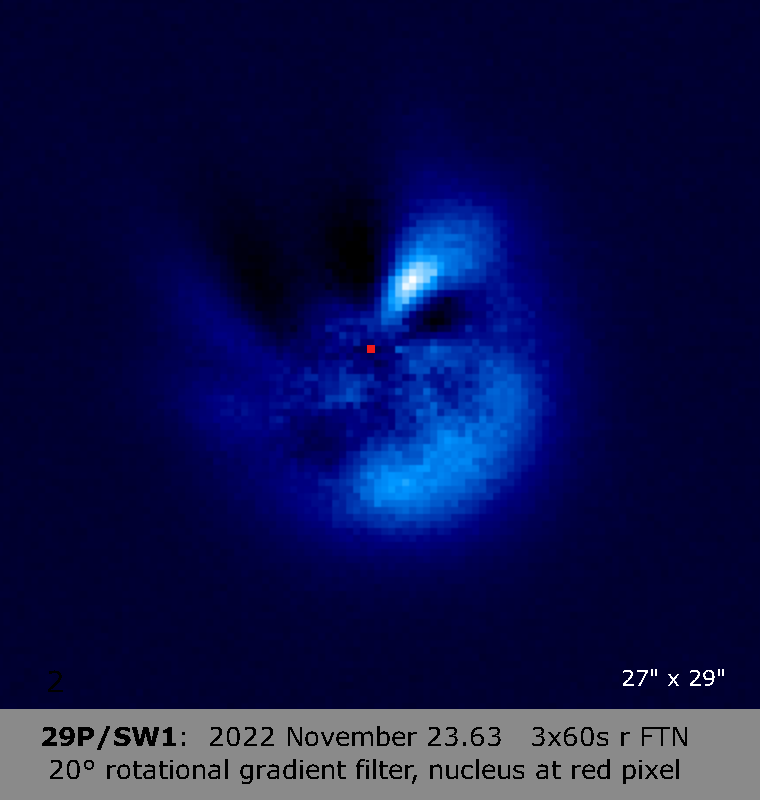
2022 November 23
First close-up of the expanding outburst coma thanks to André Debackère. Notice the characteristic ‘Pac-Man’ shaped cut-out at position angles of 0° to 60°, which suggests that the direction of the outburst projected on the sky was in p.a. 210° approx.
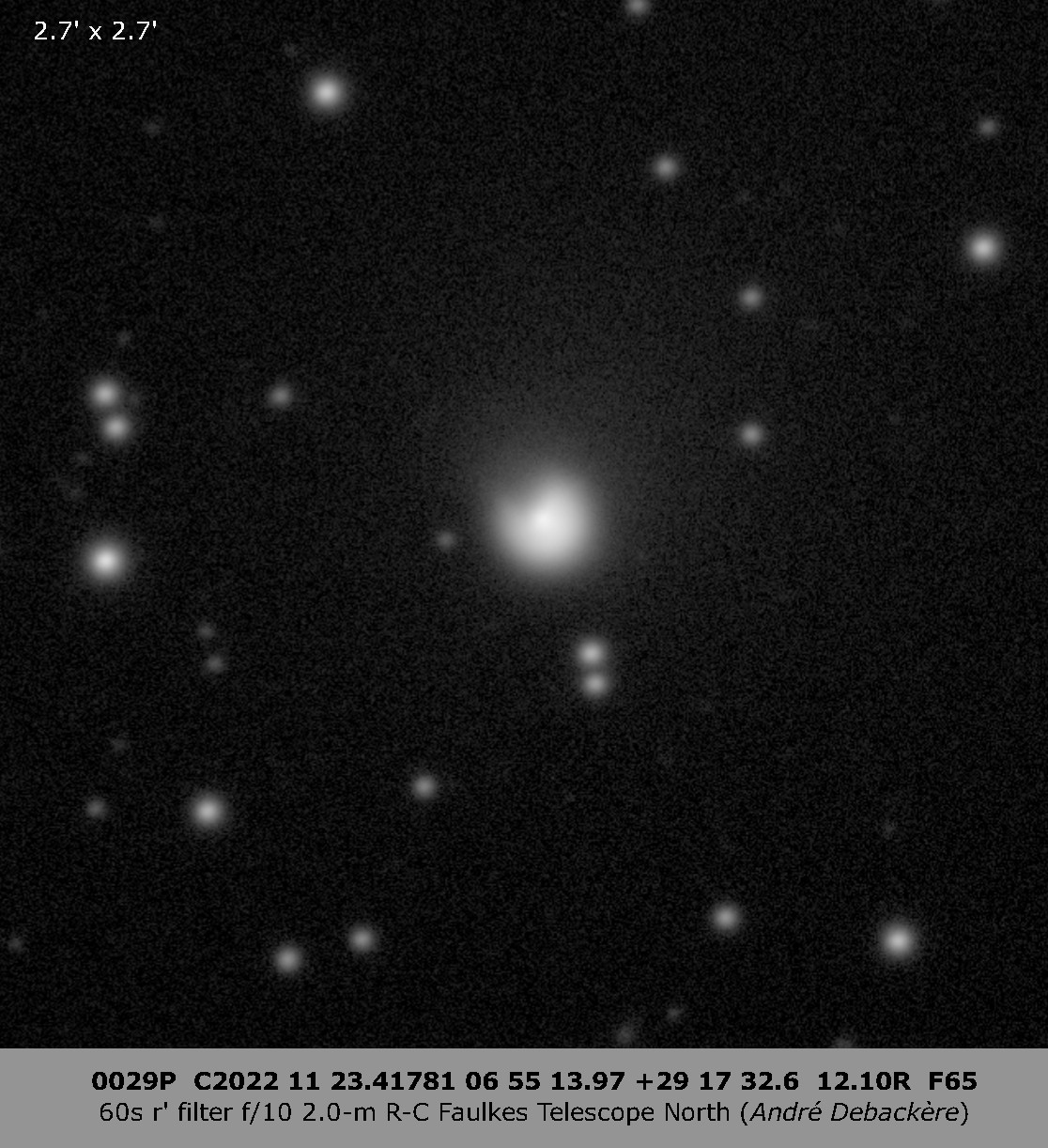
2022 November 22 – SECOND MOST INTENSE OUTBURST IN 12 YEARS
Patrick Wiggins is to be congratulated for imaging Centaur comet 29P hours after a very intense outburst. Here is the last measurement prior to, and the first measure following the strong outburst, which has attained magnitude 11.95R.
0029P C2022 11 21.34482 06 55 51.60 +29 16 21.2 15.69R 718
0029P C2022 11 22.32544 06 55 34.15 +29 16 54.6 11.95R 718
The outburst has been confirmed by Denis Buczynski:
0029P KC2022 11 22.83770 06 55 24.76 +29 17 11.1 11.95R I81
0029P KC2022 11 22.83986 06 55 24.73 +29 17 11.1 11.92R I81
0029P KC2022 11 22.84201 06 55 24.64 +29 17 11.7 11.94R I81
0029P KC2022 11 22.84417 06 55 24.64 +29 17 11.1 11.94R I81
0029P KC2022 11 22.84632 06 55 24.59 +29 17 11.4 11.95R I81
Lightcurve plot below updated.
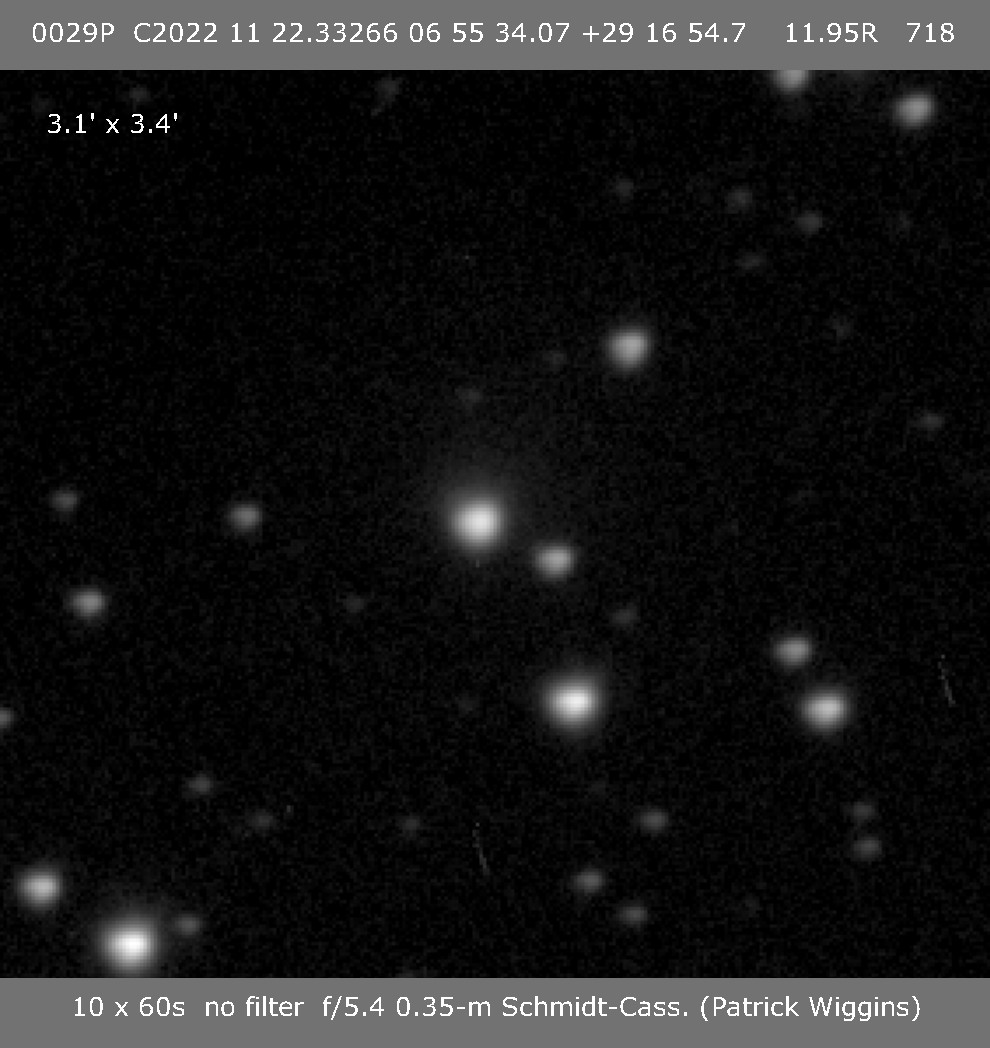
2022 November 21
Remarkably, Denis Buczynski has picked up a rebrightening just 2.5 days after the last event. Thankfully, Patrick Wiggins’ skies were clear last night and so his data confirm the 12th outburst event this apparition with opposition still more than 5 weeks away (Dec 30). Nick James’ data just received also confirm the event, the intensity of which is 1.1 nucleus-equivalents.
I have updated the plot below. It appears that mini-outbursts may be much more common than previously thought.
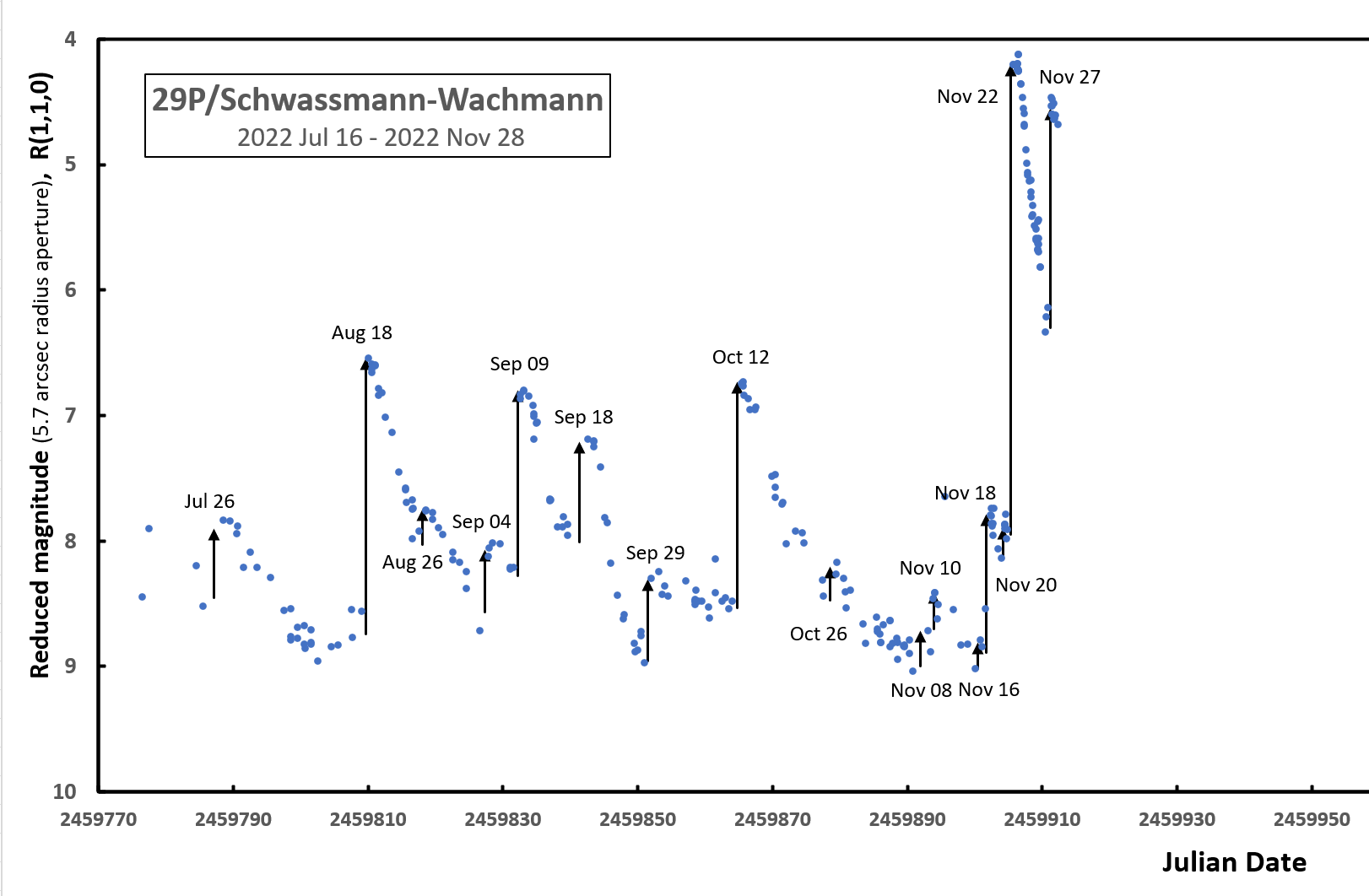
2022 November 20
A further small outburst of about 1.1 mag amplitude occurred on Nov 18.26, first detected by JF Soulier. Confirmed using Las Cumbres Observatory 0.4-m network. Interesting that these two latest outbursts took place only about 30 hours apart. The reduced magnitude plot (see below) has been updated.
Here is a stack of 10 images taken by Patrick Wiggins about 2.3±0.5 days after this outburst. It shows the outflowing ejecta directed towards position angles (p.a.) 0° to 40° approx.:
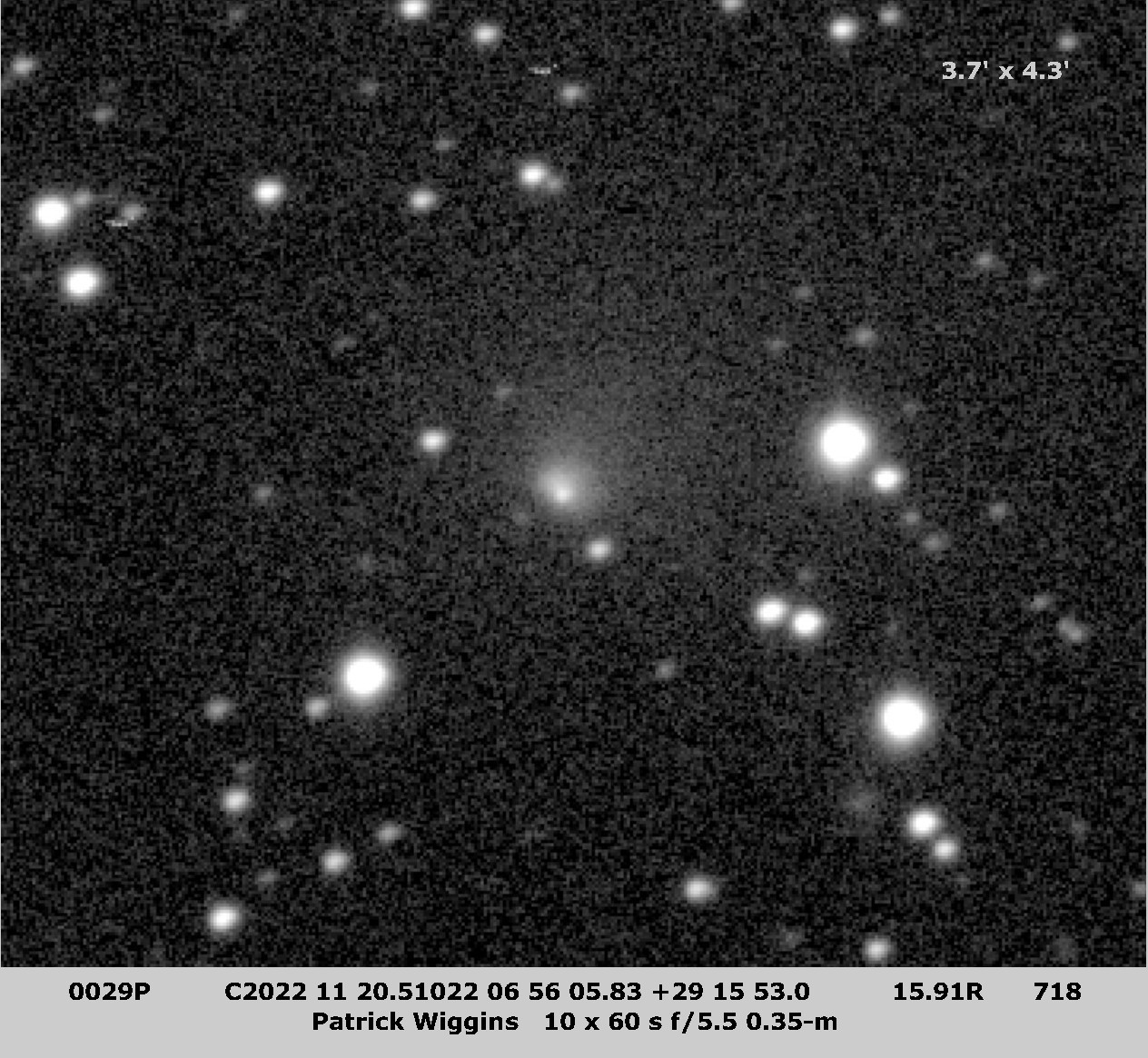
2022 November 17
A new outburst event has been detected – the 10th this apparition, of which we have now completed one-third. Although the latest mini-outburst this morning exhibited a 0.18 mag amplitude in the standard aperture, when measured in a 1.7 arcsec radius aperture, the amplitude increased to 0.35 mag (17.53R => 17.18R).
The additional new outburst coma equates to some 35% of the area of the nucleus alone, which represents the intrinsically weakest event detected during the past 20 months.
Patrick Wiggins, after discovering a Type 1a supernova (SN 2022aaiq) on November 15 has, with his 29P images of November 17, confirmatory evidence of this latest mini-outburst. His observations are a little earlier too, which means we can tighten up on the timing precision plus also recognise that the event looks to be of 0.21 mag amplitude or 41% of the nucleus-equivalent area. Thanks Patrick!
2022 November 10
A further 2.0-m image today has confirmed a further small brightening in what appears to be a second mini-outburst of about 0.30 mag amplitude on 2022 11 10.39 +/-0.16.
Eric Watkins has confirmatory observations from iTelescope’s T21 (H06) as well as Jean-François Soulier last night from L27 (29PREMOTE).
2022 November 09
We are fortunate to have managed a single 60-sec exposure on the 2.0-m Faulkes North today that has revealed the occurrence of a mini-outburst (probably sometime yesterday) ejecting a new coma equivalent to 0.6 times the area of the nucleus. 29P is currently close in the sky to a nearly full Moon making accurate photometry with small scopes difficult.
2022 November 01
Photometric observations are shown plotted below. The Rc magnitudes have been corrected to the standard photometric aperture radius of 5.7 arcsec and corrected for heliocentric distance, distance from Earth, and for phase angle assuming a linear coefficient of 0.035 mag/deg. As well as the 7 distinct outbursts with amplitudes ranging from 0.5-2.2 mag detected this apparition, there may be other mini-outbursts that have maintained some low-level activity. Opposition occurs on December 30.
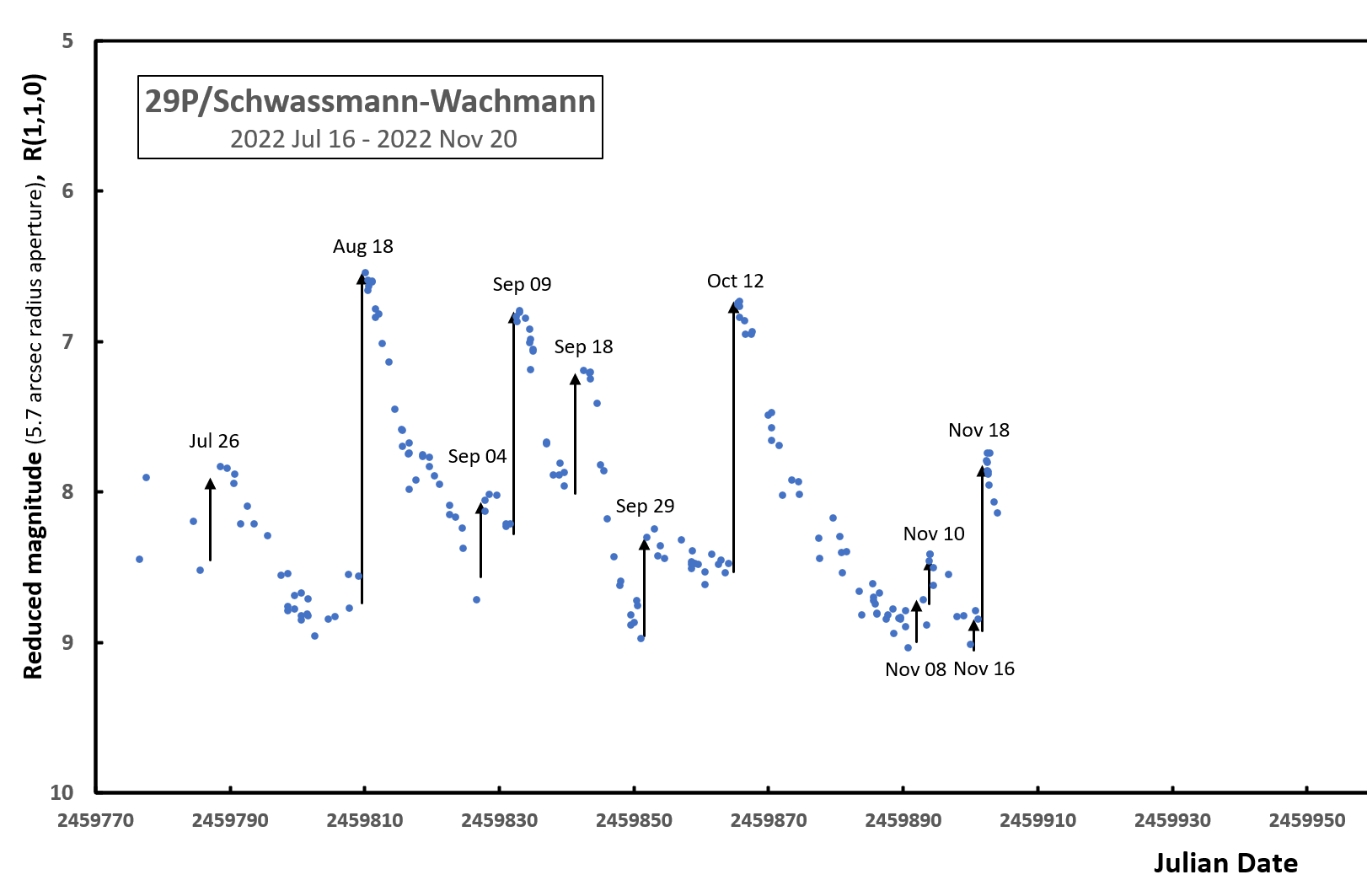
2022 October 22
A slow fade has set in. Thanks to Faulkes Telescope Project time, 12 x 60s exposures were obtained showing the outburst coma morphology after 7 days. The Faulkes Telescope North imaged r’ and i’ filters simultaneously and these 24 frames have been stacked in the attached, which also shows galaxy MCG +05-17-005 magnitude 15.2B.
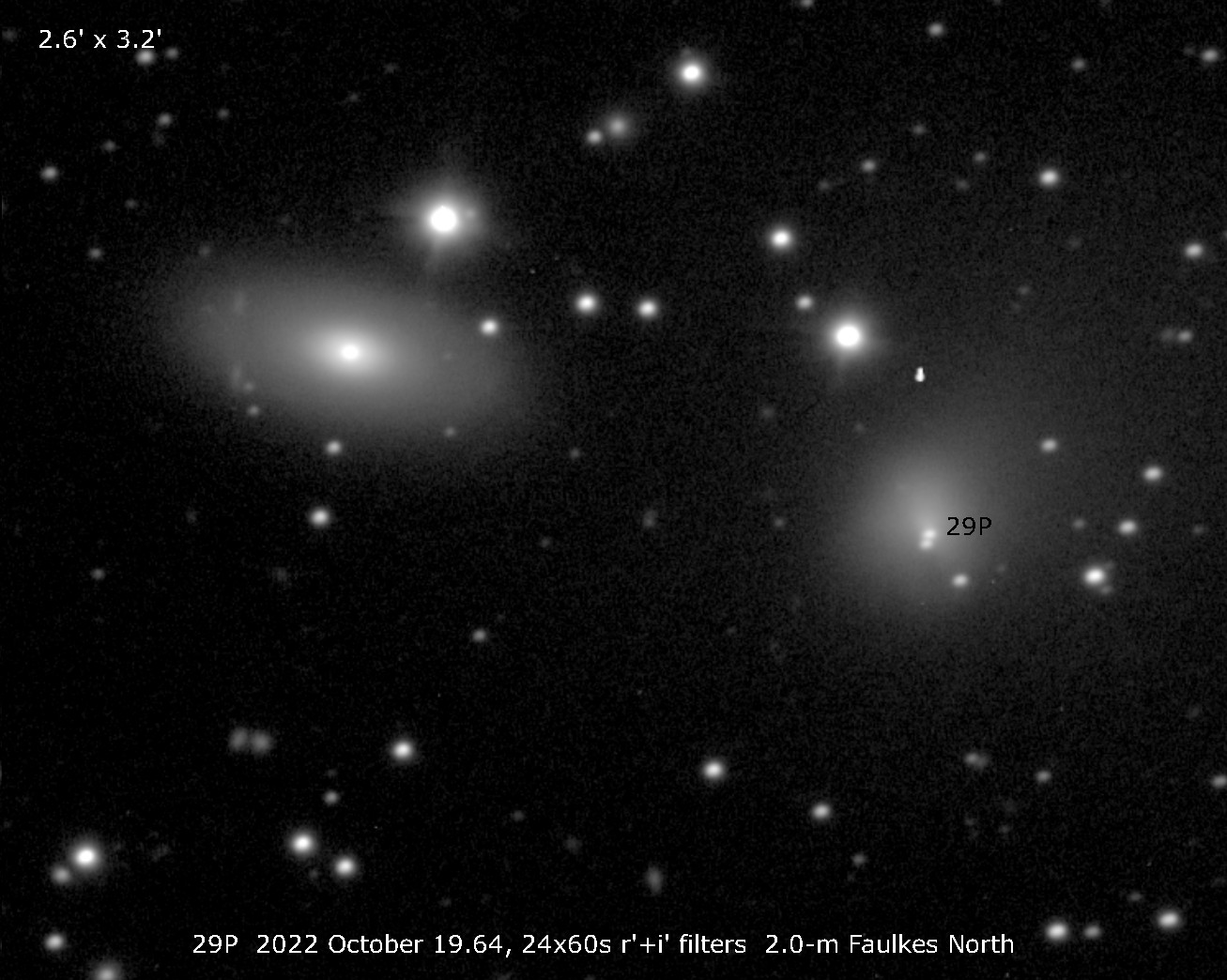
2022 October 13
Denis Buczynski has discovered a medium-strong outburst that probably occurred on October 12. Confirmed by Nick James.
Image from a stack of 18x60s images shows the outburst coma after 2 days at mag 15.0R and slightly diffuse compared with stars in the field.
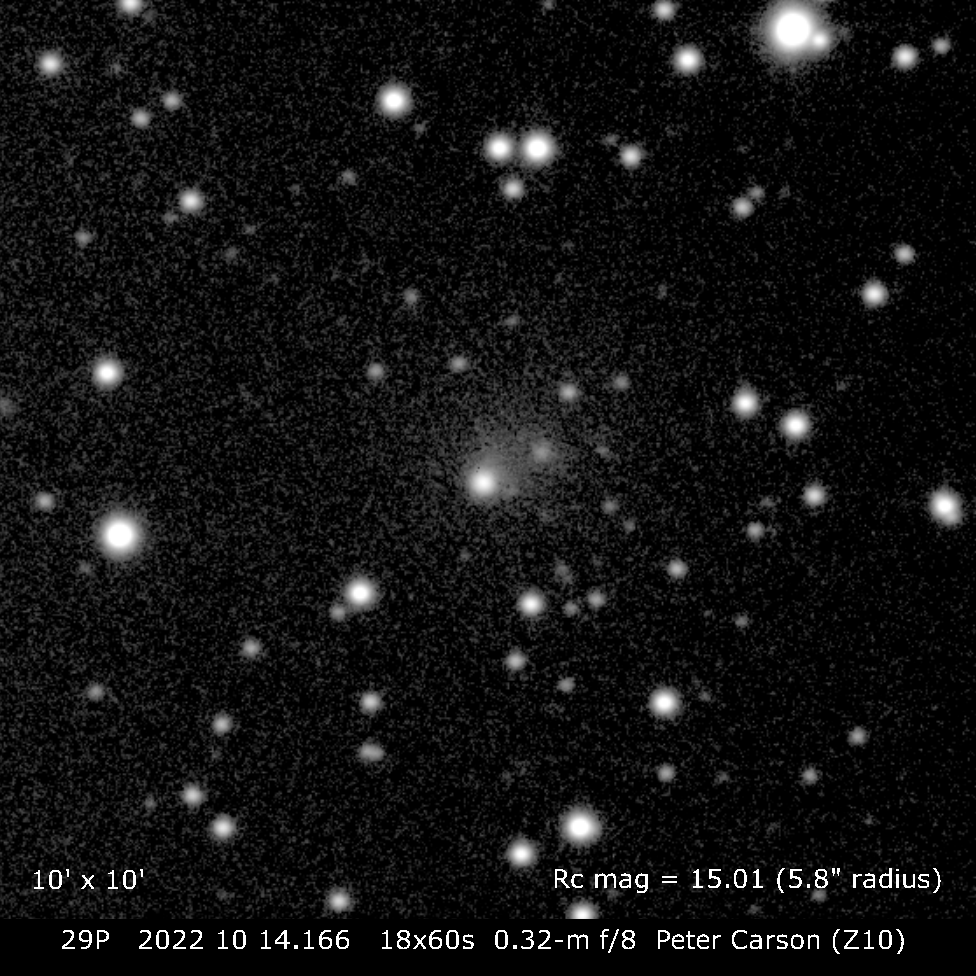
2022 September 27
The next AAS Division of Planetary Sciences meeting is due to take place in London, Ontario, Canada between October 2 – 7. Richard Miles will be attending and presenting an iPoster.
N.B. You have to be registered to see the iPosters once the meeting starts but you can do this as a ‘virtual’ participant thereby avoiding having to travel there. You can also participate in the meeting, hear the talks and make comments if you are registered virtually. Here is a screendump of what the 29P iPoster looks like – click on image for larger version:
2022 September 24
We’ve detected an outburst of about 0.9 mag amplitude, which equates to an increase in coma intensity of 6 nucleus-equivalents.
Here is what the outburst coma looks like after nearly 4 days’ expansion, with a very distinctive north-south asymmetry:
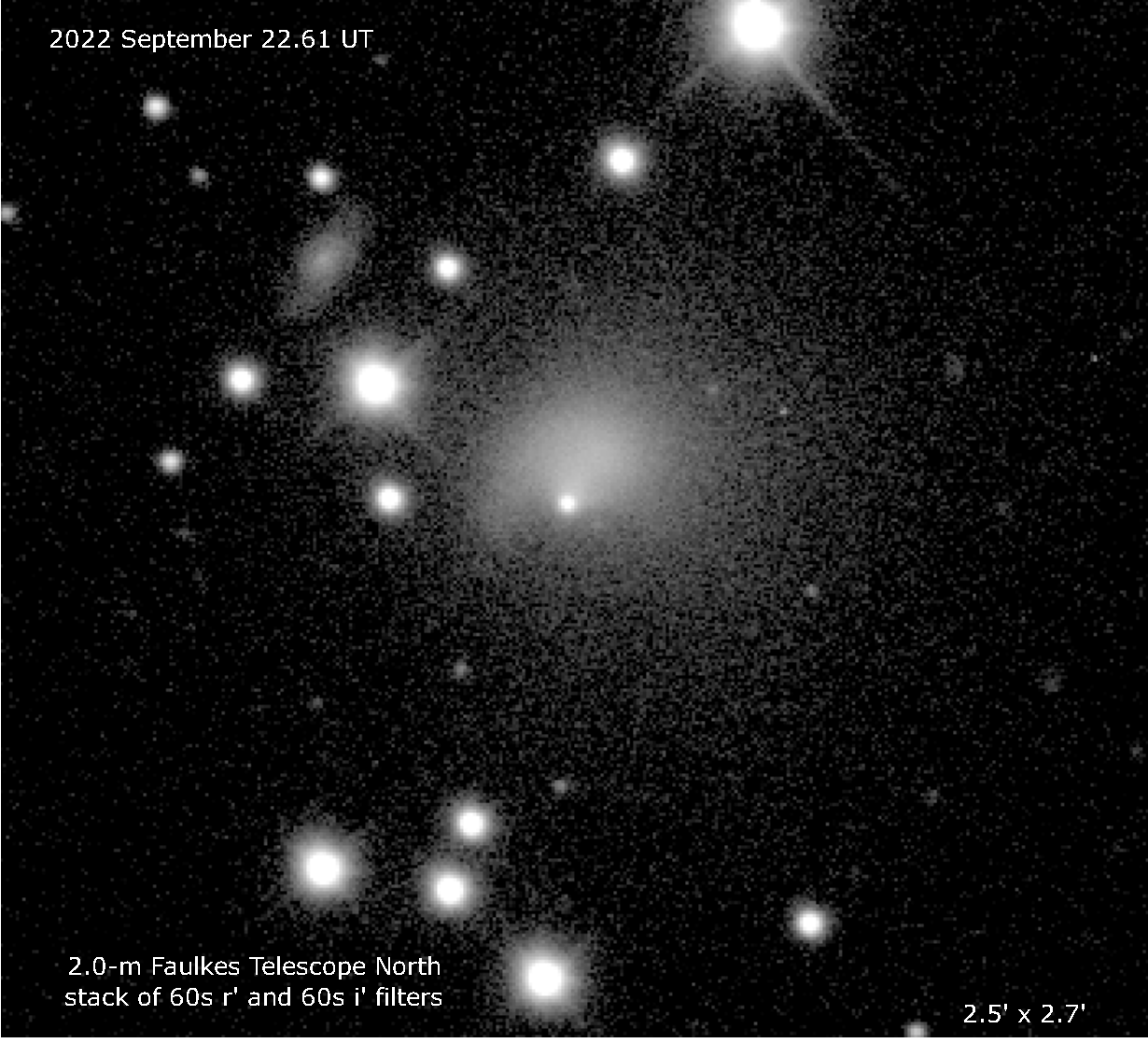
2022 September 16
Here is an image processed stack of 16 x 60s exposures taken by Errol Simpson with students from King Fisher Lake School, Tofo Village, Inhambane Province, Mozambique, and their Science Teacher Aaron Catrett (Faulkes Telescope Project) with the 2.0-m FT North six days after the latest outburst. The image in blue-white false colour has been subjected to a 20° rotational gradient filter using IRIS software and shows the main outflows of outburst ejecta. The red pixel marks the position of the comet nucleus. This is an example of the use of a large telescope to follow up outbursts discovered by amateurs. Here we see a single main outflow directed towards p.a. 340°. It is hoped that documenting the various outbursts over several years it will be possible to identify a number of sources on the nucleus as well as the spin characteristics of the nucleus.
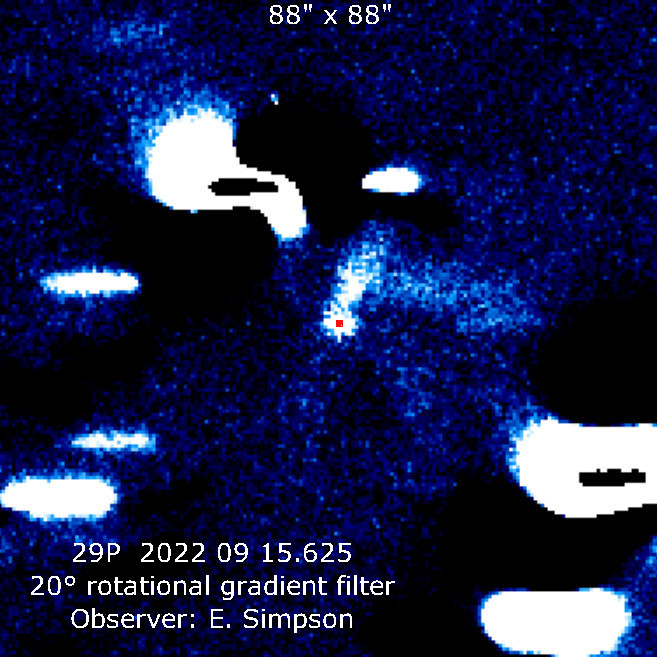
2022 September 14
We are 5 days on from the latest 1.5 magnitude outburst and here’s a detailed view of the expanding coma showing the presence of an outflow at p.a. 300°-345° taken using the 2.0-m Faulkes North instrument:
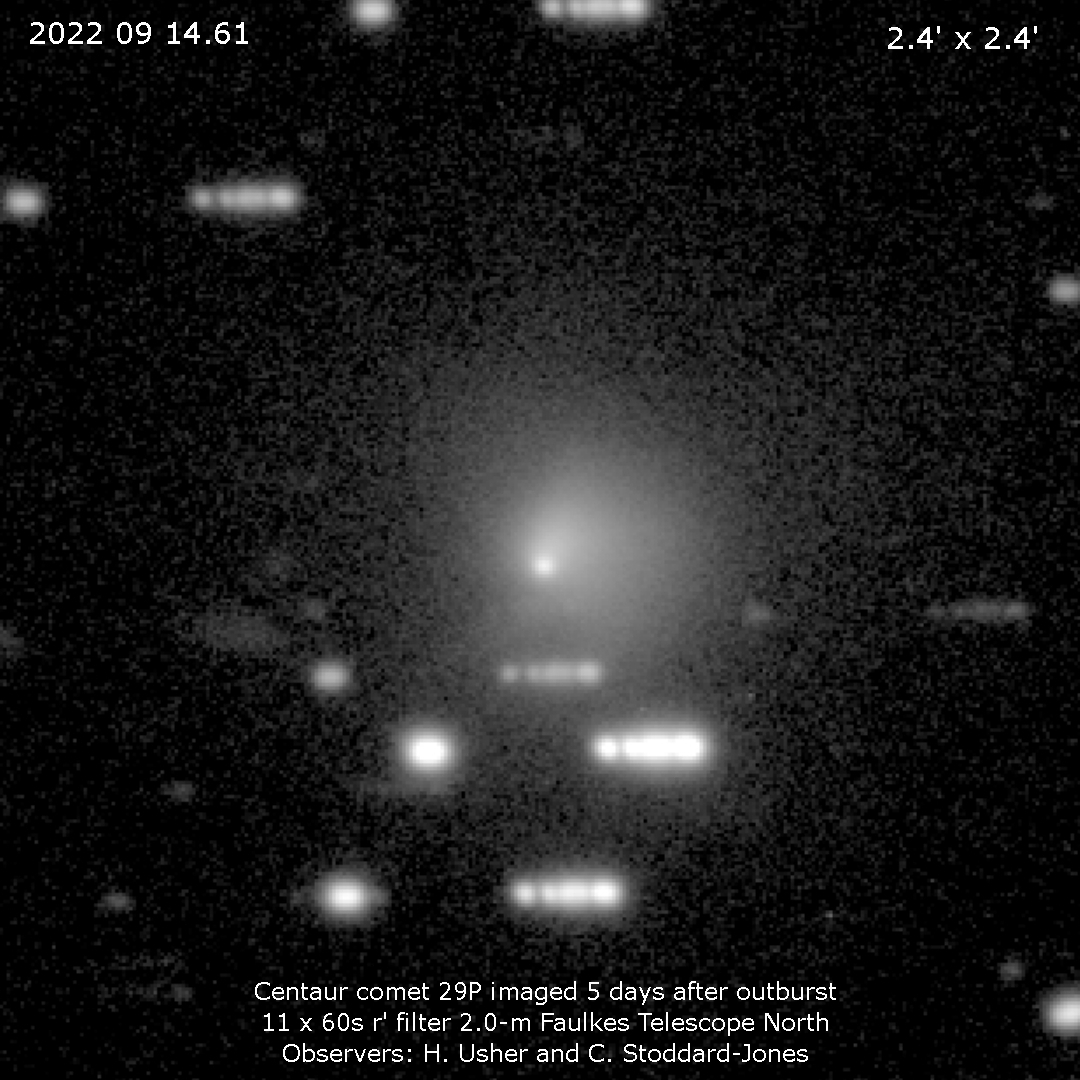
2022 September 10
Again, thanks to the Faulkes Telescope Project for detecting a second strong outburst this apparition, amounting to an amplitude of a little over 1.5 mag and attaining 15.0R. A 99.8% illuminated Moon was in the sky when images were obtained.
2022 September 8
Thanks to the Faulkes Telescope Project and in particular Paul Roche for providing telescope time, and to teacher, Ben Wooding of St Mary’s School, Bridgend, Wales, we have a detailed image of the 4-day-old outburst coma showing a distinct outflow at p.a. 0° – 30°. This exemplifies the objective of MISSION 29P: that is to follow up discoveries of outbursts by amateur observers with much higher resolution imaging to better understand the processes taking place within the inner coma and at the nucleus. The main direction of flow relates to the position of the source, possibly a cryo-geyser, on the nucleus.
Status report as of September 6
Peculiar Centaur object 29P has now reached a solar elongation of 64° in the morning sky and so has become more accessible to observers operating in the early hours. Observations began on July 16 and we have already seen 2 mini-outbursts and one strong outburst. Amateur observers have provided excellent monitoring and record coverage of the start of its apparition, better than anything achieved in the past. New observers are invited to join the campaign since we aim to secure accurate R photometry 24/7. Please refer to the detailed Tutorial on Observing 29P, or alternatively make your FITS images available and the photometry will be done for you.
First strong outburst of the new apparition
August 18 has seen a medium-intense outburst, the first since the 2022 February 11 outburst that reached magnitude 15.05R. That’s a gap of some 188 days between strong events, one of the longest intervals we have witnessed. Below is an animation of this strange object in outburst as three 240-sec exposures made with the LCO 0.4-m (T04) on Haleakala, Hawaii as of 2022 August 18.62.
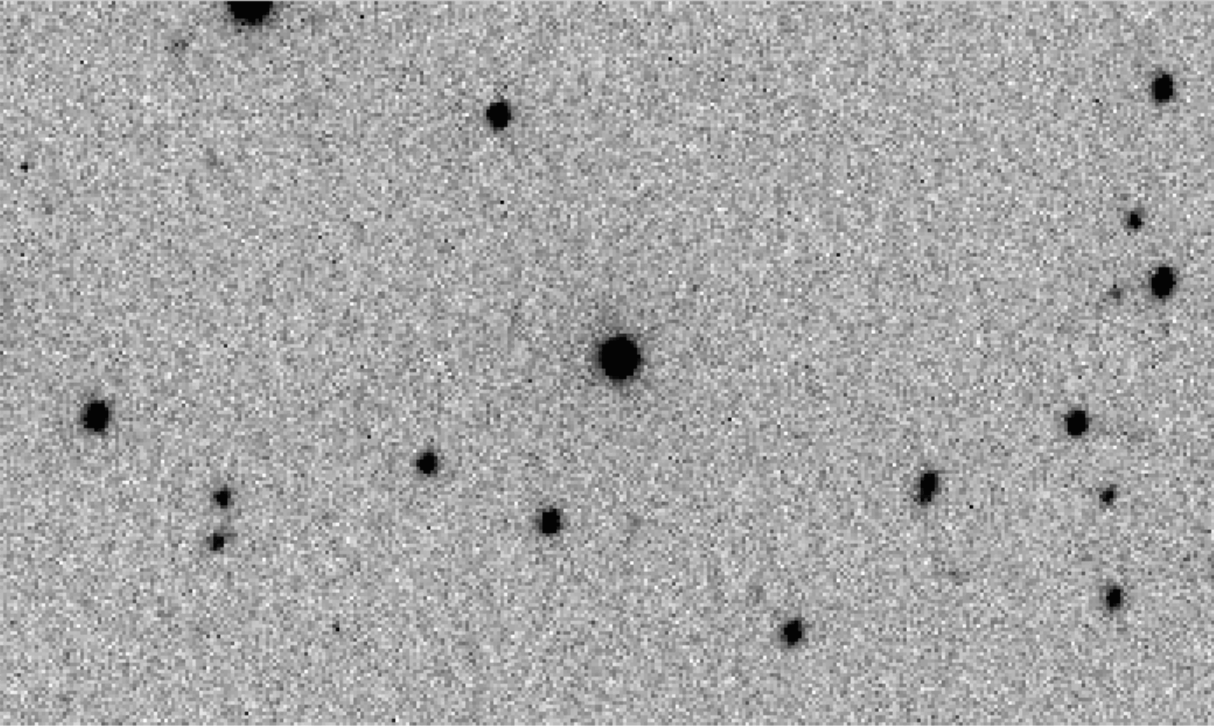
More observations encouraged !
New apparition 2022-23 has commenced !
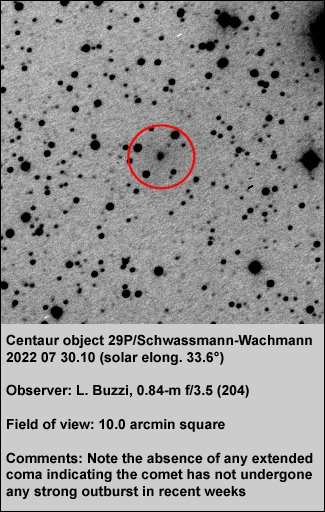
Thanks to Jean-François Soulier (L27, C10) and Luca Buzzi (204) we now have the first series of observations of this object low in the morning sky. There does not appear to have been any strong outburst in recent weeks because of the absence of any extended coma. The observing gap whilst the comet was in conjunction with the Sun was a mere 52 days, a record short gap in our data!
MISSION 29P Observer Statistics for 2021-22
Here is a full breakdown of observers contributions for the latest completed apparition – a record number of contributors – Well done everyone!
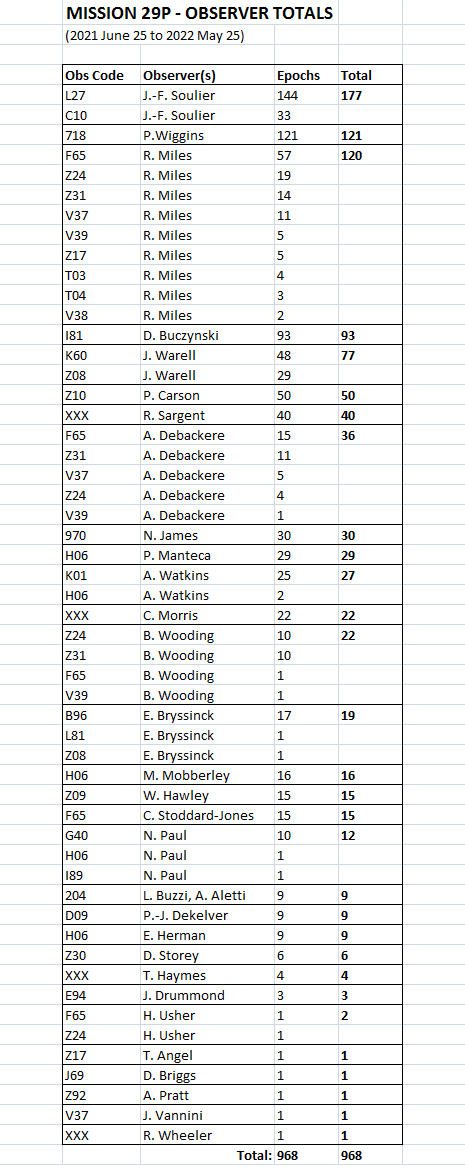
Centaur comet 29P and the James Webb Space Telescope
JWST Proposal 2416 entitled “Measuring Volatile Production in Active Centaurs with NIRSpec” led by Adam McKay (PI) is due to kick off between 2022 July 25 – July 31 by observing 22nd magnitude 39P/Oterma with its Integral Field Unit (IFU). Four further targets will be investigated before finishing with 29P during 2023 Feb 09 – Mar 30, i.e. about 3 weeks either side of its retrograde point. The methodology is similar for all targets when NIRSpec will map H2O, CO2 and CO in a 3″x3″ box centered on the nucleus as well as an offset from the nucleus to characterise the coma. Methane may also be detected if the observing epoch is shortly following an outburst. A total of 3.1 hours will be spent observing the nucleus and around 29P between 0.6-5.3 microns (resolving power ~100). The 3″x3″ box is traversed by 30 slits providing high spatial resolution. Pointing accuracy of JWST is 0.1″.
(added on 2022 Jun 18)
End of the 2021-2022 Apparition
We have finally reached the end of our coverage of the latest apparition.
Patrick Wiggins (Obs Code 718) has extended observational coverage well into the month of May, with his last time series taken on May 21 when 29P could be seen at almost 17th magnitude, sitting just 21 degrees from the limb of the Sun!
I believe this is a record for a comet so faint as 29P at the moment and just 26 days from solar conjunction. Patrick has also imaged the field containing the comet on May 25 with the Sun 18 degrees distant and just 5 degrees altitude. The target appears to be fainter than mag 16.0R, the plate limit.
So 29P last exhibited a ‘strong outburst’ 214 days since its last one: that reached magnitude 13.1R on October 23. It appears that the historical record of 4 rapid consecutive outbursts last September has possibly resulted in a significant loss of sub-crustal pressure and that the centaur object is taking a long time to build up this pressure ahead of the next strong event. Maybe it will still be quiescent when we next see it appear after conjunction with the Sun on 2022 June 16? Coverage of the new apparition could begin around July 12 at the earliest.
Clear skies for then!
Latest lightcurve of 29P
Here are plotted the R magnitude of the comet during the current apparition. The measurement is expressed in terms of the brightness of a 5.7 arcsec radius photometric aperture. Inner coma measurements are also shown (in red) made with a 1.6 arcsec radius aperture with either 1.0-m or 2.0-m telescopes.
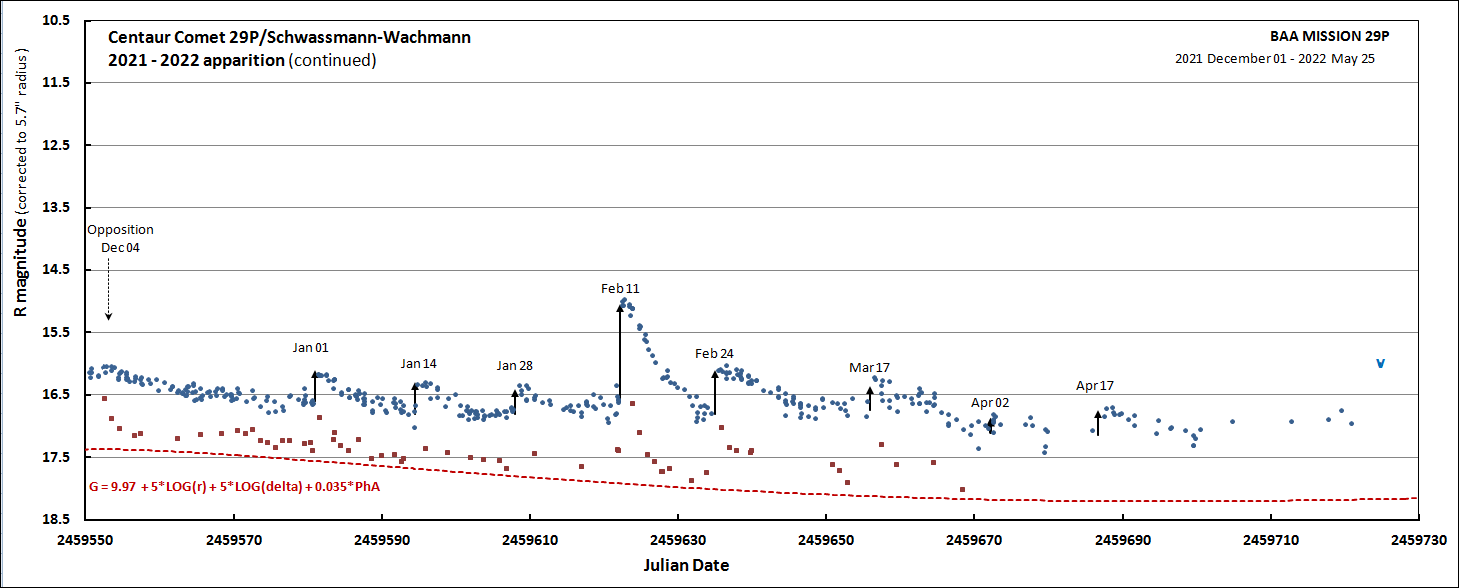
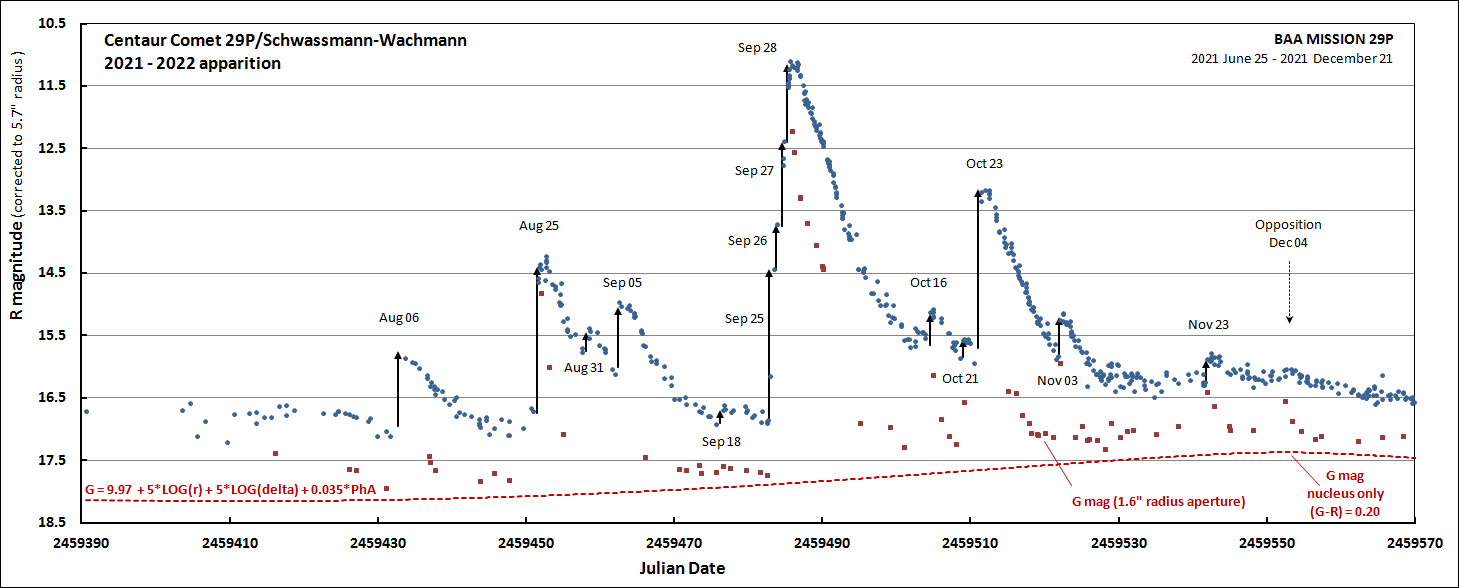
2021 December 21 occultation event – Report
Only one observer (Peter Ceravolo) was able to make a video recording of this potential occultation event, which was negative. Other observers were defeated by the very bright Moon nearby, the very low temperatures causing equipment malfunction, or by cloud.
Hubble imaging of Comet 29P
Hubble’s Wide-Field Camera (WFC3) is working again and has secured images of 29P on November 23, November 30 and December 7.
The first set of 10 exposures were obtained 10-12 hours after a small outburst. Here’s a preview of one of the Dec 7 frames.
Have included an inset showing roughly the same patch of sky taken with the 1.0-m at Macdonald Obs. in average seeing.
(Write-ups about 29P by Dr Tony Phillips appear on the October 15 page and on the October 26 page of the Spaceweather website)
Strong outburst at 2021 10 23.75 +/-0.03 15.70R => 13.15R
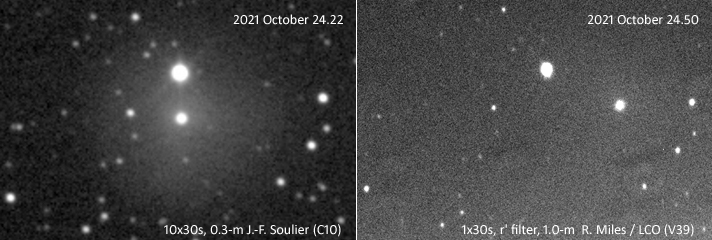
Mini-outburst (below) of 0.35 mag amplitude on 2021 10 16.88 +/-0.01 captured by Jean-Francois Soulier (France), Kritti Sharma et al. (GROWTH, India), and Tim Lister (LCO, Tenerife)
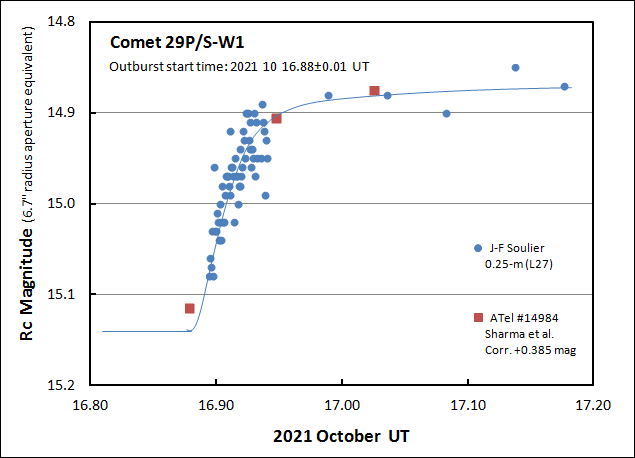
Our 5th successful outburst lightcurve !
Latest images:
(click on images for full resolution)
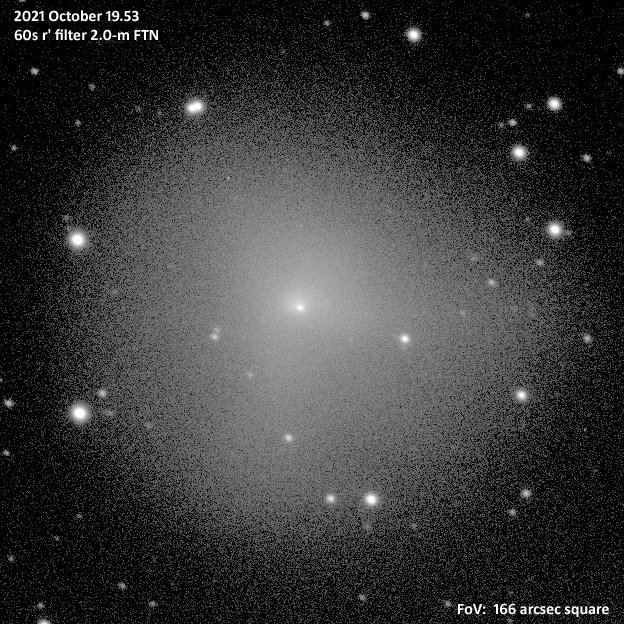
Peering inside the expanding coma.
The outburst coma from the October 16.88 event can be seen expanding as a fan-shaped outflow close to the nucleus at p.a. 0 – 90 deg or so.
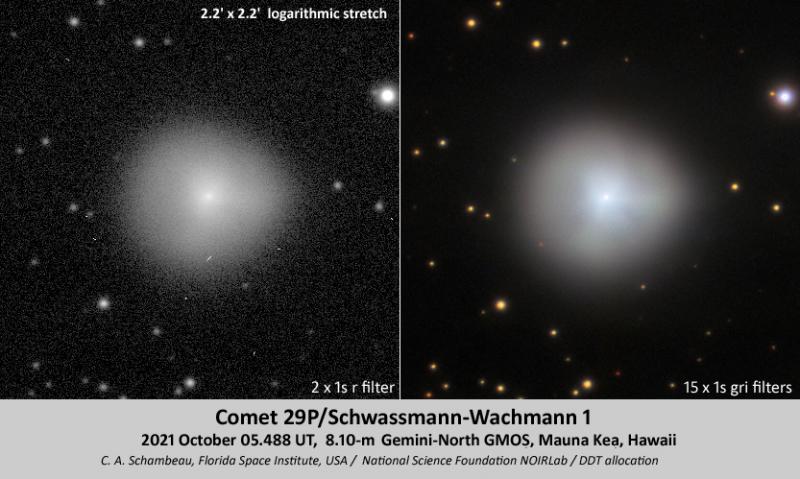
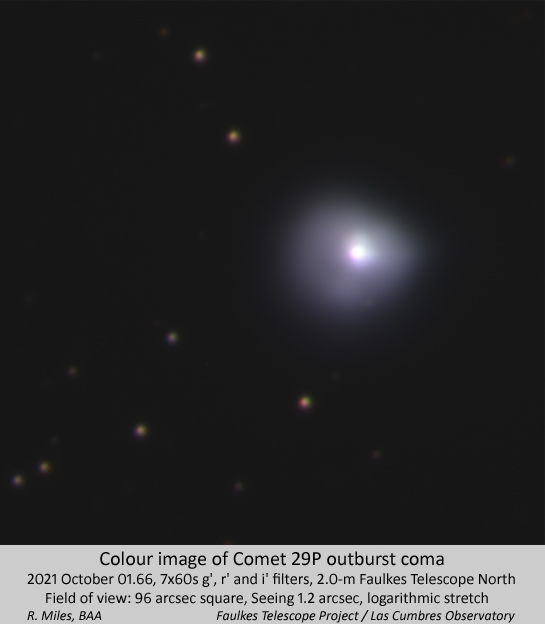
The following two images, the colour one from Peter Tickner, indicate that there is an excess of blue light in the upper right of the coma (p.a. 270-350 deg). This may be evidence of the emission of light from ionised gas moving in this direction and overtaking the slower-moving dust. Thanks Peter.
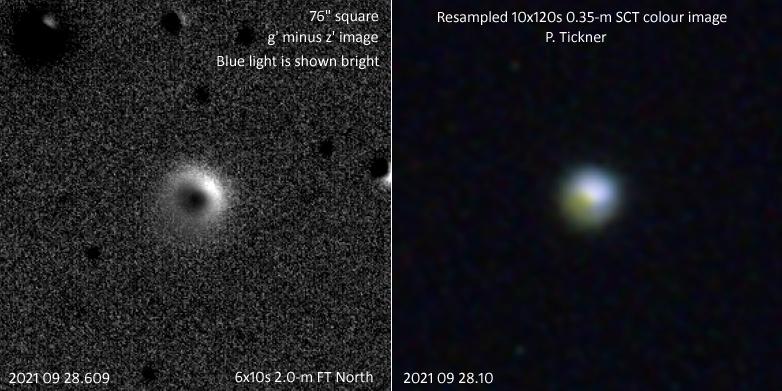
Latest Observations:
STOP PRESS – Fourth outburst on 2021 09 27.6+/-0.2 almost 9 times greater intensity than the first two events !!!!
STOP PRESS – Third outburst on 2021 09 27.0 almost 5 times greater intensity than the former two events. Time between each pair of outbursts ~20 h
LATEST: An outburst of about 2.5 mag amplitude appears to have occurred on 2021 September 25.34 +/-0.005 followed about 20 hours later by another outburst of similar intensity
Thanks again to Patrick Wiggins (718) imaging from Utah and a good run of clear skies, and Denis Buczynski in Scotland also favoured with clear skies these past two nights, we have witnessed a double outburst, where one presumably has subsequently triggered another cryo-eruption (see listing of observations below). These two events might herald more intense activity in the coming few years. The last 2.5 years have only witnessed 8 events brighter than mag 14.5R, which coincides with similar relatively quiescent behaviour seen earlier when the comet was halfway around its orbit of the Sun, i.e. two seasons earlier. If the nucleus has a high tilt then these quiescent times may correspond to the seasons when the poles are directed towards the Sun (and Earth). Since the equatorial regions on the nucleus experience the greatest amount of solar radiation, these are likely to be more thermally processed and hence exhibit more intense cryovolcanicity. Watch out in the coming year or two for 12th magnitude outbursts.
An earlier outburst of the current apparition was detected by JF Soulier on August 25. It exhibited an outburst amplitude of 2.4 mag and subsequent imaging using the 2.0-m Faulkes Telescope North has revealed structures in the expanding inner coma.
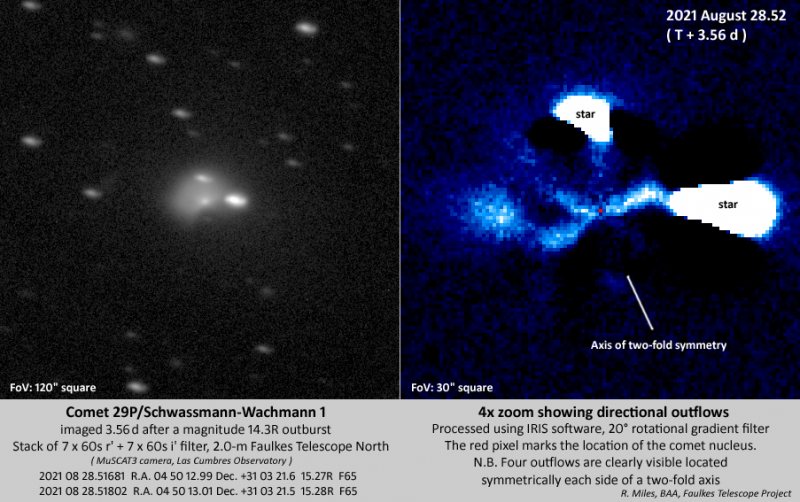
Here’s the appearance of the coma on September 8, showing the new event as a brighter inner coma whilst the edge of the outer coma has continued to expand at 0.22 km/s:
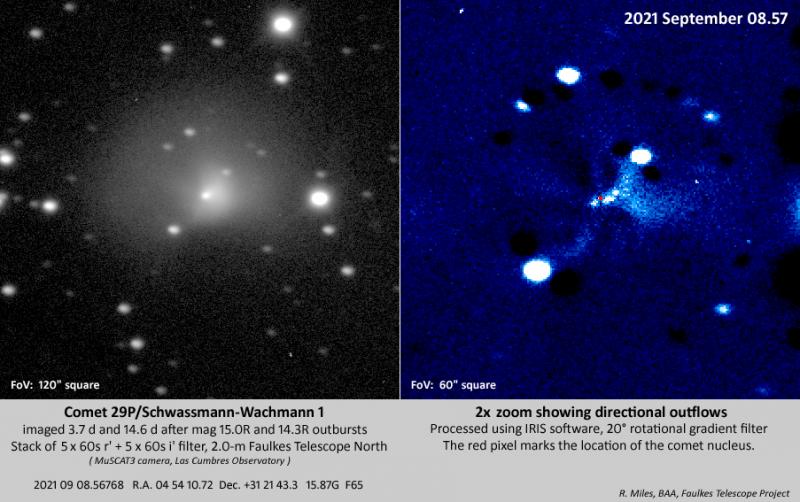
The present 2021-2022 apparition began with the first observations reported by Jean-François Soulier on June 25 at a solar elongation of 29° in the morning sky. That means that the comet hid from us when too close to the Sun for just 13% of the time – a new record!
Previous apparition
The 2020-2021 apparition is now over with a record 338.5 days of coverage, the longest such coverage of any apparition and also the most observing epochs achieved (1168). The observers who contributed were:
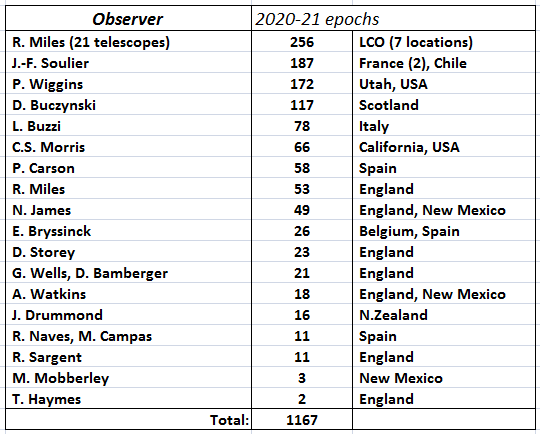
The following image is the last one taken this apparition with the comet at only 19° solar elongation. It is not detected which means it was fainter than magnitude 16.0R at that time.
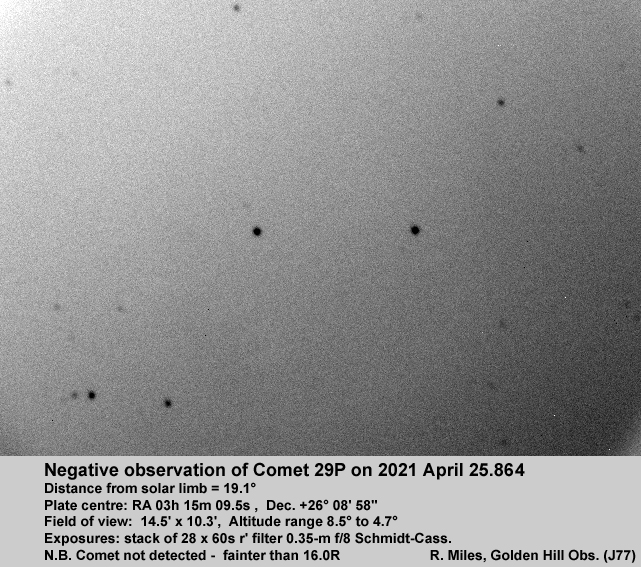
29P appears to have had a mini-outburst of 0.9 mag amplitude whilst at 25° solar elongation. Here’s the image:
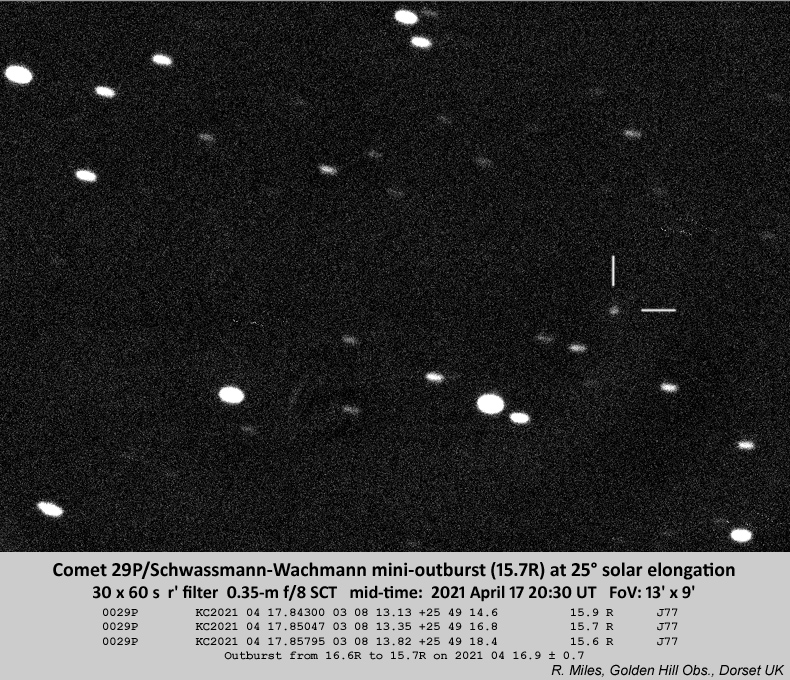
Patrick Wiggins observing from Utah has confirmed the mini-outburst, his observations yielding a magnitude of 15.74R.
Two very weak mini-outbursts occurred during March. They were each of just 0.11 magnitudes amplitude reaching 16.9R:
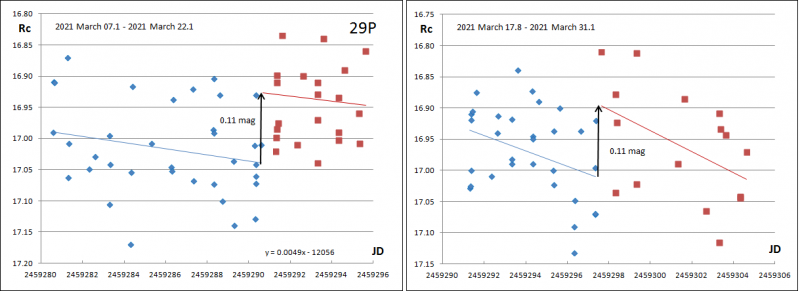
With many dedicated observers following 29P, we get a much more reliable evaluation of small brightness changes even though it is now 17th magnitude. This is a good demonstration of the benefit of having more observers. For the first 11 days of coverage, the intrinsic trend due to varying distance and phase angle is expected to be a fade of 0.018 mag. However on March 17.46 +/-0.28 there looks to have been a step-change of 0.11 mag (red datapoints). This is the smallest mini-outburst that we have detected.
Recent images:
The following two images were taken at almost the same time. The one on the right is unfiltered. You can see extra coma further from the nucleus than can be seen in the r’-filtered image on the left. The reason for this may be that the nucleus has been almost quiescent during the past 30 days with little debris ejected far into space since most of it falls back. So what does escape is gas from sublimating hypervolatile ices and it is the emission lines from the gas that adds to the coma brightness far from the nucleus.
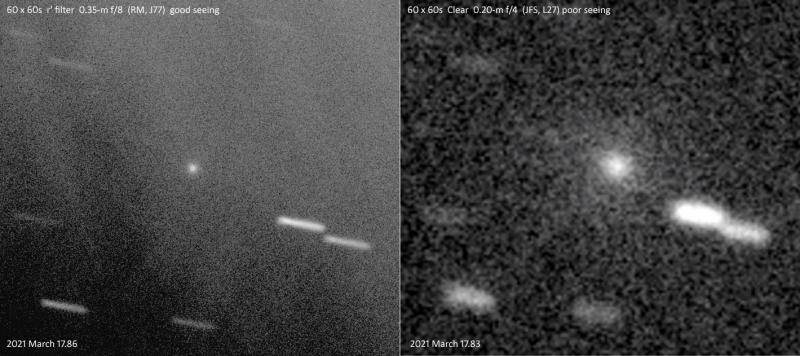
We know that the main gas species is carbon monoxide and most CO+ emission lines appear at wavelengths shorter than the passband of the r’ filter (550-690 nm). Also nitrogen (N2+) emission is mostly at the blue end of the spectrum Unfiltered images should pick up these faint gaseous emissions as can be seen in Jean-François Soulier’s image on the right. In future, using the new MuSCAT3 camera on the FT North, it should be possible to look for colour changes in the coma following weak outbursts. This will be particular so if the comet remains largely quiescent close to opposition.
See plot below also showing how data from several observers monitoring the comet allows us to detect small outbursts. We’ve had a couple of such events as shown in these plots:
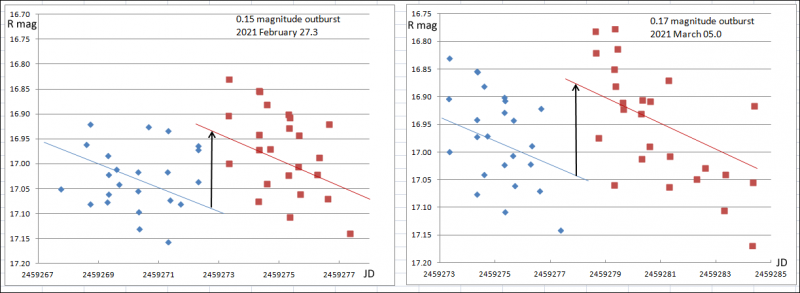
Thanks to Jean-François Soulier (L27, Haute-Provence, France) and Nick James (970, Chelmsford, UK) who independently discovered the comet going into outburst. Thanks to Nick’s timely alert we have obtained the best coverage ever of one of this comet’s outbursts. Here is a plot of the data from L27 showing the outburst lightcurve analysed in terms of the G magnitude using a 10″ radius photometric aperture. A video of this outburst has been prepared by Jean-François.
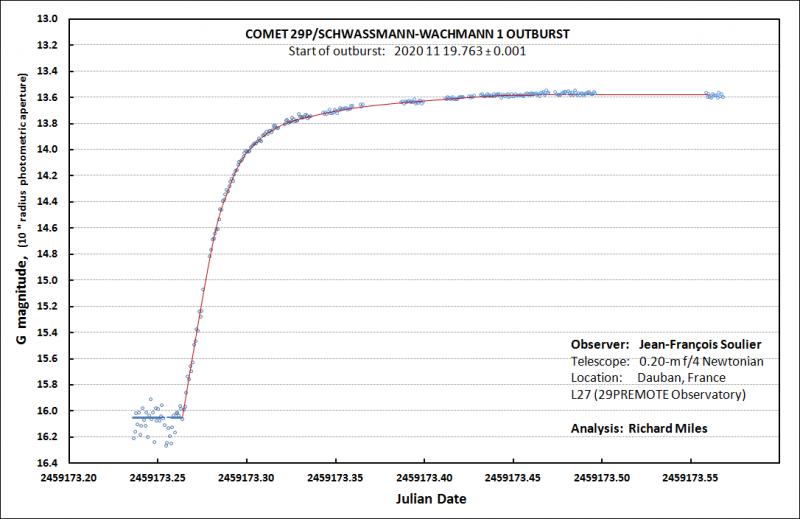
Another outburst also took place less than 6 days later on 2020 November 25.45±0.24 with the magnitude going from 15.3R to 14.3R
29P reached opposition on November 6 and so now appears in the early evening sky making it an excellent target for northern hemisphere observers. Located in Aries at a declination of +24 degrees, the comet is visible for a couple of hours after sunset between now and the end of April.
Here below is the final light-curve for 2020-2021 showing its activity during this apparition up to April 24. Click on the plot if you want to see the full-size image. There have been two very strong outbursts: one on July 26 and a second on November 19, i.e. separated by 2 x 57.9 d in time – Note the link with the nominal periodicity of 57.71 d reported in 2016, strongly indicative of the same source outbursting after two rotations of the nucleus. Minute-by-minute coverage of the November 19 event was achieved largely thanks to Jean-François Soulier’s dedicated 29PREMOTE observatory. More on those findings later. Jean-François was also successful in catching the start of the August 22 event. In all we now have outburst lightcurves spanning the first few critical hours for FOUR events namely in 2017, 2019 and 2020(2).
In addition to strong outbursts, the nucleus has exhibited at least 24 mini-outbursts some of which have been so weak that there have been 5 instances where a large fraction of the ejecta have, after several days, fallen back onto the nucleus. This happens because the nucleus is very large (approx. 64 km across) and so has a relatively high gravity and high escape velocity (approx. 20-25 m/s). Our detailed observations are revealing this collapse of the inner coma – a behaviour unique to this body! We might indeed consider 29P not to be a comet but instead a unique Transition Object that was once a TNO.
Observational data in MPC format
Full archive datasets
Observatory Code / Observer / Location /Instrument / Photometric aperture in arcsec
This list of observatories/people whose work has contributed to the current Observing Campaign between 2014 February and 2022 April. Text shown in red requires checking.
N.B. A complete list of observers contributing this present apparition beginning on 2022 July 16 can be found halfway down this webpage.
203 G. Galli, S. Foglia Italy 0.36-m f/5.76 Schmidt-Cassegrain 5.5
204 L. Buzzi, A. Aletti Italy 0.36-m f/6.5 reflector 4.8/6.0; Italy 0.84-m f/3.5 reflector 5.6
204 L. Buzzi TEL 0.84-m f/3.5 Newtonian reflector, no filter, 5.58″ (3pix)
213 R. Naves, M. Campas Spain 0.30-m f/10 Schmidt-Cassegrain 10.0 square; Spain 0.30-m f/9 Schmidt-Cassegrain 5.4
323 P. Camilleri, J. Oey, R. Miles Australia 0.40-m f/5 reflector (Perth)
718 P. Wiggins Utah, USA 0.35-m f/7 Schmidt-Cassegrain 5.2
970 N. James England 0.28-m f/10 Schmidt-Cassegrain 5.2/5.8 check
A06 E. Cortes Spain 0.25-m f/3.6 Schmidt-Cassegrain 10.0 square
B74 J. M. Bosch Spain 0.40-m f/10 Schmidt-Cassegrain 10.0 square
B96 E. Bryssinck Belgium 0.4-m f/3.8 Astrograph 5.0
C10 J.-F. Soulier France 0.30-m f/3.8 Newtonian 6.5, 4.9
C10 J.-F. Soulier TEL 0.30-m f/3.8 Newtonian reflector, no filter, 4.86″ (3pix) 6.48″ (4pix)
C35 J. Aledo Spain 0.4-m f/3.4 Reflector 10.0 square
C42 Q. Ye (Zwicky Transient Facility) Xingming, China 0.50-m ?
C77 A. Mantero Italy 0.25-m f/4 Reflector 6.7
D09 P.-J. Dekelver Belgium, 0.30-m f/4 Newtonian 4.84″ 4-pix
C90 L. Tremosa Spain 0.30-m f/5 reflector 10.0 square
E94 J. Drummond N.Zealand 0.35-m f/10 Schmidt-Cassegrain 5.9; 0.41-m f/5.2 Newtonian 7.2; 0.41-m f/4.5 Newtonian 6.0
G40 J. Tuten, N. Paul Slooh Canary Isles 0.43-m f/6.8 Dall-Kirkham 5.0
H06 N. James New Mexico 0.43-m f/4.5 5.8; A. Watkins New Mexico 0.43-m f/4.5 5.8; M. Mobberley 0.50-m T11, P. Manteca 0.50-m T11, E. Herman T11
I41 Q. Ye (Zwicky Transient Facility) Palomar, USA 1.20-m f/2.5
I64 A. Jones England 0.19-m f/5.2 Maksutov-Newtonian + Rc filter 5.6
I81 D. Buczynski Scotland 0.35-m f/6 Schmidt-Cassegrain 5.2
I88 J. Carrillo Spain 0.36-m f/5 reflector 10.0 square
J01 J. Gonzalez Spain 0.15-m f/6 Ritchey-Chretien 10.0 square
J22 K. Hills La Palma 0.50-m f/2.9 astrograph 5.9, 10.0 square
J24 J. F. Hernandez Spain 0.4-m f/10 Schmidt-Cassegrain 10.0 square
J38 F. Garcia Spain 0.25-m f/8.1 Ritchey-Chretien 10.0 square
J47 G. Muler Lanzarote 0.30-m Schmdt-Cassegrain 6.1
J69 D. Briggs England 0.30-m f/5.4 Newtonian 6.5
J77 R. Miles England 0.35-m f/8 Schmidt-Cassegrain + r’ 5.4 also V, B, Clear
L27 J.-F. Soulier TEL 0.25-m f/3.5 Newtonian reflector, no filter, 4.48″ (3pix) 5.96″ (4pix)
K01 A. Watkins England 0.35-m f/7.7 Schmidt-Cassegrain 6.2
K02 P. Carson England 0.32-m f/5.4 Dall-Kirkham 5.5/6.5
K14 M. Morales Spain 0.25-m f/5 Newtonian 5.7, 10.0 square
K60 J. Warell, Sweden 0.25-m f/6.1 SCT 5.88 6.30
L27 J.-F. Soulier France 0.25-m f/4 Newtonian reflector 6.0 (6.7)
Q38 M. Mattiazzo Australia 0.28-m f/6.3 Schmidt-Cassegrain 5.5
Q67 P. Camilleri, J. Oey, R. Miles Australia 0.32-m F/8.8 RCOS 5.5
Q68 P. Camilleri, J. Oey, H. Williams Australia 0.30-m f/3.0 reflector 7.4; P. Camilleri, J. Oey Australia 0.34-m f/5.9 SCT
W88 K. Breedlove, J. Tuten, A. Hale Chile 0.35-m f/11 Schmidt-Cassegrain (Slooh) ???
W96 J.-F.Soulier, A.Maury, J.-B. de Vanssay Chile 0.4-m f/5.2 Ritchey-Chretien 6.4
Z08 E. Bryssinck, Oria, Spain 0.70-m f/6 reflector (remote) 5.2 r’
Z09 W. Hawley, England 0.25-m f/10 Schmidt-Cassegrain 5.5
Z08 J. Warell SAAF, Oria, Spain, 0.43-m f/6.8 CDK
Z08 E. Bryssinck, Oria, Spain, 0.7-m f/8 Ritchey-Chretien
Z10 P. Carson, Spain 0.32-m f/5.4 Dall-Kirkham 5.5
Z30 D. Storey, England 0.35-m Ritchey-Chretien 5.9
Z39 A. Acosta, Lanzarote 0.23-m Schmidt-Cassegrain 10.0 square
Z42 J. Savage, England 0.35-m f/7.7 Schmidt-Cassegrain + V 5.5, 7.9
Z74 F. Soldan, Spain 0.20-m f/6.7 Schmidt-Cassegrain 10.0 square
Z80 G. Wells, D. Bamberger, England 0.25-m f/8 Ritchey-Chretien 6.7
Z85 T. Angel, Spain 0.35-m f/11 Schmidt-Cassegrain 5.6
Z92 A. Pratt, England 0.28-m f/3.3 Schmidt-Cassegrain 5.25
XXX C.S. Morris, California, USA 0.406-m f/6.8 Schmidt-Cassegrain 4.84
Las Cumbres Observatory / Faulkes Telescope Project (R. Miles, A. Hale):
A major contribution to this ’24/7′ comet monitoring activity have been the observations from the Las Cumbres Observatory global network of telescopes. Access to this network has been made available thanks to the Dill Faulkes Education Trust, and to Dr Paul Roche of the Faulkes Telescope Project based at Cardiff University, Wales assisted by Alison Tripp.
E10 coj 2m0a Siding Spring-FT South 2.0-m f/10 Ritchey-Chretien 5.4
F65 ogg 2m0a Haleakala-FT North 2.0-m f/10 Ritchey-Chretien 5.4
K91 cpt Sutherland A S. Africa 1.0-m f/8 Ritchey-Chretien 5.5
K92 cpt Sutherland B S. Africa 1.0-m f/8 Ritchey-Chretien 5.5
K93 cpt Sutherland C S. Africa 1.0-m f/8 Ritchey-Chretien 5.5
Q63 coj Siding Spring A Australia 1.0-m f/8 Ritchey-Chretien 5.5
Q64 coj Siding Spring B Australia 1.0-m f/8 Ritchey-Chretien 5.5
V37 elp McDonald Observatory A Texas, USA
Note that one orbit of the Sun earlier a very roughly similar pattern was evident.
N.B. Mini-outbursts are largely shown in red/pink.
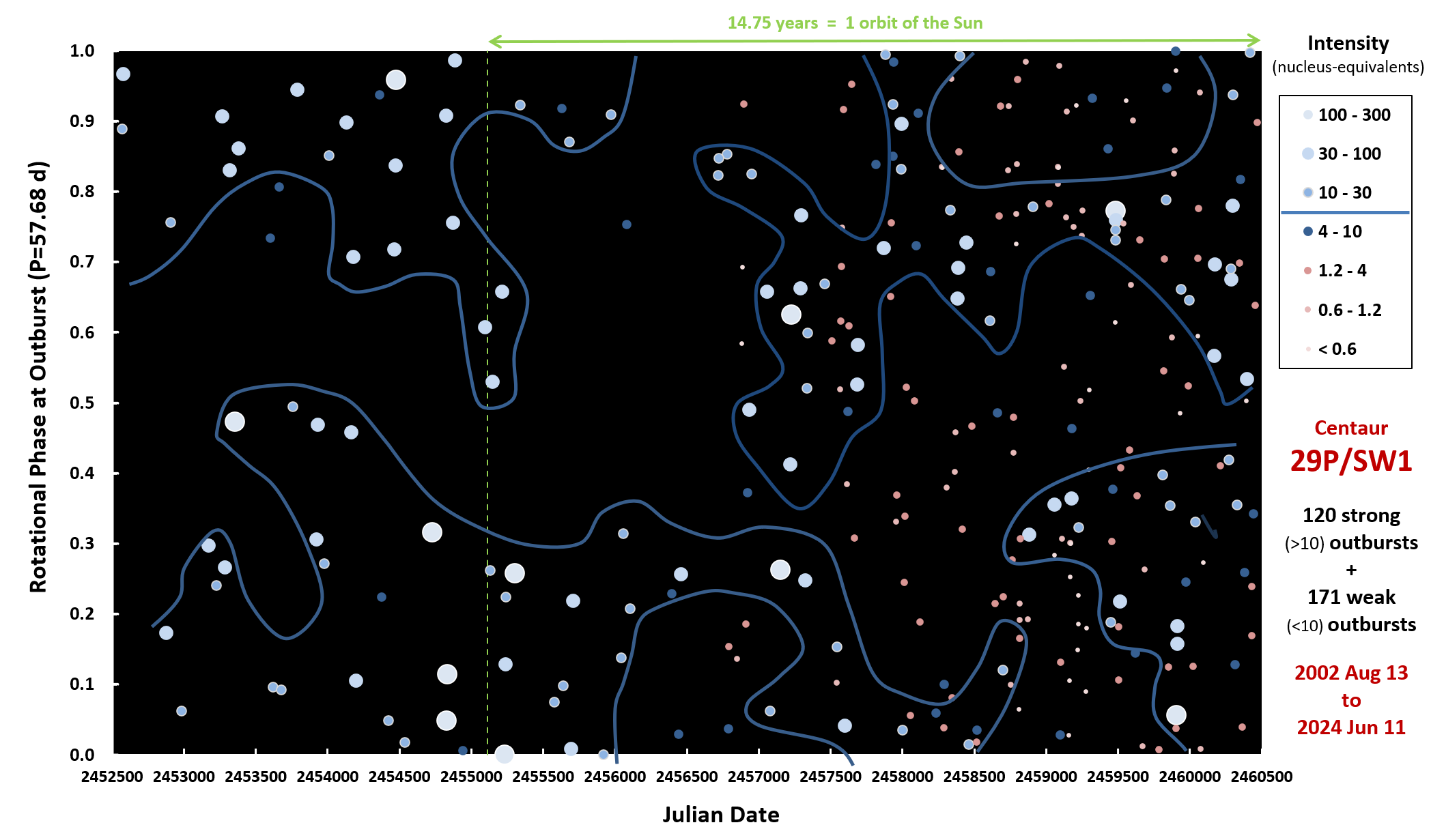
| The British Astronomical Association supports amateur astronomers around the UK and the rest of the world. Find out more about the BAA or join us. |

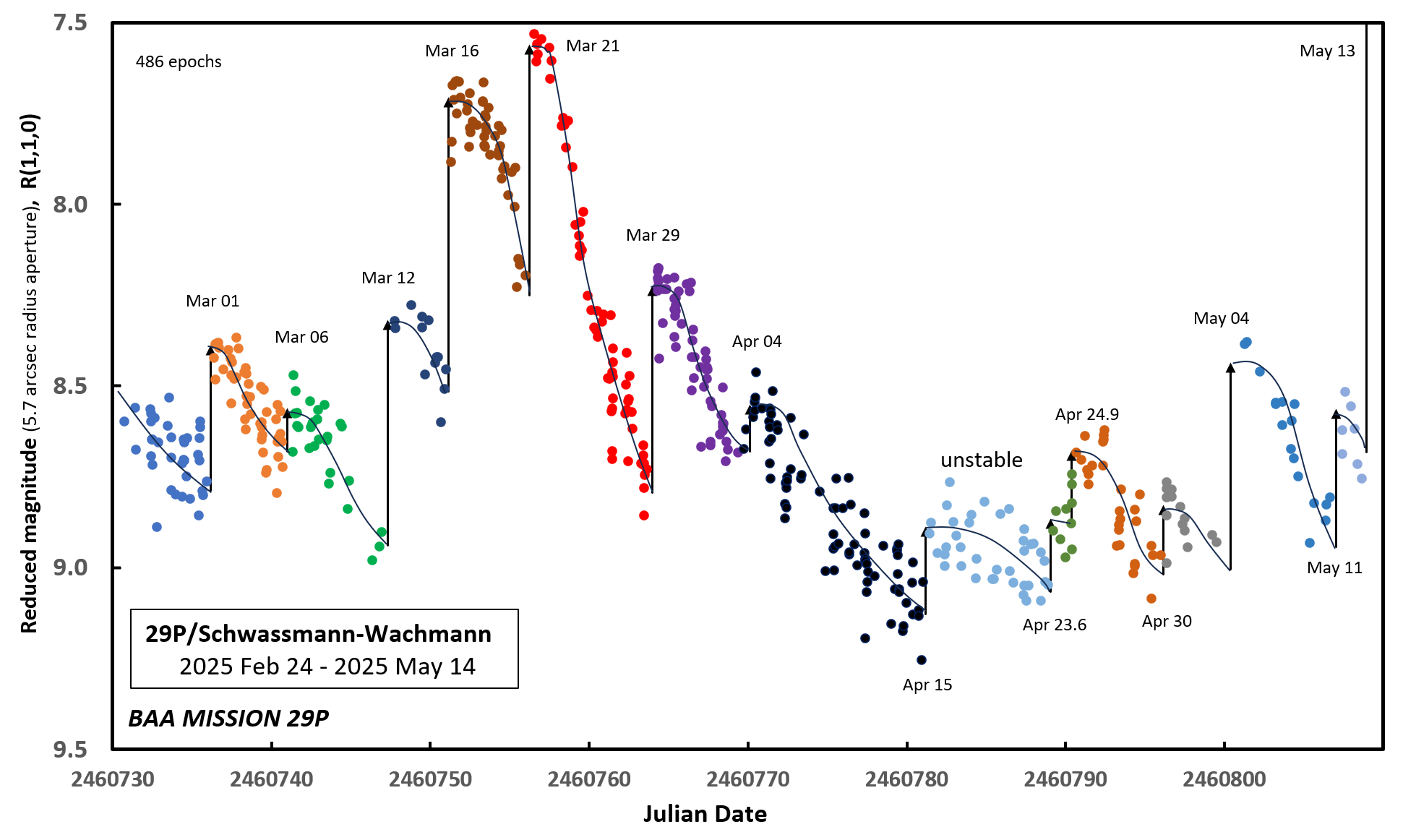
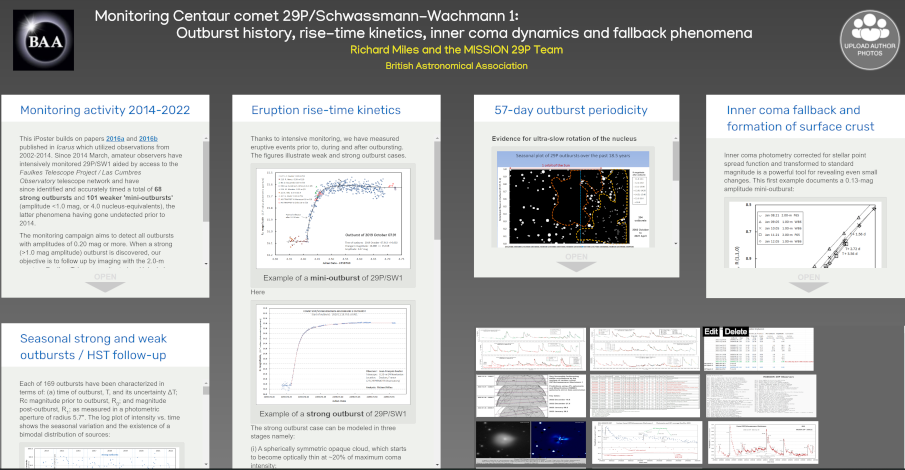 2022
2022 